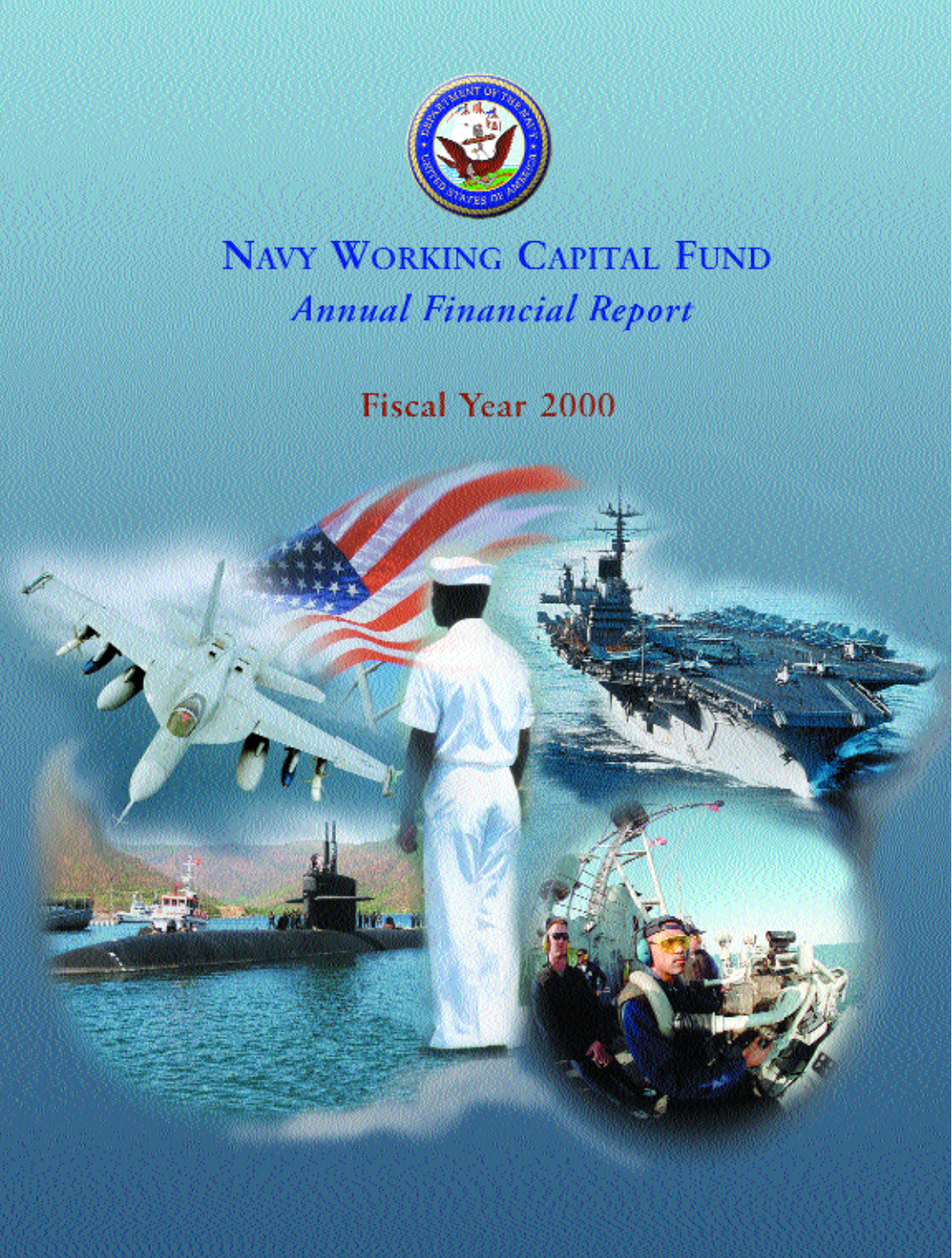

Navy Working Capital Fund
Fiscal Year 2000

NAV Y WO R K I NG CA P T I A L FU N D
Table of Conte n t s
Table of Contents
Overview
1
Principal Statements
27
Notes to the Principal Statements
35
Supporting Consolidating/Combining Statements
77
Required Supplementary Information
95
Other Accompanying Information
107
Audit Opinion
109

NAV Y WO R K I NG CA P T I A L FU N D
Overview
Department of the Navy
Navy Working Capital Fund

Background
The Navy Working Capital Fund (NWCF) is
comprised of activities, or business areas, that
provide goods and/or services that support the
missions and objectives of the Department of
the Navy (DON), and the Department of
Defense (DoD), and operate under business
financial management principles in a buyer-and-
seller approach. To be included in a Working
Capital Fund, a business activity must meet four
criteria:
The business operations of the activity
must produce identifiable outputs,
either goods or services, that serve
Military Department or Defense
Agency requirements.
The activity must have an accounting
system capable of collecting the costs
of production and assigning these
costs to the appropriate outputs.
The activity must be able to clearly
identify its customers and to align its
resources to best meet the
requirements of these customers.
The activity must have evaluated the
advantages and disadvantages of the
buyer-seller relationship; and assessed
the customer’s ability to influence the
activity’s cost by changing demand.
1.
2.
3.
4.
1
NAV Y WO R K I NG CA P T I A L FU N D
O ve rv i e w
Navy Working Capital Fund
History of the Navy Working Capital Fund
The Navy Working Capital Fund (NWCF) is
one of four Defense Working Capital Funds
(DWCFs):
• Army Working Capital Fund
• Navy Working Capital Fund
• Air Force Working Capital Fund
• Defense-wide Working Capital Fund
The basic concept of working capital funds
evolved from a dual categorization of funds: Stock
Funds and Industrial Funds. Stock Funds, used by
the Navy since the 1870’s, dealt with procuring
materials in volume from commercial sources and
holding an inventory for subsequent sale to
customers. Industrial Funds, used by the Navy
since the 1940’s, provided industrial and
commercial goods and services such as depot
maintenance, transportation, and research and
development. The National Security Act
Amendments of 1949 authorized the Secretary of
Defense to establish revolving funds as the
business model for the operation of these funds.
In FY 1992, the Department of Defense (DoD)
consolidated the multiple stock and industrial
funds throughout the service into one Defense
Business Operations Fund (DBOF), centrally
managed by the Office of the Under Secretary of
Defense (Comptroller) (USD(C)). The primary
goal of the DBOF was to focus the attention of
DoD management on the total costs of certain
common DoD business operations.
In FY 1995, the central cash management
function assumed by USD(C) was returned to the
DoD component level providing activity group
managers control of and accountability for their
operations. In FY 1997, the DBOF was
reorganized into the current DWCF structure to
clearly establish the components’ overall
responsibility for managing and operating their
respective working capital functions.

NAV Y WO R K I NG CA P T I A L FU N D
2
FY 2000
Overview
Unique Features of the
NWCF
Organizational Structure
The Principal Statements included in this
annual financial report present the
consolidated financial position and results of
operations for all the activities included in the
NWCF. To provide the reader with a more
complete understanding of the NWCF, these
activities are segregated by their respective
business areas in the supporting
consolidating/combining financial statements.
These activity groups include:
Depot Maintenance: The NWCF activities
include the Depot Maintenance function for
the Shipyards, Aviation, and the Marine Corps.
Each Depot Maintenance function is presented
separately in the supporting consolidating/
combining financial statements.
Transportation: The Military Sealift Command
provides the transportation services required
to maintain the Navy’s global position and
infrastructure. On the supporting
consolidating/combining statements, the
financial position and the results of the
operations of the Military Sealift Command
are shown in the Transportation activity group.
Base Support: The daily operations of the
today’s Navy require a solid infrastructure
supporting its global presence. The Naval
Facilities Engineering Service Center and the
Public Works Centers support the daily
operations of the Navy, and are included in the
Base Support activity group in the supporting
consolidating/combining financial statements.
Information Services: In the twenty-first
century, the electronic infrastructure of the
Navy is supported in the NWCF by the Navy,
Fleet Material Support Office, the Naval
Computer and Telecommunications Centers,
and the Naval Reserve Information Systems
Office. The financial position and the
operating results of these activities are grouped
together and presented as the Information
Services activity group in the supporting
consolidating/combining financial statements.
Research and Development: The development
of the tools and technology of the Navy of
tomorrow is supported in the Research and
Development activity group of the NWCF.
The Naval Surface Warfare Center, the Naval
Air Warfare Systems Center, the Naval
Undersea Warfare Center, the Naval Research
Laboratory, and the Space and Naval Warfare
Centers are included in the Research and
Development activity group in the supporting
consolidating/combining financial statements.
Supply Management: The challenge of
providing our global Naval forces with high-
quality goods and supplies is met by the Supply
Management activities. Supply Management -
Navy, and Supply Management - Marine Corps
are the two activities combined in the Supply
Management activity group presented in the
supporting consolidating/combining financial
statements.
In addition to the activity groups reporting
the FY 2000 cost of operations, the NWCF
financial statements also reflect the residual
financial activity associated with the Ordnance
Activity Group, which was transferred to the
Department of the Navy General Fund and
the Department of the Army Working Capital
Fund effective 1 October 1999. The
Combining/Consolidating Statements also
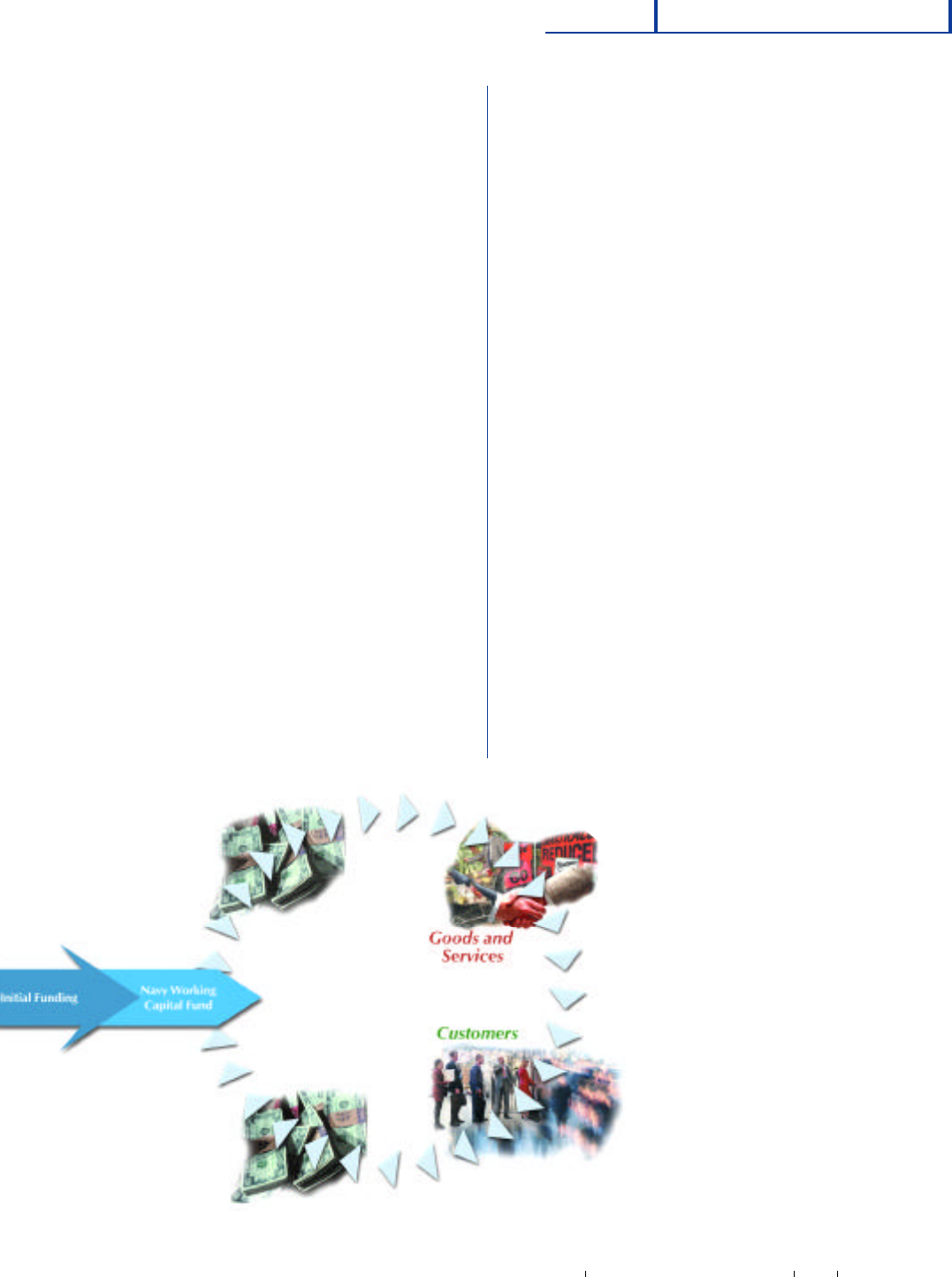
3
NAV Y WO R K I NG CA P T I A L FU N D
O ve rv i e w
Navy Working Capital Fund
show the Component level reporting activity.
The Component Level is not an operational
activity unit or group, but is rather an
administrative reporting mechanism used to
reflect transactions that are not readily
identifiable with a single activity or activity
group. Historically, the Component Level
reflects transactions related to disbursements,
collections, and department-level adjustments
for certain eliminating entries.
Sources of Funding
The funding of the NWCF is based on a
revolving-fund concept of operations, under
which the NWCF activities received their initial
working capital through an appropriation or
through a transfer of resources from existing
appropriations of funds and used those
resources to finance the initial cost of products
and services. Financial resources to replenish
the initial working capital and to permit
continuing operations are generated by the
a c c e ptance of customer orders.
Customer Orders
Customer orders accepted by the NWCF
activities must be either obligations of a
federal government activity or cash advances
from non-federal government customers.
The acceptance of a customer order creates
a quasi-contractual relationship between the
NWCF activity and its customer.
In FY 2000, the customer orders placed
with the NWCF activities included those
initiated by:
1. DON Commands and Activities
2. Other Military Departments
3. Other DoD agencies
4. Non-DoD federal government agencies
5. Others not officially representing the
federal government.
The customers of each NWCF activity are
responsible for budgeting for and budgetary
control of the cost of end products and
services ordered from the NWCF activity. The
customer cannot use its appropriated funds to
do indirectly (through the NWCF activity)
what it is not permitted to do directly.
The availability of an appropriation
cannot be expanded or
otherwise changed by transfer
to the NWCF. The customer
bears the primary
responsibility for the
determination of the
applicability of its
appropriated funds in
the orders placed with
the NWCF activity.
Stabilized Rates
One of the features of the
NWCF that allows its customers to
accurately plan and budget their

NAV Y WO R K I NG CA P T I A L FU N D
4
FY 2000
Overview
appropriated funds for NWCF support
requirements is the rate stabilization policy
adopted by the NWCF. For each budget year,
the NWCF establishes customer rates on an
end product basis whenever feasible. These
rates are set at levels estimated to recover the
cost of products or services to be provided.
This “stabilized rate” policy protects
appropriated fund customers from unforeseen
cost changes, and also minimizes fluctuations
in planned NWCF work levels, permitting a
more effective use of NWCF resources.
In conjunction with the stabilized rate policy,
the NWCF uses a cost recovery—or break-
even—policy. With stabilized rates, gains or
losses in operations may occur as a result of
variations in program execution. To maintain
full cost recovery and thereby to break even
over the long term, NWCF activities generally
adjust their rates each year to reflect such
realized gains and losses.
For the Supply Management activity group,
customer rates are established using
commodity costs in conjunction with a cost
recovery factor that recovers such costs as
transportation and certain personnel costs.
The other NWCF activity groups customer
rates are established on the basis of unit cost
rates established based on the identified unit
of output. These unit cost rates incorporate
the recovery of costs, and prior year gains
and losses.
Budget Execution
During budget execution, activity groups
calculate the difference between the amount of
revenue collected from customer orders and
the actual cost of meeting customer demands,
and record either a positive or negative
Operating Result. The revenue collected from
customers for orders placed and the costs
incurred to fill those orders differ from the
earned revenue and the program costs and the
earned revenue appearing in the Consolidated
Statement of Net Cost included in the
accompanying financial statements. Within the
Consolidated Statement of Net Cost, the
Program Cost and Earned Revenue have been
adjusted to support intragovernmental
elimination-entry requirements.
T
he term “end product” refers to the item or service requested
by the customer (output) rather than to the processes or other
inputs required to achieve of the requested output (for example,
the product requested rather than the direct labor hours
expended in the achievement of that product).

5
NAV Y WO R K I NG CA P T I A L FU N D
O ve rv i e w
Navy Working Capital Fund
NWCF Activity Groups
The NWCF is comprised of activity groups with
a variety of missions, resources, and capabilities
to address the Navy and other customer’s
specialized needs. Two major changes have
occurred in the activity group structure since
FY 1999. The first change entailed the transfer
of the Ordnance activity group to the
Department of the Navy General Fund and the
Department of the Army Working Capital Fund,
effective 1 October 1999. The financial
information presented for the Ordnance
activity group reflects the residual accounting
data related to operations conducted prior to
September 30, 1999. The second change was
the transfer of financial accountability for the
Naval Computer and Telecommunications
Station from the Information Services activity
group to the Research and Development
activity group’s Space and Naval Warfare
Systems Center, effective 1 October 2000 (FY
2001). The organizational structure of the
NWCF for FY 2000 is illustrated below:
Depot Maintenance - Shipyards
The mission of Depot Maintenance – Shipyards
is to provide logistic support for ships and
service craft; to perform construction, overhaul,
repair, alteration, dry-docking, and outfitting
of ships and craft; to per form design,
manufacturing, refit, and restoration; and to
provide services and material to other activities
and units as required.
The Depot Maintenance-Shipyards activity
group operates three regional shipyards:
Portsmouth Naval Shipyard’s primary mission
is the overhaul, repair, modernization, and
refueling of Los Angeles Class nuclear-powered
submarines. Located in Portsmouth, NH, this is
the Navy’s most experienced shipyard in
submarine design, construction, modernization,
and maintenance. The shipyard is currently
diversifying into deep ocean submersibles and
special operations, and additionally serves as
The destroyer USS Arthur W. Radford (DD 968),
undergoing repairs at Norfolk Naval Shipyards.

Overview
NAV Y WO R K I NG CA P T I A L FU N D
6
FY 2000
Operating Results
The three NWCF Naval Shipyards exceeded
budgeted Operating Results as a result of
increased workload and fixed price gains. This
positive Operating Results performance has
allowed the implementation of the quarterly
surcharge policy. This is the first time a DoD
Activity has implemented this policy to reduce
costs to the customer, and has resulted in
freeing $32.1 million for their customer,
CINCPACFLT, to reprogram in accordance
with its mission objectives.
Depot Maintenance - Aviation
The mission of Depot Maintenance – Aviation is
to provide responsive worldwide maintenance,
engineering, and logistics support to the Fleet
and to maintain the essential industrial
capability to support mobilization. The activity
group must repair aircraft, engines, and
components and manufacture parts and
assemblies; provide engineering services in
the development of hardware design changes;
and furnish the technical and other professional
services to resolve maintenance and
logistics problems.
The mission of Depot Maintenance - Aviation is
supported by three modern industrial facilities
commissioned by the Navy to perform in-depth
overhaul, repair, and modification of aircraft,
engines, and aeronautical components.
Although these depots share a common
mission, each location specializes in
particular aircraft, engines, components, and
support programs.
the planning yard for the Navy’s deepest diving
submarine and submersible and for other
scientific research, defense prototype testing,
and submerged rescue platforms.
Norfolk Naval Shipyard is the largest of the
Navy Shipyards.This shipyard, located in
Portsmouth, VA, operates seven dry docks and
about 400 cranes. In addition to its ship-work,
the Norfolk Naval Shipyard also serves as the
East Coast cryptographic repair depot which
repairs, modifies, overhauls, certifies and
installs cryptographic equipment, and as a
depot-level antenna repair facility and range site
that removes, restores, tests, and reinstalls
Information Delivery Devices (IDD), Automatic
Carrier Landing Systems (ACLS), and navigation
and surface/air search antennas.
Puget Sound Naval Shipyard is the Pacific
Northwest’s largest Naval shore facility and the
largest shipyard on the West Coast. Located in
Bremerton, WA, the shipyard has pioneered an
environmentally safe method of deactivating
and recycling nuclear-powered ships, making
the U.S. Navy the world’s only organization
able to design, build, operate, and recycle
nuclear-powered ships. Approximately 30
percent of the shipyard’s workload involves
the inactivation, reactor compartment disposal,
and recycling of ships.
T
he Portsmouth Shipyard celebrated its
bicentennial in FY 2000, having been
established by the Secretary of the Navy on
June 12, 1800. The Honorable Richard
Danzig, Secretary of the Navy, provided the
keynote address for this anniversary.
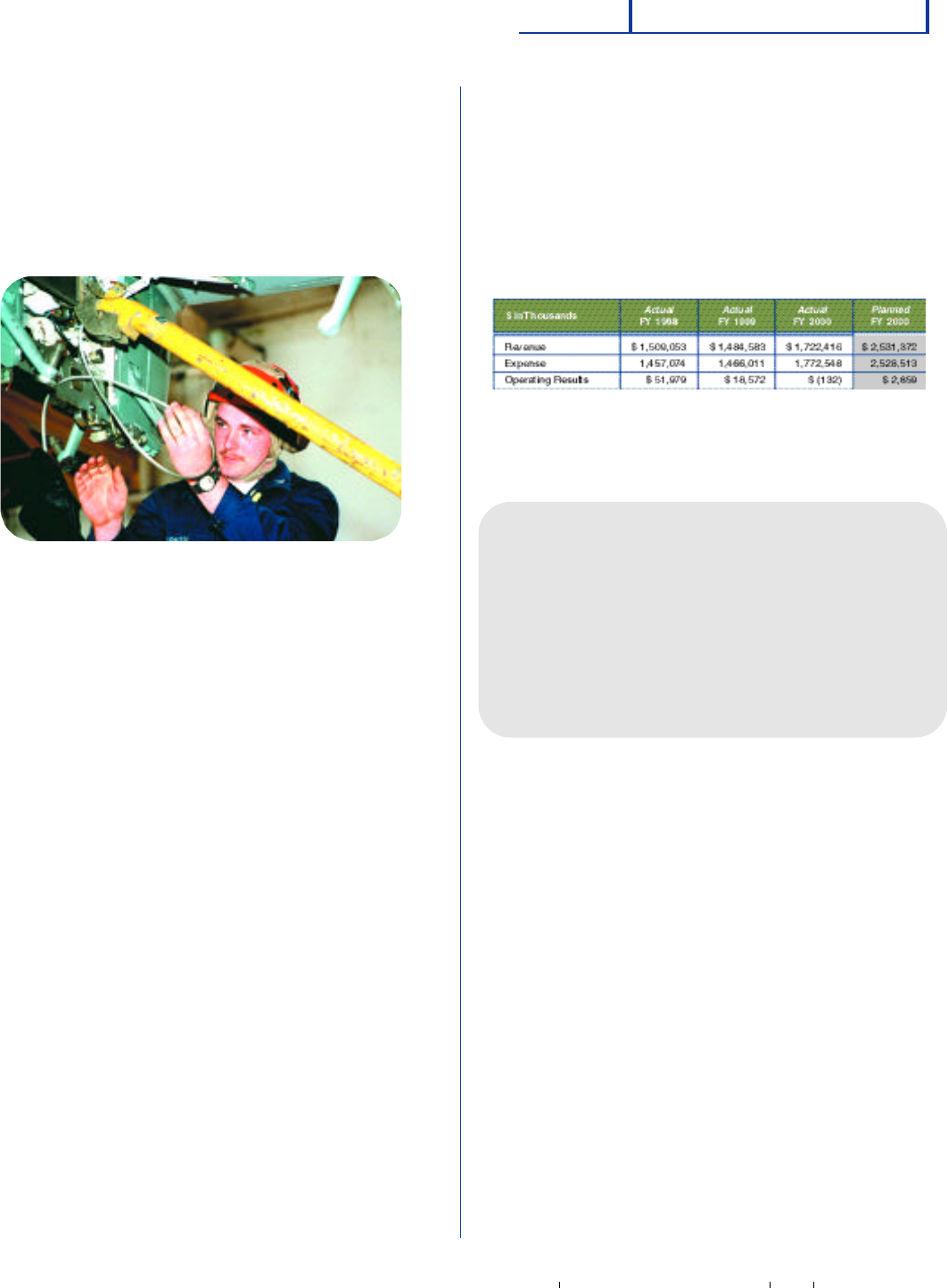
7
NAV Y WO R K I NG CA P T I A L FU N D
O ve rv i e w
Navy Working Capital Fund
NAVANDEPOT Cherry Point, NC: The only
facility of its kind under the management of
Marine Corps officers, this facility includes the
AV-8B Harrier, the vertical takeoff and landing
tactical attack jet flown by the Marines, among
its specialties.
NAVANDEPOT Jacksonville, FL: A number of
carrier battle group aircraft, such as the F-14
Tomcat, the F/A-18 Hornet, and the EA-6B
Prowler, are kept in the air through the
dedication of the Jacksonville facility.
NAVANDEPOT North Island, CA: In addition
to supporting the F/A-18 Hornet, this facility in
San Diego supports the E-2 Hawkeye, the C-2
Greyhound, and the S-3 Viking, helping the
Navy to keep technical aircraft superiority.
Operating Results
There are several operational and financial
system sources for the variance between the
actual and planned Operating Results for
Depot Maintenance - Aviation. The planned
result anticipated full implementation by
September 2000 of a new completion
methodology for revenue recognition, but
successful transition to this methodology was
not achieved by all of the programs engaged in
the changeover. Other factors contributing to
this variance include the component program,
where physically completed units (G-condition
units) were not billed; funding shortfalls; and
delays in aircraft, engine, and other support
and manufacturing programs.
Marine Corps Depot Maintenance
Activity Group
The mission of the Marine Corps Depot
Maintenance Activity Group (DMAG) is to
provide quality, responsive maintenance and
maintenance-related products and services to
the Fleet Marine Force (FMF) and other
customers while maintaining the core industrial
base necessary to support mobilization and
surge requirements.
The Marine Corps DMAG consists of two
Multicommodity Maintenance Centers, located
in Albany, GA and Barstow, CA. The two
centers return unserviceable equipment to
serviceable condition, perform maintenance up
to the depot repair level, and overhaul, rebuild,
and modify all types of ground combat and
combat support equipment used by the
Marine Corps and other DoD services.
The Marine Corps DMAG performs work for all
Components of the Department of Defense.
The primary customer of the group is the
Marine Corps, whose requirements originate
from the Life Cycle Management Center and
the Fleet Support Division, Marine Corps Logist i c s
Bases in Albany, GA and Barstow, CA.
An Aviation Electronics Technician positions the cable that will hoist
a MK62 mine onto the P-3’s bomb rack at the Naval Air Station,
Jacksonville.
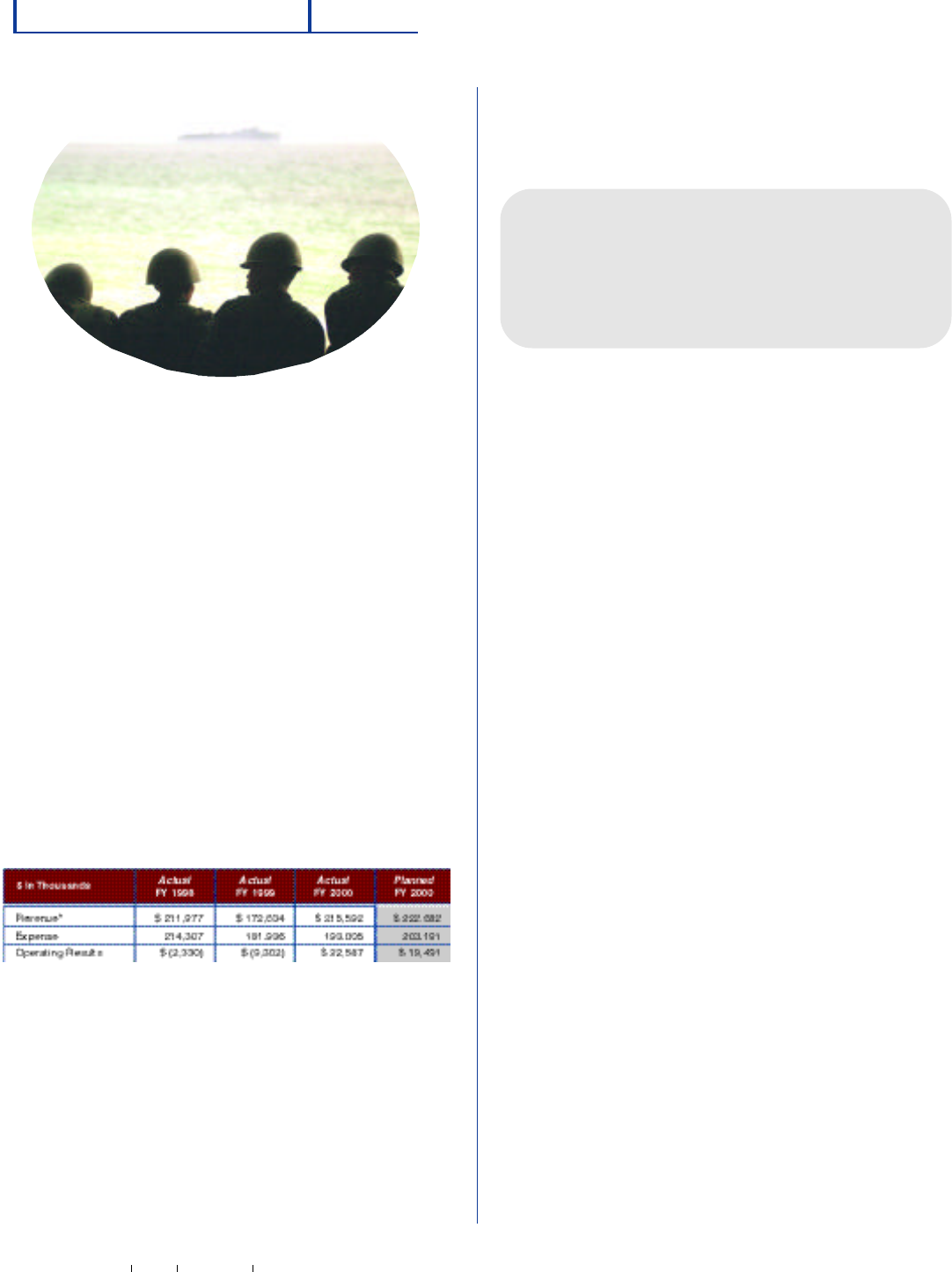
Overview
Transportation
Military Sealift Command
The mission of the Military Sealift Command is
to provide efficient sea transportation, combat-
ready logistics forces, and reliable special mission
ships for the Department of Defense in times of
peace and war.
The Military Sealift Command (MSC) has dual
reporting responsibilities to the DON and to
the U.S. Transportation Command
(USTRANSCOM).
MSC supports three business lines:
Afloat Prepositioning Ships – Navy (APF-N)
place U.S. Marine Corps, Army, and Air Force
equipment in strategic locations around the
world, such as the Mediterranean Sea and
Persian Gulf, and are key in keeping the U.S.
military forward-deployed.
Special Mission Ships (SMS) work with
scientific and military commands to expand
knowledge of the world’s oceans, combat
drug smuggling, monitor international
compliance with strategic arms treaties, and
lay submarine cable.
Naval Fleet Auxiliary Force (NFAF) ships
support the Navy around the world, providing
everything from fuel to food to ammunition
and towing services. NFAF ships keep the
Navy’s combatants at sea, on station, and
combat-ready.
NAV Y WO R K I N G CA P T I A L FU N D
8
FY 2000
Operating Results
Operating Results increased $31.9 million in
FY 2000, as compared to the actual Operating
Results recorded in FY 1999. Although
revenue was $7.1 million lower than plan;
Operating Results exceeded plan by $3.1
million, or 15.9%. The reduction of costs
resulted from intense management efforts to
control costs within the Maintenance Centers
and the stabilized rates established to recover
operating expenses and to offset prior years
unbudgeted operating losses.
A group of Filipino Marines wait for an armored assault vehicles
to come ashore from USS Mount Vernon (LSD 39). Filipinos
and U.S. Marines will work together to defend and assault the
beach in Ternate, Philippines.
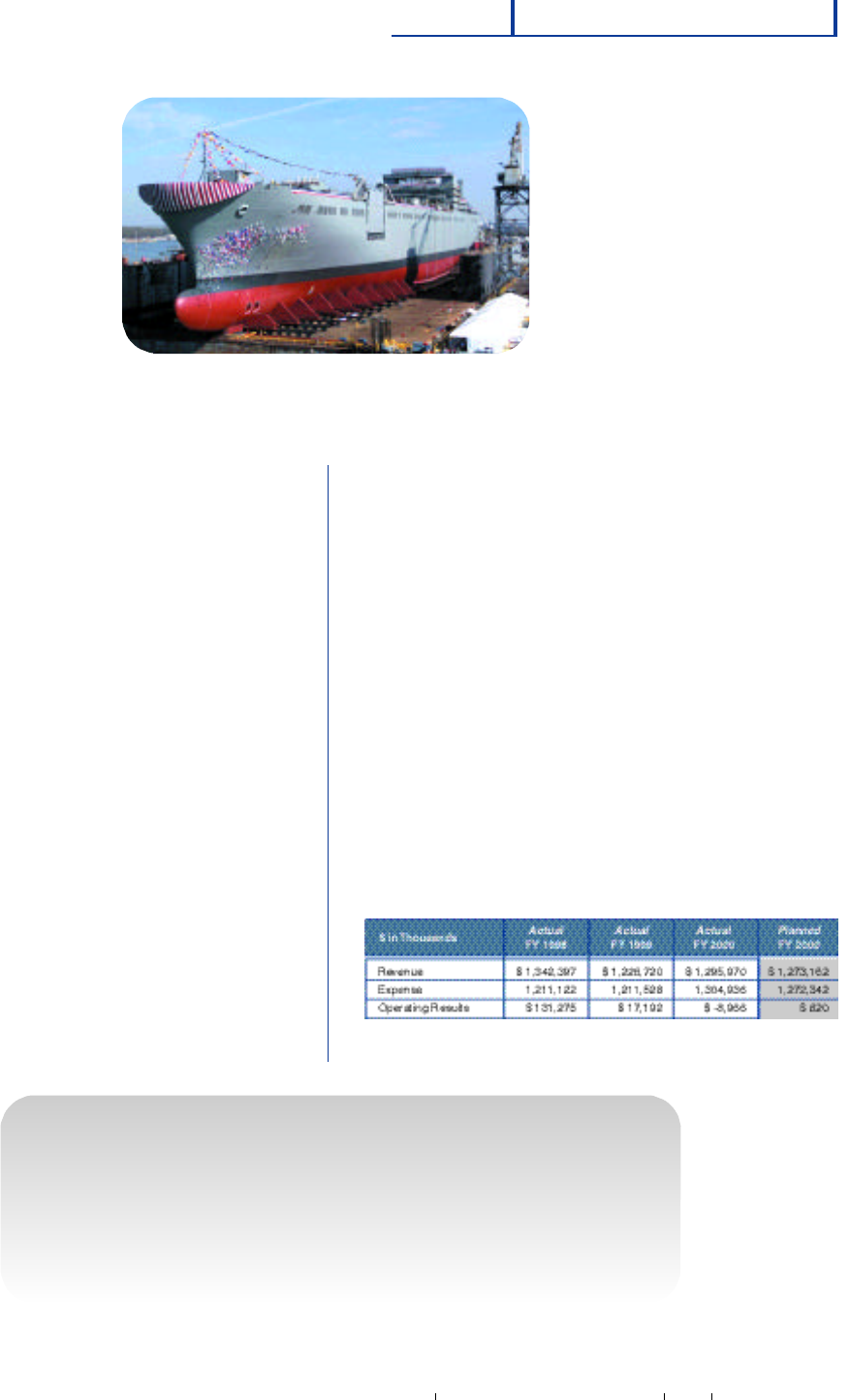
9
NAV Y WO R K I NG CA P T I A L FU N D
O ve rv i e w
Navy Working Capital Fund
All MSC ships are crewed
by civil service or contract
merchant mariners, freeing
active duty sailors for more
traditional war-fighting
assignments.
The heavy lift ship MV Blue
Marlin, under contract with
MSC, transported the
damaged Navy destroyer
USS Cole from the Gulf of
Aden to the United States
for repairs. (The 505-foot USS Cole survived a
terrorist attack that left a
40-by-40-foot hole in her port side and 17 U.S.
Sailor casualties.)
The organization of MSC is geographically
diverse, to support the needs
of its widespread customer base:
MSC Headquarters is located in Washington,
D.C., with the mission to administer and direct
MSC resources to meet the needs of its global
customer base.
MSC Europe is located in Naples, Italy, serving
customers based in the European theater.
MSC Far East is located in Yokohama, Japan,
serving MSC customers based in Japan and
along the Pacific Rim.
MSC Pacific is located in
San Diego, CA, providing
support throughout
Southern California and, in
conjunction with MSC
Pacific in Alameda, CA, to
customers in Northern
California.
MSC Atlantic is situated in
Camp Pendleton, VA,
sponsoring representatives
in Puerto Rico and New Orleans in support of
the MSC customer base in the Gulf of Mexico,
the Caribbean, and Puerto Rico.
MSC Central, established in FY 2000 in
Manama, Bahrain, provides direct support to
the Navy’s Fifth Fleet Commander in theater.
Operating Results
The congressional budget reflected planned
Operating Results of $.8 million, but the actual
expenses exceeded the revenue reported for
FY 2000 by $8.9 million, resulting in Operating
Results at $9.8 million less than planned.
M
SC has saved taxpayers $30 million since the 1993
inception of its Afloat Residual Asset Management
System (ARAMS) for the allocation of ship parts. MSC received
the Hammer Award for this innovative, cost-saving program.
Military Sealift Command Cargo Ship Three Zero Four
(T-AKR 304) is of ficially christened Pililaau in honor of Medal
of Honor recipient Private First Class Herbert K. Pililaau.
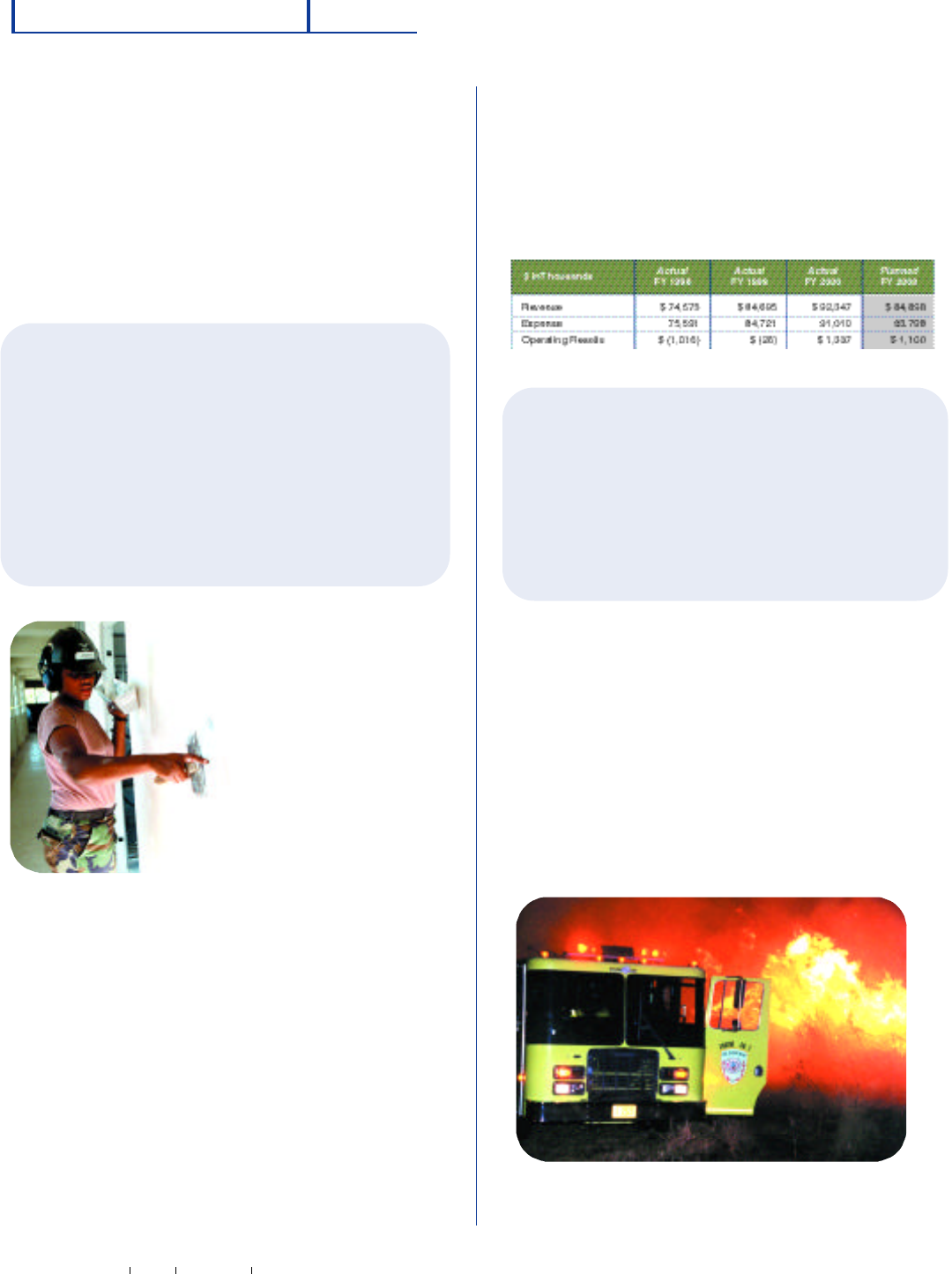
Overview
NAV Y WO R K I NG CA P T I A L FU N D
10
FY 2000
NFESC also provides engineering, design,
construction, consultation, test and evaluation,
technology implementation, and management
support services.
Operating Results
Public Works Centers
The Public Works Centers provide utilities
services, facilities maintenance, family housing
services, transportation support, and
engineering services, in addition to the shore
facilities planning support required by operating
forces and other activities.
The Public Works Centers (PWCs) provide
utilities and transportation support; major
maintenance of buildings and structures,
grounds, streets, walks, and parking lots;
janitorial, refuse collection and disposal and
pest control services; and engineering and
facilities inspection functions. These products
and services are provided in-house or through
contracts awarded and administered by PWC.
Base Support
The Naval Facilities Engineering Service Center
and the Public Works Centers are the activities
that provide the infrastructure necessary to
support the global operations of Naval forces.
In FY 2000, these activities accounted for 8.5
percent, or $1.7 billion, of total NWCF revenue.
Naval Facilities Engineering Service Center
The Naval Facilities Engineering Service Center
(NFESC) provides engineering, design,
construction, technology implementation,
and management support worldwide to shore,
ocean, and waterfront activities and to
amphibious and expeditionary operations.
The center also provides environmental,
energy, and utility services.
Located in Port
Hueneme, CA, the
Naval Facilities
Engineering Service
Center (NFESC) was
established when
the missions of six
components of the
Naval Facilities
Engineering
Command were
consolidated for
greater efficiency.
NFESC operates specialized engineering and
technology facilities, working in partnership
with its customers to deliver products and
services in the four areas of:
• Shore, Ocean, and Waterfront Facilities
• Environment
• Amphibious and Expeditionary Operations
• Energy and Utilities
A builder 3rd Class plasters a wall
inside the Bundy Barracks at NAS
Roosevelt Roads, Puerto Rico.
The Guam Fire Department battles a roaring fire, one of the 43
it battled in a single, record-breaking day.
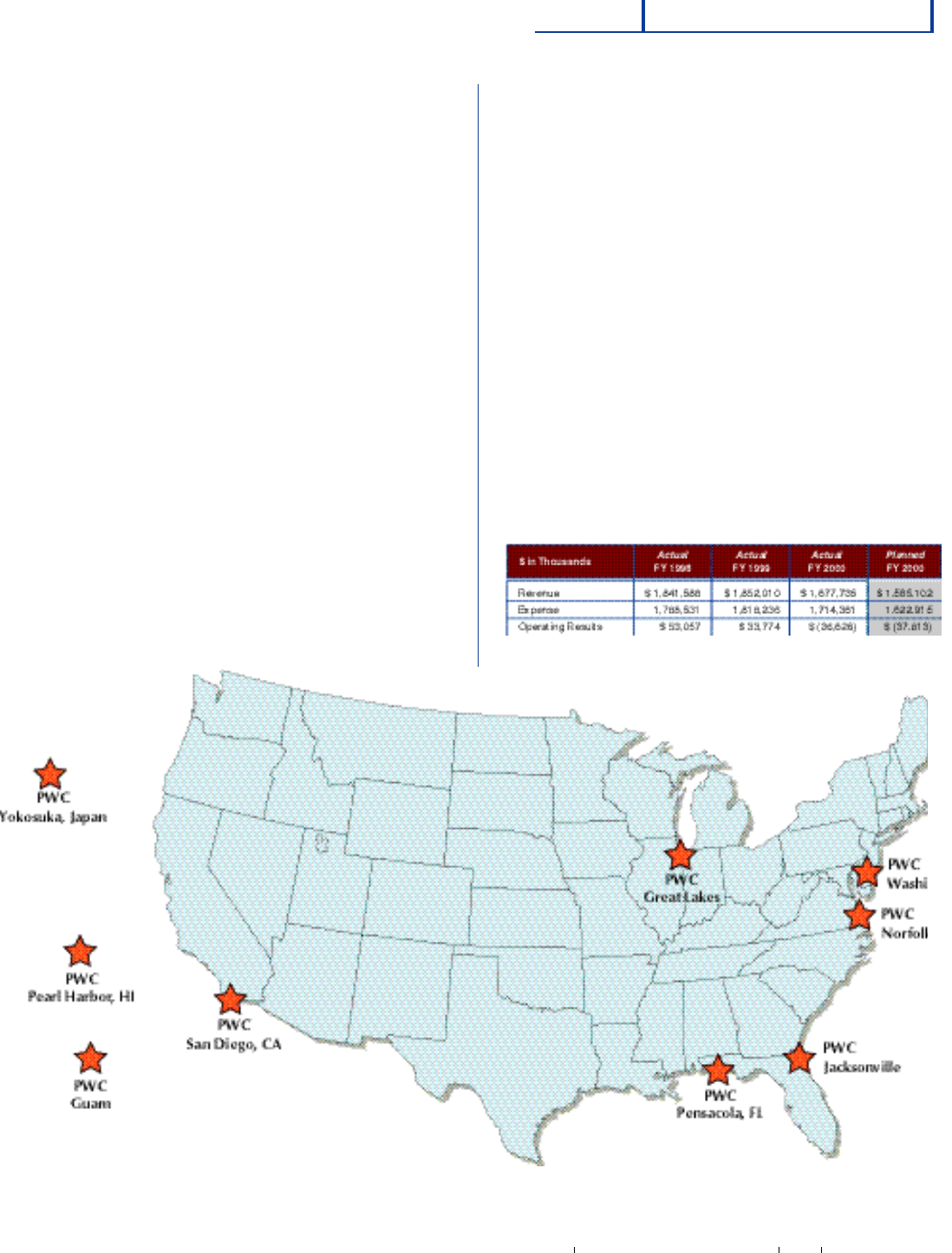
A presidential commission in 1947
recommended that, where possible,
government industrial-type activities should
consolidate. The Navy followed this direction
in 1948 by successfully setting up its first PWC
in Norfolk, VA. Nine other PWCs, consolidating
more than 80 public works departments, were
established as follows:
- 1952 Pearl Harbor, Hawaii
- 1958 Guam
- 1963 Pensacola, Florida
- 1965 Great Lakes
- 1965 Yokosuda, Japan
- 1974 San Francisco, California
- 1992 Washington, D.C.
- 1992 Jacksonville, Florida
11
NAV Y WO R K I N G CA P T I A L FU N D
O ve rv i ew
Navy Working Capital Fund
On 7 April 2000, PWC Guam transferred all
operational functions to Raytheon Technical
Services Guam (RTSG), reducing its rolls as a
consequence from 732 to 105 civilian
employees. The transfer was made under the
terms of a Base Operating Services (BOS)
contract decreed as a result of an A-76/
Commercial Activities (CA) decision.
Operating Results
Revenues and expenses were both above plan
in FY 2000, producing a net operating result
$1.2 million above plan. Key contributing
factors to this variance were the increased cost
of electricity purchased at PWC San Diego
and the conversion of PWC Guam to a
BOS contract.
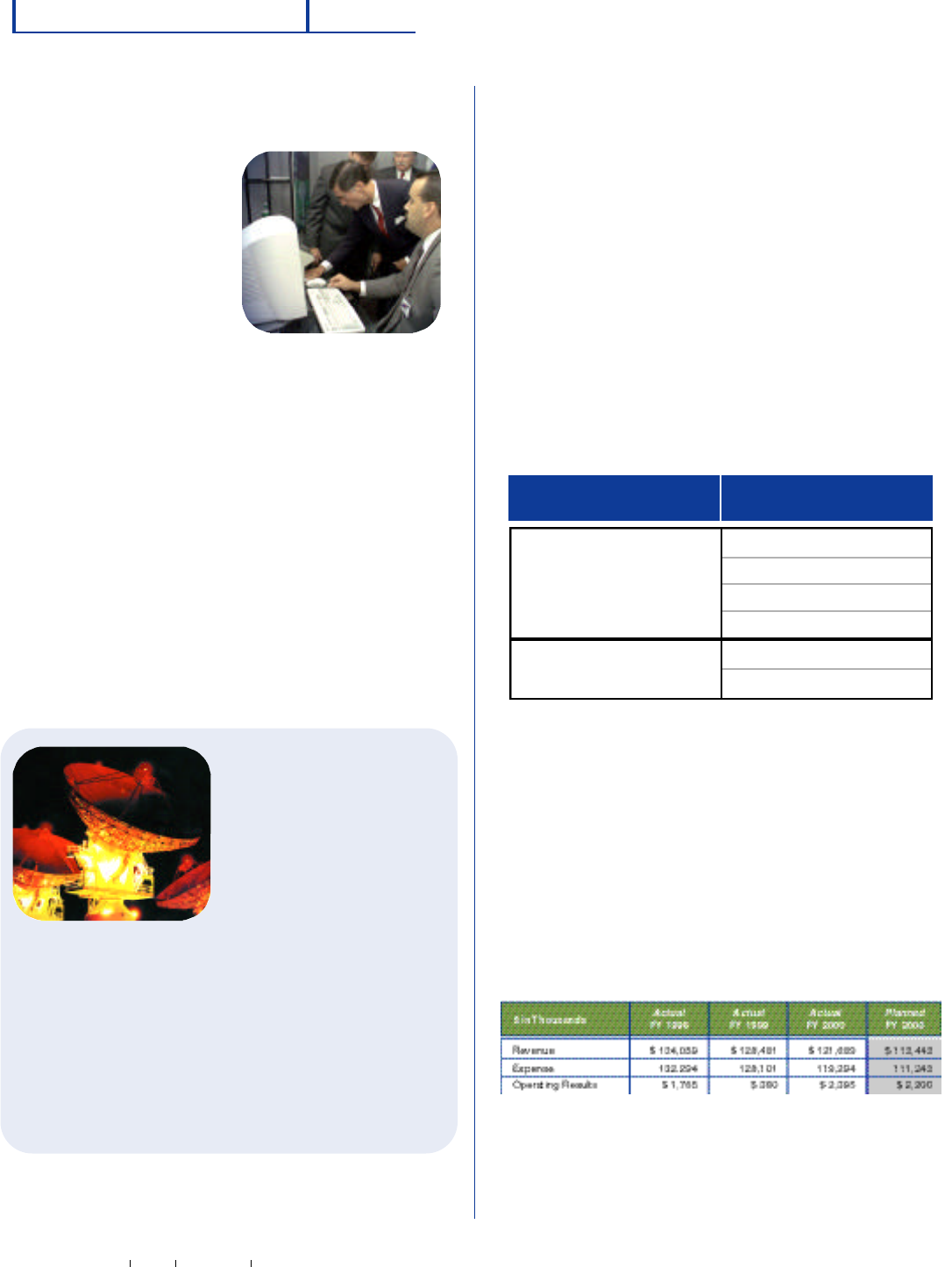
Overview
NAV Y WO R K I NG CA P T I A L FU N D
12
FY 2000
Information Services
The Information
Services activity group
includes the Naval
Computer and
Telecommunication
Centers (NCTC); the
Navy, Fleet Material
Support Office
(FMSO); and the Naval
Reserve Information
Systems Office
(NIRSO). The
comparative size of these organizations and
their respective contributions to the financial
statement presentations can be illustrated by
their relative revenue contributions: in FY 2000,
NCTC reported revenue of $121 million;
FMSO, $75.9 million; and NIRSO,
$13.6 million.
Naval Computer and Telecommunications
Centers
The Naval Computer and
Telecommunications
Centers provide regional
communications and
automated information
systems services to
customers; manage
remote facilities; provide
local information systems
support in coordination
with Defense
Information Systems Agency (DISA) information
processing centers; and design, develop, and
maintain standard DON automated information
systems.
The flow of information in the Navy can be
classified into two broad categories: message
information and data information. NCTC melds
communication and computer technologies to
provide its global customer base with advanced
automated information systems.
Effective 1 October 1999, the NWCF portion
of NCTC became a part of the Space and
Naval Warfare Systems Centers (SSCs). The
NCTC support centers have retained their
geographical locations, but control of the
centers has been assigned to SSC Charleston
and SSC San Diego as follows:
Effective 1 October 2000, all financial reporting
for the centers is consolidated in the Research
and Development sub-activity group for either
SSC San Diego or SSC Charleston. The only
accounts that will remain open will be those
required to support the residual accounting
effort for one year.
Operating Results
SSC Charleston Washington, D.C.
Pensacola, Florida
Norfolk, Virginia
Jacksonville, Florida
SSC San Diego San Diego, California
Pearl Harbor, Hawaii
Space and Naval Warfare Geographic Location
Systems Center
Senator Charles Robb receives
an on-hands demonstration by
getting his hand scanned for
access purposes to the new
Smart Card Technology Center.
A view of the satellite dish
arrays at the N aval Computer
and Telecommunications
Area Master Station in
Honolulu, HI.
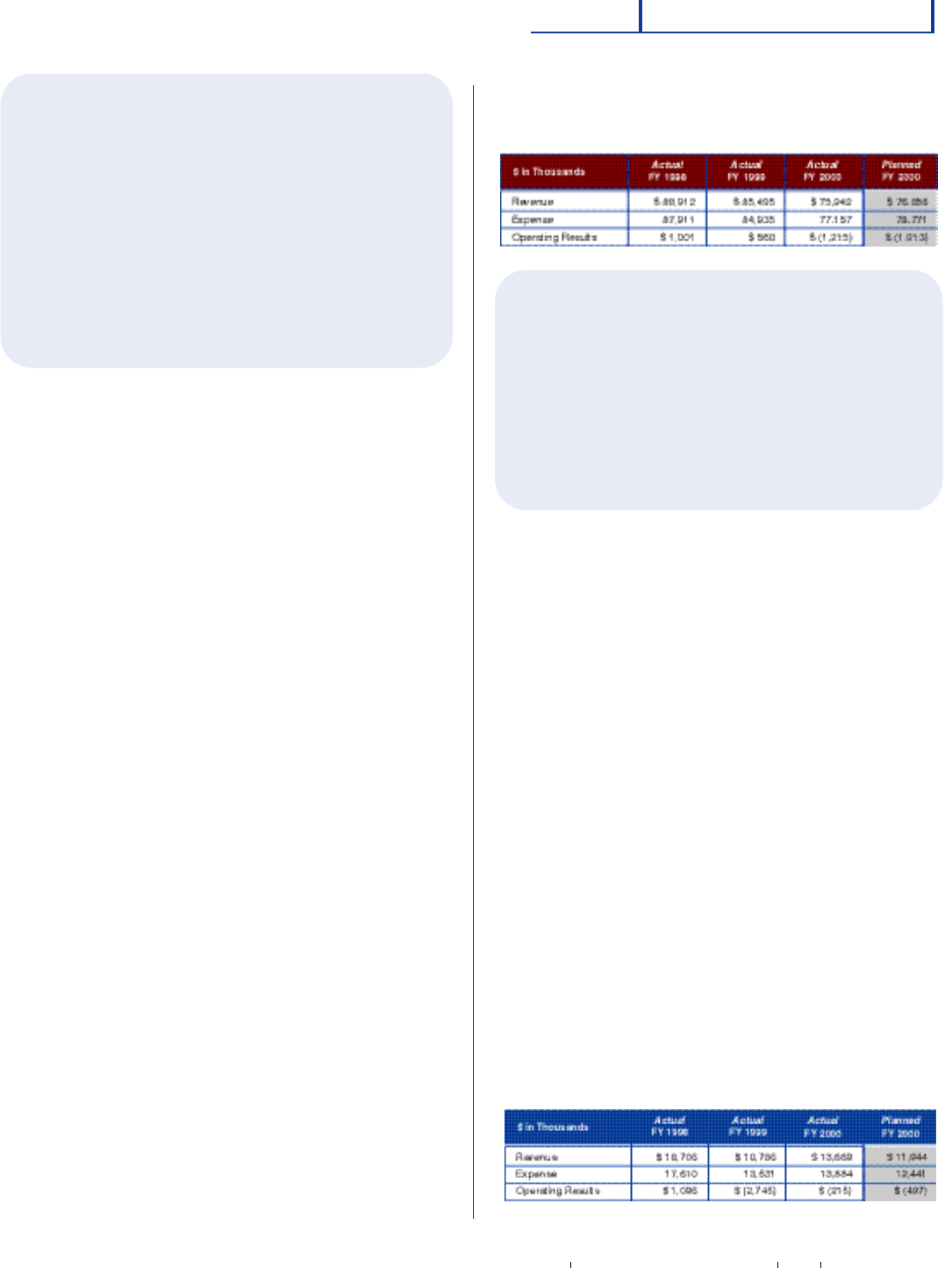
13
NAV Y WO R K I NG CA P T I A L FU N D
O ve rv i e w
Navy Working Capital Fund
Navy, Fleet Material Support Office
The mission of the Navy, Fleet Material
Support Office (FMSO) is to employ information
technology for the design, development,
integration, and maintenance of automated
information systems for Navy, DoD, and other
Federal agencies, with specific emphasis on
systems supporting Naval supply, inventory and
material management, financial processing, and
maintenance operations.
From its two Naval Support Stations, one in
Mechanicsburg, PA, and one in Philadelphia,
PA, FMSO continues to operate as the first and
only Navy activity to achieve a Capability
Maturity Model (CMM) level IV rating, placing
it in a select group of software (Maintenance
and Development) agencies. Fewer than 3
percent of all DoD activities have a rating of IV
or higher.
The FMSO vision is to produce quality
products on time and in full partnership with its
customers. FMSO’s commitment to this vision
is evidenced by its support of the Navy Supply
System Command’s effort to improve its
business processes. FMSO supplied a team of
approximately 100 personnel to support the
Enterprise Resource Planning (ERP) project, a
private industry initiative undertaken by
NAVSUP. The goal of ERP is to develop a
business management system that integrates all
facets of business, including strategic planning,
manufacturing, sales, distribution, human
resources, and reporting. FMSO’s contribution
to the business case analysis of the project and
its recommendation of business software is
crucial to the success of ERP.
Operating Results
The Defense Finance and Accounting Service
charges for services provided contributed to
the actual Operating Result exceeding the
planned amount by $698 thousand.
Naval Reserve Information Systems Office
The Naval Reserve Information Systems Office
provides quality information management and
information technology products, services, and
solutions to satisfy requirements of the Navy, the
DoD, and other government agencies; and
performs other functions and tasks as directed
by a higher authority.
Effective 1 October 2000, control of the Naval
Reserve Information Systems Office (NIRSO)
was transferred from the Commander Naval
Systems Office to the Space and Naval Warfare
Systems Centers (SSCs). With this realignment,
the name of this activity changed to SPAWAR
Information Technology Center (ITC) New
Orleans. The effects of the realignment are
rather complicated. For FY 2001, the
operations of this activity will continue to be
included in the NWCF. In FY 2002 (1 October
2001), however, the activity will be absorbed
by the General Fund; only the residual
accounting, rather than results of operations,
will be included in the NWCF from that
point forward.
Operating Results
FY 2000 Operating Results were $282,000
higher than planned, in large part due to a
credit labor adjustment of approximately
$200,000.
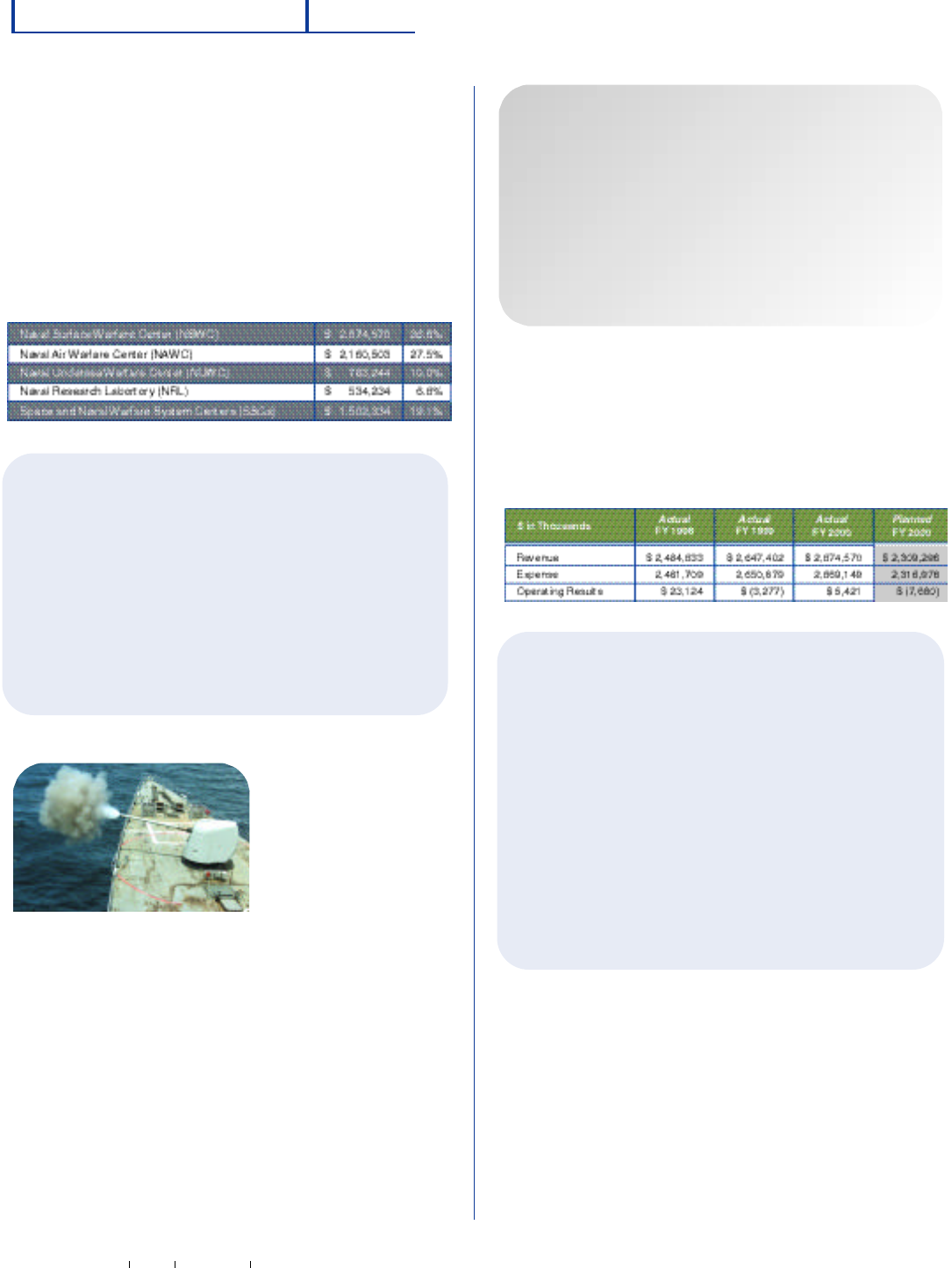
Overview
NAV Y WO R K I NG CA P T I A L FU N D
14
FY 2000
Research and Development
The Research and Development activity group
generated $7.8 billion dollars in FY 2000,
representing 37.7 percent of total NWCF
revenue. The group is divided functionally into
five subactivities, contributing revenues to the
activity group as follows:
Naval Surface Warfare Center
The Naval Surface Warfare Center operates the
Navy’s full spectrum research, development,
test and evaluation, engineering and fleet
support center for ship hull, mechanical, and
electrical systems; surface ship combat systems;
coastal warfare systems; and other offensive
and defensive systems associated with
surface warfare.
The Naval Surface
Warfare Center
(NSWC) is
dedicated to the
production of
advanced weapon
products for the
readiness and the
advancement of
the Navy of the 21st Century. NSWC is
organized into five divisions— Carderock,
Crane, Dahlgren, Indian Head, and Port
Hueneme—and the Naval Warfare Assessment
Station, Corona.
Operating Results
Actual FY 2000 Operating Results were $13.1
million above plan, in large part because of the
execution of more direct labor hours than
estimated.
Naval Air Warfare Center
The Naval Air Warfare Center operates the
Navy’s full spectrum research, test, and
evaluation, in-service engineering, and Fleet
support activity for naval aircraft engines,
avionics, and aircraft support systems,
ship/shore/air operations, weapons systems
associated with air warfare, missiles and missile
subsystems, aircraft weapons integration, and
airborne electronics warfare systems. The center
also operates the department’s air, land, and sea
test ranges.
The Naval Air Warfare Center (NAWC) has two
divisions supporting its mission objectives:
The NAWC Aircraft Division (NAWAD) is the
Navy’s full spectrum research, development,
test and evaluation (RDT&E), engineering, and
USS Caron fires its five-inch guns in
a live fire exercise on Vieques,
Puerto Rico.
T
he NSWC Crane Division was recognized
for its innovative efforts to reduce costs
with two DoD Value Engineering Awards:
for its work with the AN/ALQ Electronic
Countermeasures system; and for its part
in developing new battery designs with
tri-service applications and benefits.
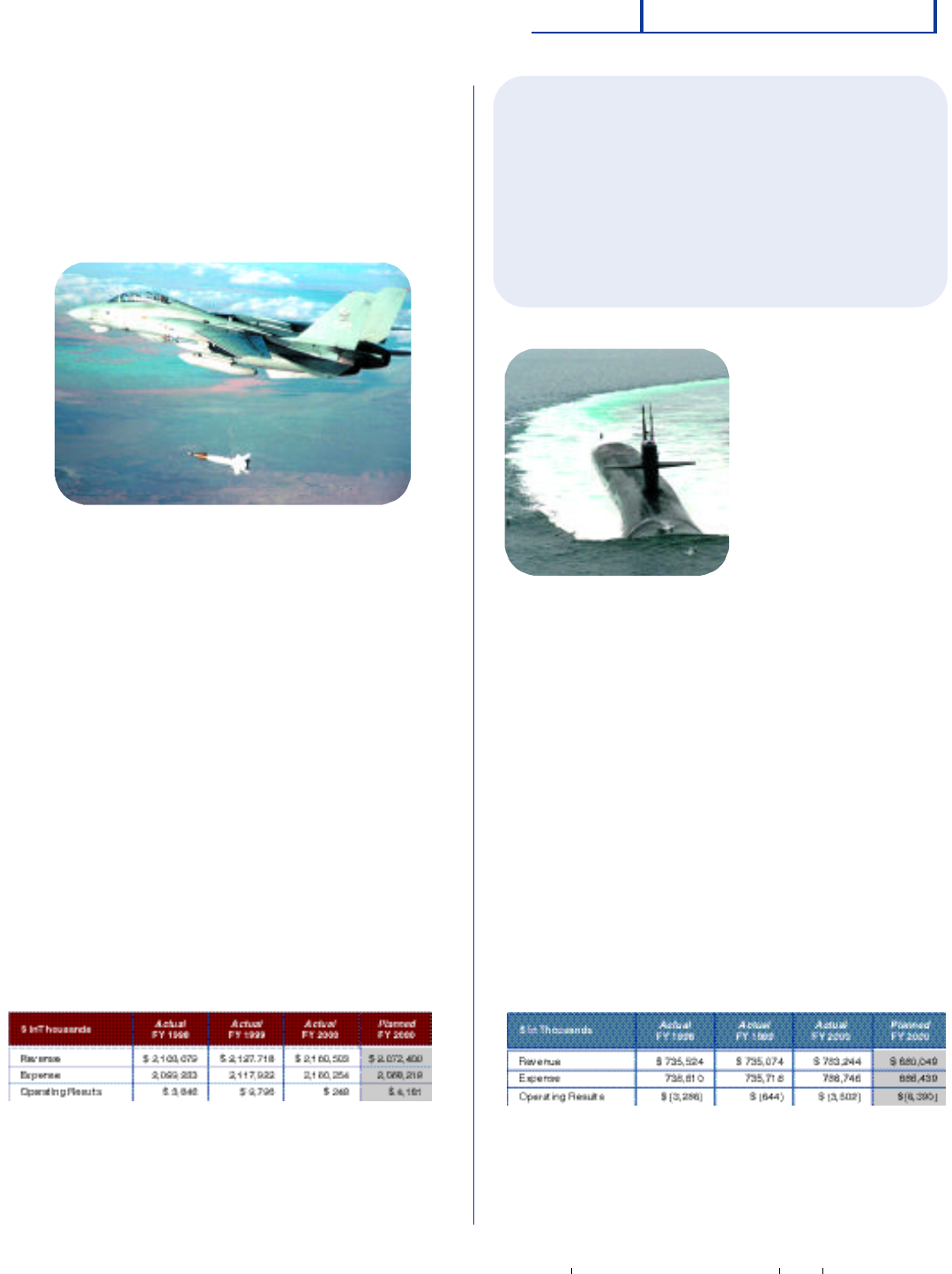
15
NAV Y WO R K I NG CA P T I A L FU N D
O ve rv i e w
Navy Working Capital Fund
fleet support center for air platforms. Its product
areas include aircraft systems technology,
propulsion, flight test and engineering, avionics
design and production, and the aircraft-platform
interface.
The NAWC Weapons Division combines the
resources of its sites in China Lake, CA and Pt.
Mugu, CA to provide the Navy and DoD with
effective and affordable integrated warfare
systems and life cycle support to ensure
battlespace dominance.
Operating Results
FY 2000 Operating Results were $3.9 million
below plan. This is attributable to several factors,
including increases in labor acceleration costs
and increased costs associated with the
implementation of the Defense Industrial
Financial Management System (DIFMS).
Naval Undersea Warfare Center
The mission of the Naval Undersea Warfare
Center is to operate the Navy’s full-spectrum
research, development, test and evaluation,
engineering, and fleet support center for
submarines, autonomous underwater systems,
and offensive and defensive weapon systems
associated with undersea warfare.
The Naval Undersea
Warfare Center
(NUWC) is
supported by two
divisions: Division
Newport, located in
Newport, RI, and
Division Keyport, in
Keyport, WA.
In addition to these
two main sites,
NUWC has several
smaller detachments
across North
America, ranging from Andros Island in the
Bahamas to Lualualei, HI, and from San Diego,
CA to Nanoose, British Columbia.
Operating Results
FY 2000 Operating Results exceeded plan by
$2.9 million, primarily because NUWC
executed more direct labor hours than
originally planned.
An F-14B “Tomcat” drops a GBU-16 laser guided bomb
during a live fire training exercise.
USS Alabama (SSBN 731) cruises at
high speed on the surface as she
approaches the Naval Submarine
Base at San Diego following the
completion of the sub’s 50th
deterrent patrol.
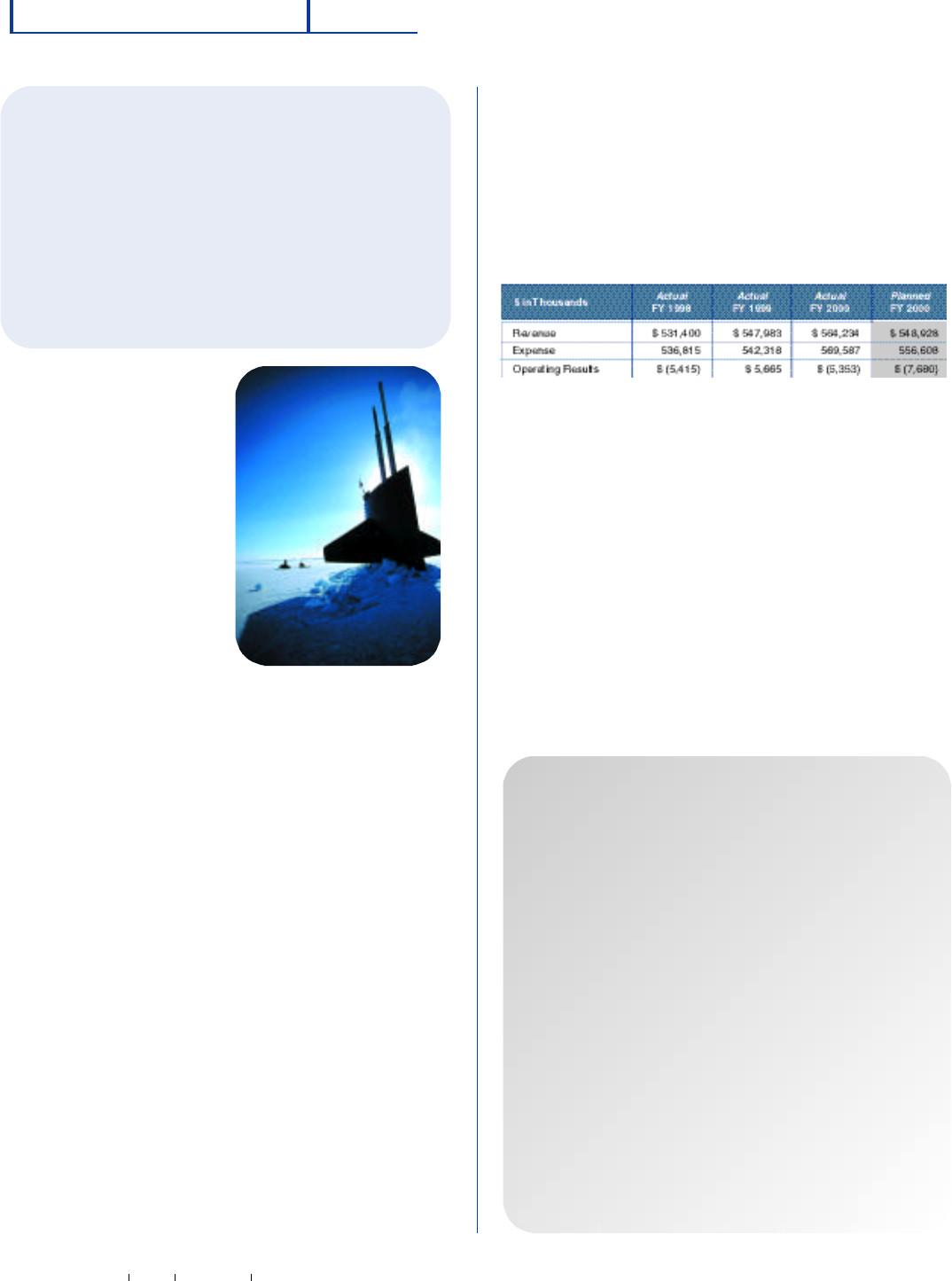
Overview
NAV Y WO R K I NG CA P T I A L FU N D
16
FY 2000
Naval Research Laboratory
The Naval Research Laboratory conducts a
broad-based multidisciplinary program of
scientific research and advanced technological
development, directed toward maritime
applications of new and improved materials,
techniques, equipment, and systems, and
development of ocean, atmospheric, and space
sciences and related technologies.
Serving as the Navy’s
corporate laboratory,
Naval Research
Laboratory (NRL)
product lines include:
• Broad research of
natural science,
including long-
range research, in
areas of interest to
the Navy.
• Exploratory and
advanced
technological
development
deriving from or appropriate to the scientific
program areas.
• Development of prototype systems
applicable to specific projects within areas of
technological expertise.
• Space technology and space systems
development and support.
• Mapping, charting, and geodesy (MC&G)
research and development for the National
Imagery and Mapping Agency.
In its role as the Navy’s corporate laboratory,
NRL supports scientific research and
development for other Navy activities and,
where qualified, for other DoD and
government agencies.
Operating Results
FY 2000 operating results, although negative,
were higher than planned. With revenue and
expense levels remaining relatively stable,
operating losses are planned through
FY 2002 to reduce positive Accumulated
Operating Results.
Financial Management Improvement Initiatives
at NRL are consistent with the Navy Strategic
Sourcing Program in their incorporation of
A-76 studies, contract efficiencies, and
functionality assessments.
1. In FY 2000, NRL completed a study of
administrative services, concluding that the
function should be retained in-house.
Additional A-76 studies are planned for
supply operations (FY 2001), audio-visual
Improved Predictions of Tropical
Cyclone Tracks
T
ropical cyclones can adversely affect the
military in many ways, from impacting
specific missions to affecting routine daily
activities in port. NRL has consequently
developed and demonstrated a global
numerical weather prediction system, the
Navy Operational Global Atmospheric
Prediction System (NOGAPS), that has the
ability to predict the path of tropical
cyclones. Recent enhancements to this
system, undertaken following research
within the academic community, have led to
significant improvements in the ability of
NOGAPS to predict tropical cyclone tracks.
USSHawbill (SSN 666) surfaced
at ice camp APLIS (Applied
Physics Laboratory Ice Station).
Hawbill is at the North Pole in
support of the Science Ice
Expedition.

17
NAV Y WO R K I NG CA P T I A L FU N D
O ve rv i e w
Navy Working Capital Fund
services (FY 2001), and management
information systems (FY 2002).
2. NRL will assess the potential of alternative
contracting processes to reduce contract
costs. Procedures that will be evaluated
include the use or further use of single
process initiatives, milestone-based progress
payments, and/or the consolidation of
contracting requirements.
3. NRL is continuing its program of
concentrating research division personnel
into a smaller number of buildings at the
Washington, D.C. site. Older, unused
buildings will be demolished, reducing
operating, maintenance, and upkeep costs.
Space and Naval Warfare System Centers
The Space and Naval Warfare Systems Centers
serve as the Navy’s full spectrum research,
development, test and evaluation, engineering,
and fleet support centers for command, control,
and communication systems and ocean
surveillance. The centers are also responsible for
integrating those systems that overarch
multiplatforms.
The Space and Naval
Warfare Systems Centers
(SSCs) provide the
scientific and technical
expertise, facilities, and
understanding of defense
requirements necessary
to ensure that the Navy
can develop, acquire, and
maintain the warfare
systems it needs to meet
current and emerging
requirements. In FY 2000,
this mission was
supported by two
Centers:
SSC Charleston designs, builds, tests, fields,
and supports the Navy’s frontline command,
control, communications, computers,
intelligence, surveillance, and reconnaissance
(C4ISR) systems.
SSC San Diego is responsible for development
of the technology to collect, transmit, process,
display, and, most critically, to manage the
information that is essential to naval operations.
Operating Results
FY 2000 Operating Results were $21.4 million
above plan due to the SSCs handling more
workload than planned. This resulted in
increased direct labor hours, which in turn
generated more overhead than was spent.
Advanced Human-Computer
Interface (AHCI)
S
SC San Diego completed in FY 2000 the
development of an advanced human-
computer interface that includes the Open
System Advanced Workstation (OSAW) and
Display User Enhancement Technology
Systems (DUETS). OSAW offers next-
generation workstations for command and
control systems by integrating state-of-the-art
technologies, including flat-panel displays,
touch screens, speech recognition, and 3-D
audio localization. OSAW work continues
under DUETS, a program that provides
common tactical pictures of the battlespace
in 3-D to the tactical action officer in the
combat information center. The AHCI
(OSAW/DUETS) offers a cost-effective, user-
centered, and mission-relevant 3-D tactical
display system with multimodal human-
computer interfaces.
An Operations Specialist plots a
adar contact on a Dead Reckoning
acer (DRT) in the Combat
nformation Center (CIC) aboard
USS Belleau Wood (LHA 3).
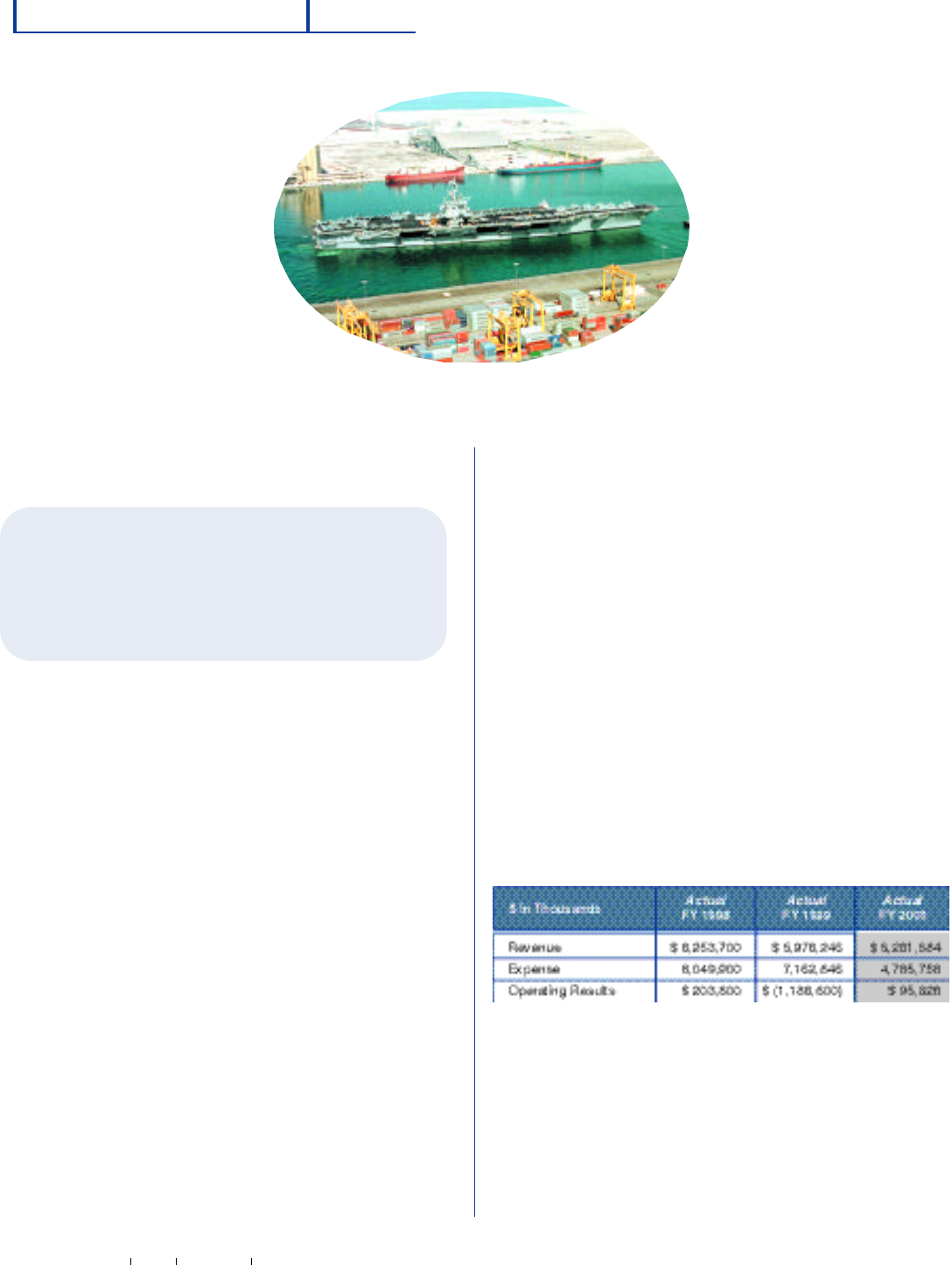
Overview
NAV Y WO R K I NG CA P T I A L FU N D
18
FY 2000
Supply Management
The Navy and the Marine
Corps are represented by
separate subactivities
within the Supply
Management activity
group. In FY 2000, Supply
Management accounted for
$5.4 billion of total NWCF
revenue, or 26.3 percent.
Navy Supply Management
generated $5.2 billion and
Marine Corps Supply
Management, $166 million.
Navy Supply Management
The mission of the Navy Supply Management
Activity is succinct: “To provide Navy, Marine
Corps, Joint, and Allied Forces with quality
supplies and services.”
The worldwide, integrated Navy Supply System
gets the Fleet what it needs, where and when it
needs it. This supply activity is supported
through the Naval Inventory Control Point
(NAVICP), headquartered in Philadelphia, PA;
two sites in Mechanicsburg and Philadelphia,
PA; and six Fleet and Industrial Supply Centers
(FISCs).
NAVICP exercises centralized control over
350,000 different line items of the repair parts,
components, and assemblies that keep ships,
aircraft, and weapons operating. NAVICP also
provides logistic and supply assistance to
friendly and allied nations through the Foreign
Military Sales program.
The FISCs provide a variety of logistics support
services and products to Navy and other
military customers. These products and
services include material
management, contracting,
transportation, fuel services,
customer service,
hazardous materials
management, household
goods movement
support, consolidated mail
services, and supply
consultation.
Operating Results
For supply-type activities,
the most effective
performance measure is a comparison of
operating results over time, rather than a
comparison of planned and actual results.
Between FY 1998 and FY 1999, the Operating
Result fell, largely due to a clean-up of the
Central Data Base (CDB) subsequent to the
conversion of ships and stock points to an
inactive status (i.e., through base realignment
and closure (BRAC) and decommissioning). The
FY 2000 Operating Results showed a return to
a positive figure, but it should be noted that the
result was significantly influenced by the
capitalization of aviation depot-level repairable
(AVDLR) inventories aboard aviation-capable
ships and with the Marine Aviation Logistics
Squadron.
The Naval Supply Systems Command and the
Defense Finance and Accounting Service
(DFAS) recently completed a project that will
dramatically improve the Navy’s financial
accountability and control of funds used to
The aircraft carrier USS Enterprise (CVN 65) enters the port of Jebel
Ali (Dubai), United Arab Emirates.
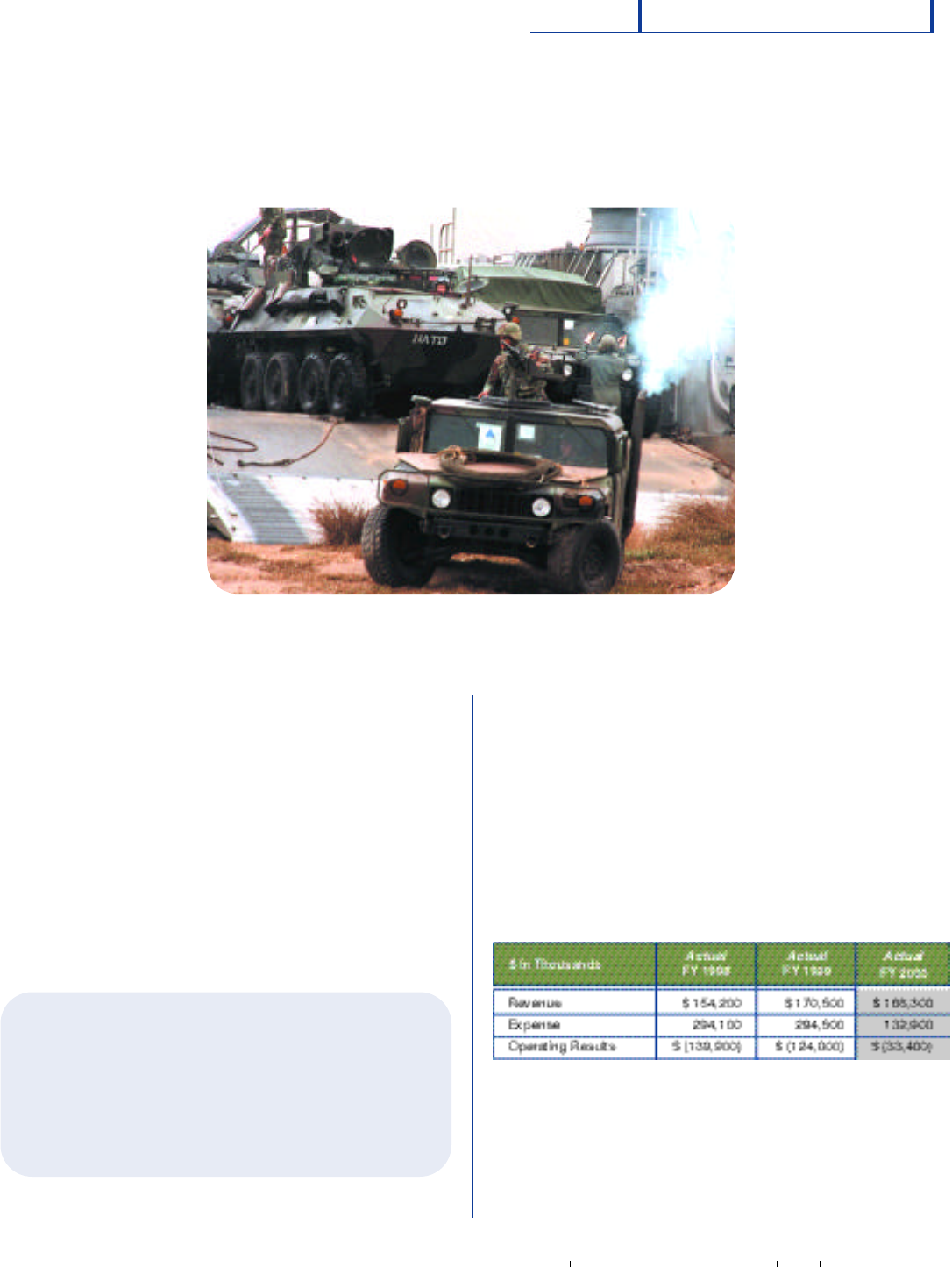
19
NAV Y WO R K I NG CA P T I A L FU N D
O ve rv i e w
Navy Working Capital Fund
procure equipment, supplies, and services.
The new system provides faster and better
access to data, improving financial
management efficiency.
The Fleet Material
Support Office
partnered with
NAVSUP and
DFAS to create,
develop, and
incorporate two
new modules for
the Navy’s Material
Financial Control
System (MFCS).
The new modules,
referred to as the
Allotment Accrual
Accounting
Module (PX02) and
the Expenditure
Processing Module
(PX04), replaced a mainframe system of
approximately 1 million lines of computer
code. These modules are compatible with the
Internet-ready, flexible, and secure client/server
architecture that provides such key benefits as
system security, expandability, and scalability.
Navy personnel received extensive training on
the new modules, enabling the operation to be
self-sustaining from its inception. No outside
consulting resources are required for day-to-day
operations and maintenance.
Marine Corps Supply Management
The Marine Corps Supply Management activity
supports the Fleet Marine Force, the Navy, and
the Department of Defense by providing
consumable and reparable items essential to the
mission of its customers.
Marine Corps Supply Management consists of
both retail and wholesale operations. Retail
operations are performed primarily under the
Direct Support Stock Control (DSSC) concept.
Under this concept,
fast-moving items in
support of base or
station functions are
stocked at issue
points close to the
customer. Currently,
the Marine Corps
operates nine DSSC
activities, namely,
Quantico, Parris
Island, Camp
LeJeune, Albany,
Barstow, San Diego,
Twentynine Palms,
Camp Pendleton,
and Camp Butler. In
addition to DSSCs,
the Marine Corps
manages one Inventory Control Point (ICP) at
the Marine Corps Logistics Base in Albany, GA.
As the wholesale component of the supply
management business area, the ICP supplies
Marine Corps-managed consumable and
reparable items to the Fleet Marine Force
(FMF) and other customers.
Operating Results
Marines from the 24th Marine Expeditionary Unit Special Operations Capability
(SOC) disembark from a Landing Craft Air Cushion (LCAC) as part of Operation
Dynamic Mix 2000.

Overview
NAV Y WO R K I NG CA P T I A L FU N D
20
FY 2000
Performance Measurement
Objectives of the Navy Working
Capital Fund:
The NWCF activity groups share common
operating objectives, against which their
performance is measured. These objectives
include:
• Ensuring, through effective cash
management, that there are sufficient cash
reserves to maintain responsiveness to
customer requirements.
• Producing the high-quality goods and
services that support the mission of the
DON and the operational objectives of
other customers.
Cash Management
NWCF Objective: To ensure, through effective
cash management, that there are sufficient cash
reserves to maintain responsiveness to
customer requirements.
The operational model of the NWCF activities
requires that the activity secure and deliver the
goods or services required by the customer
before it is reimbursed for the cost of providing
those goods or services. To ensure that the
NWCF has adequate cash reserves to cover
the cost of goods and services sold until
reimbursement is received, the USD (C)
recommends a cash balance be maintained
that is equal to seven to 10 days of operating
cash disbursements plus six month’s balance of
capital expenditures.
For FY 2000, the target cash balance to meet
this recommendation was $668 million (seven
days) to $890 million (10 days). Not only did
the NWCF meet this target but, as FY 2000
closed, the cash position more than met the
recommended 10-day level, the result of
unanticipated sales growth experienced by
Supply Management, Navy and workload
above budgeted levels in the Research and
Development activity group. This strong FY
2000 performance should ensure that the
NWCF continues to accommodate cash flow
requirements needed to meet customer
demand for services.
Customer Support
NWCF Objective: To produce the high-quality
goods and services that support the mission of
the DON and the operational objectives of
other customers.
The volume of work performed by the NWCF
activities is indicated by the revenue that the
NWCF generates. The distribution of that
revenue by source indicates the relative
importance of each customer to the operations
of the NWCF. The table below illustrates the
total NWCF Revenue for FY 1998 through FY
2000, by customer. The figures for FY 1998 and
FY 1999 include revenue attributed to the
Ordnance activity group, which was transferred
to a mission-based or General Fund activity in
FY 2000. The Ordnance revenue, the NWCF
customer base for the past three years is
shown below:
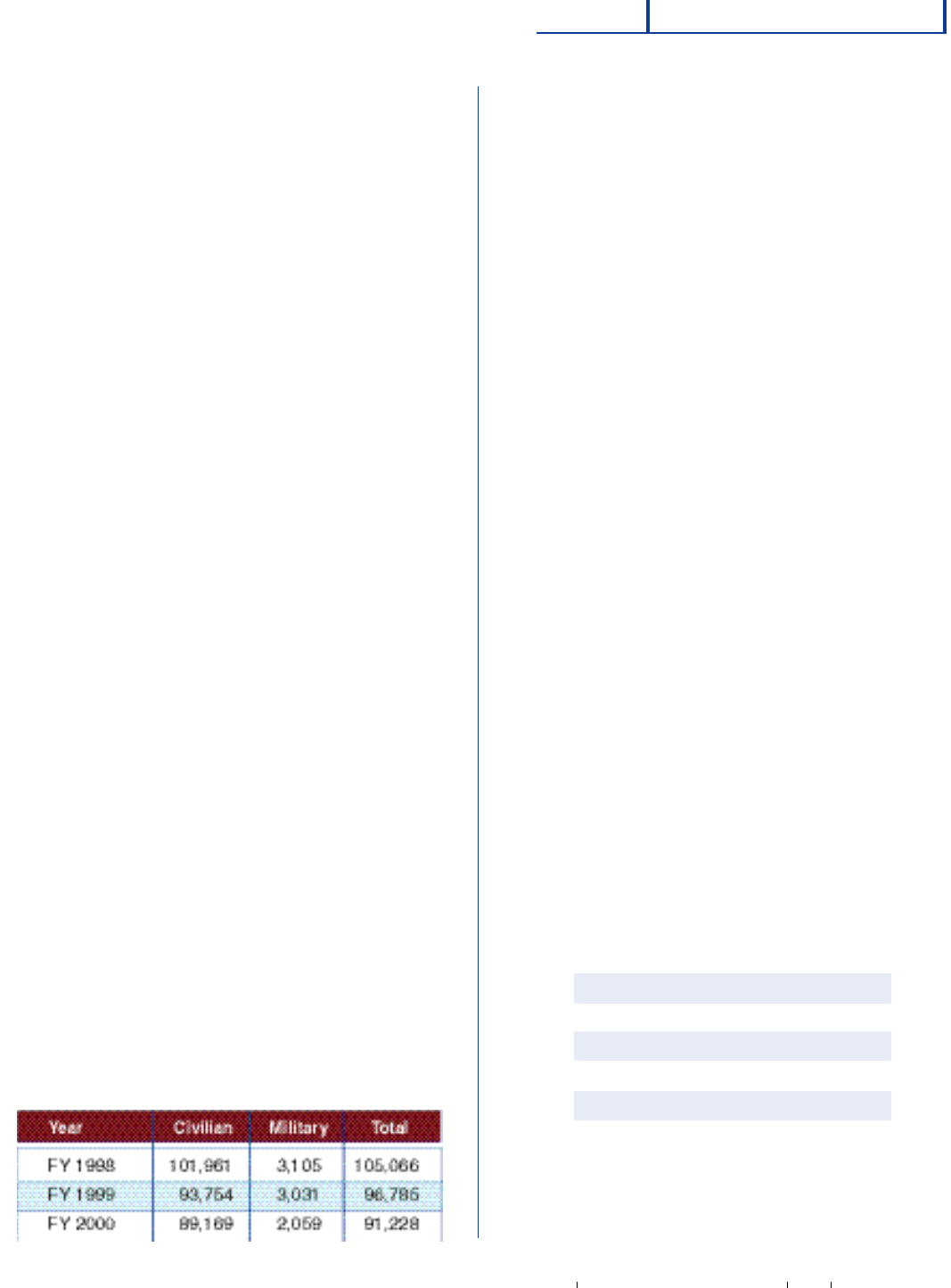
21
NAV Y WO R K I NG CA P T I A L FU N D
O ve rv i e w
Navy Working Capital Fund
Challenges and
Opportunities
The challenges and opportunities facing the
NWCF activity groups are the same challenges
that face any complex business organization in
a global market. These challenges include:
• Continuing the delivery of excellence
with a shrinking workforce.
• Reducing or eliminating advance billings
to more effectively manage the cash
balance of the NWCF
• Implementing financial management
and process improvements through
nonfinancial feeder teams.
• Maintaining Financial Management
Systems in compliance with current
regulatory guidance.
• Reevaluating the methods and processes
for assessing managerial control risks.
Personnel Resources
One of the challenges facing the NWCF is how
to maintain or improve current levels of service
as its workforce shrinks. To counter this
challenge, the NWCF has adopted automated
processes, outsourcing techniques, and other
innovative solutions to ensure that its
customers continue to receive the best
possible service.
The following table illustrates the continued
downward trend for the numbers of civilian
and military personnel engaged in the missions
of the NWCF activity groups:
Cash Management: Advance Billings
To improve short-term cash solvency,
customers may be billed in advance of service
or product delivery. But while these advance
billings improve the ready cash balance, they
do not change the customer work schedule or
reduce the cost of filling the customer order.
In 1995, when the responsibility for managing
the cash balances was returned to the
individual components, the NWCF received a
$442 million cash balance and responsibility for
a $2.2 billion liability for advance billings. The
NWCF then faced the challenge of filling the
orders associated with these advance billings,
requiring further outlay of cash, while
simultaneously rebuilding the cash balance to
provide sufficient resources to cover seven to
10 days of operating requirements.
The NWCF instituted an aggressive cash
recovery plan to rebuild a positive cash
position. The objectives of the plan were
threefold: to eliminate the $2.2 billion liability
for advance billings; to maintain cash balances
equal to seven to 10 days of operating
requirements; and to cease new advance
billings. Through assessing cash surcharges,
the NWCF has steadily reduced its unliquidated
advanced billing balance to just $4 million at
the end of FY 2000.
FY 1996 1.4 billion
FY 1997 638 million
FY 1998 291 million
FY 1999 55 million
FY 2000 4 million

Overview
NAV Y WO R K I N G CA P T I A L FU N D
22
FY 2000
Working Groups
In 1998, DoD initiated two efforts to speed its
progress toward an unqualified opinion: the
Biennial Financial Management Improvement
Plan and the DoD Implementation Strategies.
The Biennial Financial Management
Improvement Plan defines the environment the
DoD would like to attain in the future and
provides a concept of operations to guide
transition toward this environment. The DoD
Implementation Strategies establish specific
milestones and tasks to be achieved when
addressing financial management initiatives and
deficiencies. These efforts complement one
another and provide the cornerstone of the
DON’s strategy to develop fully integrated
financial management systems. They mandate a
course of aggressive action, including:
• Reengineering business processes to
achieve an integrated, data-sharing
environment.
• Adopting a business philosophy that uses
a proprietary/budgetary financial
structure within a performance-oriented
financial management environment.
• Tracking the life cycle costs of property
assets from acquisition through usage to
final disposal.
• Establishing electronic exchanges or
system interfaces between standalone,
nonfinancial feeder systems and standard
accounting and reporting systems.
• Establishing a risk management
environment incorporating internal
controls such as competency training to
ensure data integrity and protection
against fraud.
Working Groups
The DON has created nonfinancial feeder
teams, or working groups, to oversee financial
management and process improvements and to
support DoD Implementation Strategies. Each
working group is led by a senior civilian or a
flag officer and includes broad representation
of program and financial personnel from the
Secretariat, Navy and Marine Corps
Headquarters, the audit community (General
Accounting Office, DoD Inspector General,
and Naval Audit Service), DoD agencies, and,
where appropriate, contractor support. In
addition, a representative from each working
group attends Executive Steering Committee
(ESC) meetings with staff of the Office of the
Under Secretary of Defense (Comptroller).
DON Working Groups include:
• Plant Property and Equipment (Real,
Personal, National Defense, Heritage, and
Property in Possession of Contractors)
• Inventory and Operating Materials and
Supplies
• Deferred Maintenance
• Environmental Restoration and Hazardous
Waste
• Time and Attendance and Personnel
Systems.
During FY 2000, the working groups continued
to change business practices, eliminate
redundant and manually intensive systems, and
bring remaining systems into compliance with
Federal Accounting Standards. All teams made
considerable progress, reaching different stages
of completion according to the complexity of
their implementation strategy.
Working group highlights
Real Property. The Navy Facility Assets Data
Base (NFADB) is the DON’s central repository
for land, building, and structure assets. Work in
FY 2000 focused primarily on raising the
accuracy of data (existence, completeness, and

23
NAV Y WO R K I NG CA P T I A L FU N D
O ve rv i e w
Navy Working Capital Fund
valuation) and on bringing the system into
compliance with federal accounting standards.
The team also identified the modifications
necessary to enable the calculation of
depreciation, and developed the internal
controls necessary to sustain accurate financial
reporting over the long term. The team will
continue to work with the Defense Finance and
Accounting Service (DFAS) to develop an
electronic interface with our Standard
Accounting and Reporting System (STARS)
during FY 2001.
Personal Property. This focus area is unique in
that it requires the implementation of a totally
new system, representing a significant change
in DON business culture and processes. The
DON chose to introduce the Defense Property
Accountability System (DPAS) as its standard
property accountability system, rejecting the
alternative of attempting to bring the hundreds
of existing local systems into compliance with
federal accounting standards—an option that
would have provided marginal improvement in
terms of overall accountability. Implementing
DPAS is an ambitious undertaking that will
require extensive personnel training to ensure
sustainability over the long term, but which
promises to improve management decision-
making and ensure accountability of assets.
Implementing DPAS has required the
development of new personal property policy,
operating procedures, and internal controls,
including audit-quality physical inventory
procedures. Work also continues with efforts to
develop a personal property catalog using
standard barcodes.
We made significant progress in FY 2000,
implementing DPAS at 140 sites that together
account for 99 percent of capital assets, by
dollar value (acquisition cost of $100,000 or
higher). Implementation will continue in FY
2001, as will the efforts to improve the financial
reporting of personal property. DPAS will
ultimately be implemented at more than 900
Navy activities.
In FY 2000, the Marine Corps completed DPAS
implementation, turning its attention to physical
inventory counts and reviewing the accuracy of
its database. During FY 2001, training for
personal property managers will stress
accountability and the importance of
maintaining the existence, completeness, and
valuation of property.
Heritage Assets. During FY 2000, the Heritage
Asset team clarified definitions and reporting
requirements and conducted an extensive
market survey to identify products suitable for
use in the managing of assets. The team
selected a property management and archive
system and plans to purchase the software in
January 2001, with implementation to begin
shortly thereafter. This effort is currently funded
through FY 2001. The team also began to
standardize asset management processes,
seeking to ensure the consistency of internal
controls with hierarchical policy. This policy
and process approach should ensure the
success and sustainability of internal controls
over the long term.
Government Property in Possession of
Contractors (GPPC). The working group
continued its efforts to identify an appropriate
approach to account for property and material
held by contractors. During FY 2000, DoD
completed a draft study to determine the
extent to which existing systems already
maintain accountability of GPPC, in an effort to
reduce areas of duplicate reporting and to

NAV Y WO R K I NG CA P T I A L FU N D
24
FY 2000
Overview
develop a methodology for collecting GPPC
information within the constraints of federal
regulations. A report has not yet been issued
in final.
Operating Materials and Supplies (OM&S).
During FY 2000, the OM&S team evaluated
business processes, put forth a strategy for
streamlining the number of feeder systems, and
identified eight major systems for compliance
evaluation. Working closely with the Office of
the Secretary of Defense (OSD), DFAS, and the
audit community, the team took steps to
implement a model for valuing OM&S for
financial statement purposes. System
modifications will be required once an OM&S
valuation model has been selected in order to
bring the systems into compliance with federal
accounting standards.
Inventory and Logistics. The team is reviewing
systems and processes for managing the
DON’s Inventory Held for Sale. The team is
ensuring that feeder systems comply with
financial requirements, that in-transit assets are
properly managed, and that physical inventory
sampling and counting are accomplished
according to DoD policy. The team is also
revising the current acquisition inventory
valuation method and studying the feasibility of
implementing a direct historical cost method of
valuation. In FY 2000, two new modules were
additionally introduced in the Navy’s Material
Financial Control System (MFCS), replacing a
mainframe system of approximately 1 million
lines of computer code. The new modules will
support the enhancement of system security,
expandability, and scalability.
Summary
The working groups are making considerable
progress in assessing and reengineering the
DON’s business processes toward realization
of a standard, compliant system enabling
streamlined data flow and effective internal
control. A major outcome of this process will
be the elimination of redundant systems and
the development of interfaces between finance
and accounting systems and subsidiary
systems. Once realized, a fully integrated
financial management system will support the
program/budget process, provide information
for internal decision making, and produce
auditable financial statements that are
sustainable over the long term.
Financial Management Systems
One of the specific requirements for an activity
to be included in the working capital fund
classification is that the activity be supported
by an accounting system that is capable of
collecting the costs of production and assigning
these costs to the appropriate outputs. The
activities of the NWCF are supported by
financial systems as varied as the specialized
contribution each makes to the support of the
Navy and the defense of the United States.
The challenge facing the NWCF is to establish
and maintain financial management systems
that not only support the unique business areas
of its activity groups, but which also meet the
regulatory requirements for a federal financial
management system.
To meet this challenge, the NWCF has been
working with the Defense Finance and
Accounting Service (DFAS) to implement a
number of migratory systems that will meet the
current standards for federal financial
management systems. The table below
illustrates the financial management systems
supporting the NWCF activity groups. For
those activity groups where a legacy system is
in use, the targeted migratory system and
planned implementation date are also
displayed.
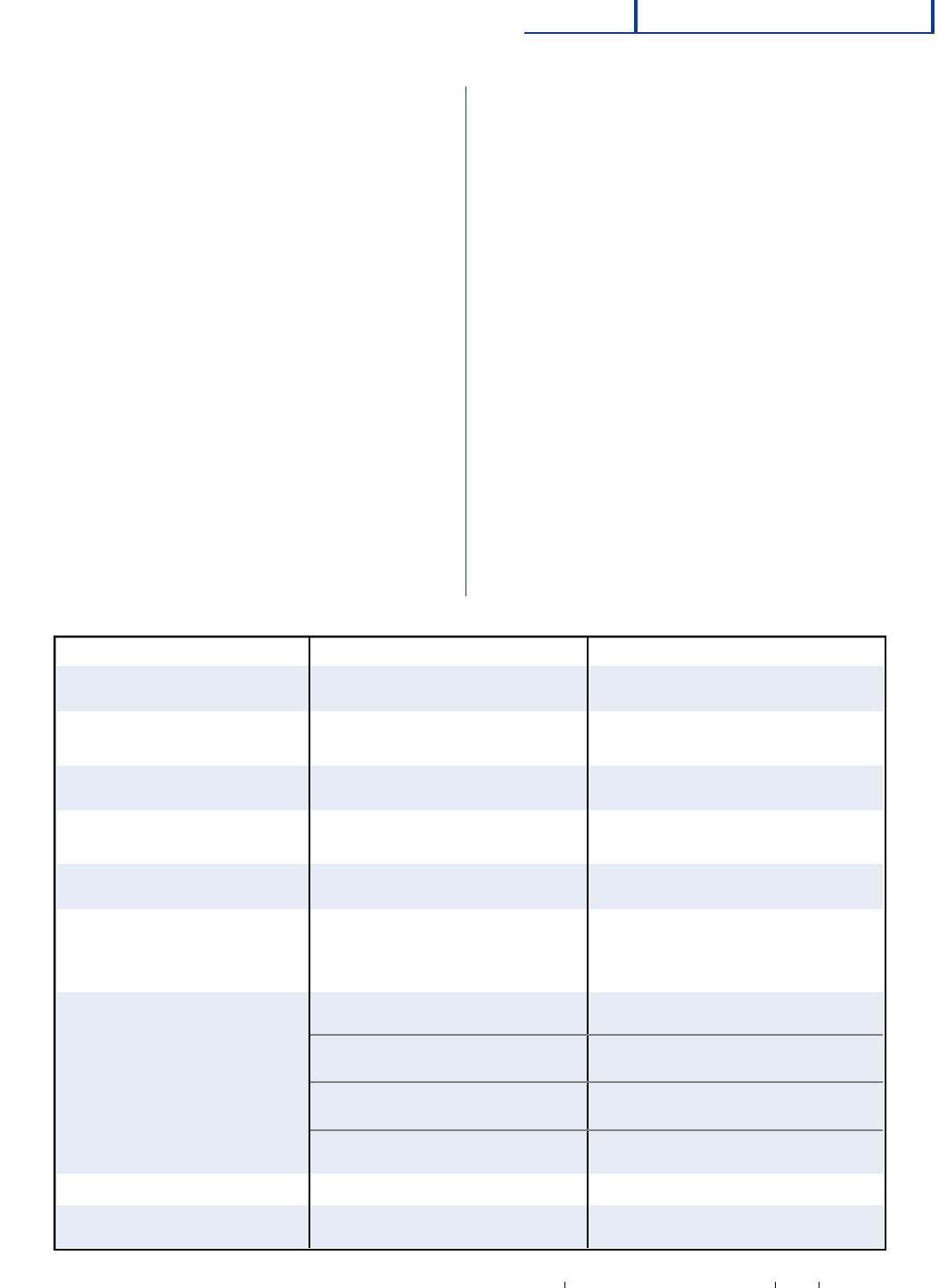
25
NAV Y WO R K I NG CA P T I A L FU N D
O ve rv i e w
Navy Working Capital Fund
Risk management Initiative
The expanding legal and regulatory
requirements, the powerful but vulnerable
Internet, and the uncertainties inherent in
maintaining an able, ready Naval force make it
difficult to provide assurance that effective
controls are in place to mitigate the risks
involved in managing the complex, global
organization that is supported by the NWCF
activity groups.
To address the challenge of effective risk
management, the Navy is reviewing its
traditional, reactive approach of monitoring
control weakness reporting. In its place, DON
plans to implement a new risk management
process that will be proactive and that will
invigorate the organization to create a cultural
change and awareness of risk management
effectiveness.
The cultural change and the paradigm shift
from the traditional reactive model to one that
is focused on early detection of potential
management risks and their associated control
weaknesses are being tested in a pilot program
by NAVFAC. This pilot program combines
elements of facilitation, group meetings, and
proactive resolution in a structured
environment. Although it is still too early to
evaluate the impact of the pilot program, the
initial reports have been positive.
NWCF Activity Group Legacy System Migratory System
Depot Maintenance–Shipyards Naval Shipyard Management TBD (April 01)
Information System (SYMIS)
Depot Maintenance–Aviation Defense Industrial Financial Management
System (DIFMS)
Depot Maintenance–Marine Corps Defense Industrial Financial Management
System (DIFMS)
Transportation Military Sealift Command Financial
Management System (MSCFMS)
Base Support Public Works Center Management DWAS (September 03)
Information System (PWCMIS)
Information Services Industrial Fund Accounting System (IFAS) Transfers to GF activity (October 01)
Defense Business Management CO-WCF
System (DBMS)
Research and Development Defense Industrial Financial Management
System (DIFMS)
Information Management/Processing DIFMS (October 01)
System(IMPS)
Naval Operations and Management DIFMS (January 02)
Information Systems (NOMIS)
Realtime Integrated Management IFMS (April 01)
System (RIMS) D
Supply Management, NAVICP Material Financial Control System (MFCS)
Supply Management, Marine Corps Marine Corps Unified Material ATLASSII
Management System (MUMMS)

NAV Y WO R K I NG CA P T I A L FU N D
26
FY 2000
Overview

27
FY 2000
AN N UA L FI NA NC I A L RE P O RT
Principal Statements
Department of the Navy
Navy Working Capital Fund
Principal Statements

28
FY 2000
NAV Y WO R K I NG CA P I TA L FU N D
Principal Statements
Limitations of the Financial Statements
The financial statements have been prepared to report the financial position and results
of operations for the entity, pursuant to the requirements of Title 31, United States Code,
section 3515(b).
While the statements have been prepared from the books and records of the entity, in
accordance with the formats prescribed by the Office of Management and Budget, the
statements are in addition to the financial reports used to monitor and control budgetary
resources which are prepared from the same books and records.
To the extent possible, the financial statements have been prepared in accordance with
federal accounting standards. At times, the Department is unable to implement all
elements of the standards due to financial management systems limitations. The
Department continues to implement system improvements to address these limitations.
There are other instances when the Department’s application of the accounting
standards is different from the auditor’s application of the standards. In those situations,
the Department has reviewed the intent of the standard and applied it in a manner that
management believes fulfills that intent.
The statements should be read with the realization that they are for a component of the
U.S. Government, a sovereign entity. One implication of this is that the liabilities cannot
be liquidated without legislation that provides resources to do so.

29
FY 2000
AN N UA L FI NA NC I A L RE P O RT
Principal Statements
AN N UA L FI NA NC I A L RE P O RT
Principal Statements
The Department of the Navy’s FY 2000 Principal Financial Statements and related notes are presented
in the format prescribed by the Department of Defense Financial Management Regulation 7000.14,
Volume 6B of October 2000. The statements and related notes summarize financial information for
individual funds and accounts within the Department for the fiscal year ending September 30, 2000.
The following statements are included in the Department of the Navy’s Principal Statements:
• Consolidated Balance Sheet
• Consolidated Statement of Net Cost
• Consolidated Statement of Changes in Net Position
• Combined Statement of Budgetary Resources
• Combined Statement of Financing
The Principal Statements and related notes have been prepared to report the financial position
pursuant to the requirements of the Chief Financial Officers Act of 1990, as amended by the
Government Management Reform Act of 1994.
The accompanying notes should be considered an integral part of the principal statements

Department of Defense
Navy Working Capital Fund
Consolidated Balance Sheet
As of September 30, 2000
($ in Thousands)
FY 2000
ASSETS (Note 2)
Intragovernmental:
Fund Balance with Treasury (Note 3) $ 1,473,779
Investments (Note 4) 0
Accounts Receivable (Note5) 583,425
Other Assets (Note 6) 17,657
Total Intragovernmental Assets $ 2,074,861
Cash and Other Monetary Assets (Note 7) $ 0
Accounts Receivable (Note 5) 650,124
Loans Receivable (Note 8) 0
Inventory and Related Property (Note 9) 16,870,713
General Property, Plant and Equipment (Note 10) 4,118,173
Other Assets (Note 6) 1,377,027
TOTAL ASSETS $ 25,090,898
LIABILITIES (Note 11)
Intragovernmental:
Accounts Payable (Note 12) $ 985,695
Debt (Note 13) 967,512
Environmental Liabilities (Note 14) 0
Other Liabilities (Note 15 & Note 16) 76,152
Total Intragovernmental Liabilities $ 2,029,359
Accounts Payable (Note 12) $ (1,034,979)
Military Retirement Benefits and Other Employment-Related 1,223,914
Actuarial Liabilities (Note 17)
Environmental Liabilities (Note 14) 0
Loan Guarantee Liability (Note 8) 0
Other Liabilities (Note 15 & Note 16) 3,781,870
TOTAL LIABILITIES $ 6,000,164
NET POSITION
Unexpended Appropriations (Note 18) $ 0
Cumulative Results of Operations 19,090,734
TOTAL NET POSITION $ 19,090,734
TOTAL LIABILITIES AND NET POSITION $ 25,090,898
30
FY 2000
NAV Y WO R K I NG CA P I TA L FU N D
Principal Statements
The accompanying notes are an integral part of these financial statements.

31
FY 2000
AN N UA L FI NA NC I A L RE P O RT
Principal Statements
Department of Defense
Navy Working Capital Fund
Consolidated Statement of Net Cost
Year Ended September 30, 2000
($ in Thousands)
FY 2000
Program Costs:
Intragovernmental $ 5,646,484
With the Public 7,978,806
Total Program Cost $ 13,625,290
(Less: Earned Revenue) (13,724,470)
Net Program Costs $ (99,180)
Cost Not Assigned to Programs 0
(Less: Earned Revenue not attributable to Programs) 0
Net Costs of Operations $ (99,180)
See Notes 1 and 19.
The accompanying notes are an integral part of these financial statements.

32
FY 2000
NAV Y WO R K I NG CA P I TA L FU N D
Principal Statements
Department of Defense
Navy Working Capital Fund
Consolidated Statement of Changes in Net Position
Year Ended September 30, 2000
($ in Thousands)
FY 2000
Net Cost of Operations $ (99,183)
Financing Sources (other than exchange revenues)
Appropriations Used 0
Taxes and Other Nonexchange Revenue 0
Donations - Nonexchange Revenue 0
Imputed Financing (Note 20) 408,766
Transfers - In 77,193
Transfers - Out (418,821)
Other 3,716,827
Total Financing Sources (other than Exchange Revenues) $ 3,783,965
Net Results of Operations $ 3,883,148
Prior Period Adjustments (Note 20) (2,697,098)
Net Change in Cumulative Results of Operations $ 1,186,050
Increase (Decrease) in Unexpended Appropriations 0
Change in Net Position $ 1,186,050
Net Position - Beginning of the Period 17,904,688
Net Position - End of the Period $ 19,090,738
See Notes 1 and 20.
The accompanying notes are an integral part of these financial statements.

33
FY 2000
AN N UA L FI NA NC I A L RE P O RT
Principal Statements
Department of Defense
Navy Working Capital Fund
Combined Statement of Budgetary Resources
As of September 30, 2000
($ in Thousands)
FY 2000
BUDGETARY RESOURCES
Budget Authority $ 563,355
Unobligated Balance - Beginning of Period 2,462,318
Net Transfers Prior-Year Balance, Actual 61,600
Spending Authority from Offsetting Collections 20,653,232
Adjustments (132,935)
Total Budgetary Resources $ 23,607,570
STATUS OF BUDGETARY RESOURCES
Obligations Incurred $ 21,518,414
Unobligated Balances - Available 2,089,158
Unobligated Balances - Not Available (2)
Total Status of Budgetary Resources $ 23,607,570
OUTLAYS
Obligations Incurred $ 21,518,414
Less: Spending Authority from Offsetting Collections and
Obligation Adjustments (20,653,232)
Obligated Balance, Net - Beginning of Period 2,444,895
Obligated Balance Transferred, Net 0
Less: Obligated Balance, Net - End of Period (3,630,862)
Total Outlays $ (320,785)
See Notes 1 and 21.
The accompanying notes are an integral part of these financial statements.

Department of Defense
Navy Working Capital Fund
Combined Statement of Financing
Year Ended September 30, 2000
($ in Thousands)
FY 2000
OBLIGATIONS AND NONBUDGETARY RESOURCES
Obligations Incurred $ 21,518,414
Less: Spending Authority from Offsetting Collections and
Obligation Adjustments (20,653,232)
Donations Not in the Entity's Budget 0
Financing Imputed for Cost Subsidies 408,766
Transfers-In (Out) - Financing 88
Less: Exchange Revenue Not in the Entity's Budget (295,461)
Nonexchange Revenue Not in the Entity's Budget 0
Less: Trust or Special Fund Receipts Related to Exchange in the 0
Entity's Budget
Other 0
Total Obligations as Adjusted and Nonbudgetary Resources $ 978,575
RESOURCES THAT DO NOT FUND NET COST OF OPERATIONS
Change in Amount of Goods, Services, and Benefits Ordered but Not $ (984,254)
Yet Received or Provided (Increases)/Decreases
Change in Unfilled Customer Orders (316,547)
Costs Capitalized on the Balance Sheet - (Increases)/Decreases (1,476,123)
Financing Sources that Fund Costs of Prior Periods (14,946)
Collections that Decrease Credit Program Receivables or Increase 0
Credit Program Liabilities
Adjustments for Trust Fund Outlays that Do Not Affect Net Cost 0
Other - (Increases)/Decreases 0
Total Resources That Do Not Fund Net Costs of Operations $ (2,791,870)
COMPONENTS OF COSTS OF OPERATIONS THAT DO NOT
REQUIRE OR GENERATE RESOURCES
Depreciation and Amortization $ 205,930
Bad Debts Related to Uncollectable Non-Credit Reform Receivables 0
Revaluation of Assets and Liabilities - Increases/(Decreases) 1,394,793
Loss of Disposition of Assets 0
Other - Increases/(Decreases) (4,272)
Total Costs That Do Not Require Resources $ 1,596,451
FINANCING SOURCES YET TO BE PROVIDED $ 117,663
NET COST OF OPERATIONS $ (99,181)
See Notes 1 and 22.
34
FY 2000 The accompanying notes are an integral part of these financial statements.
NAV Y WO R K I N G CA P I TA L FU N D
Principal Statements

Department of the Navy
Navy Working Capital Fund
Notes to Principal
Statements
35
FY 2000
AN N UA L FI NA NC I A L RE P O RT
Notes to Principal Statements

36
FY 2000
NAV Y WO R K I NG CA P I TA L FU N D
Notes to Principal Statements
Note 1. Significant Accounting Policies
A. Basis of Presentation.
These financial statements have been prepared to report the financial position and results of
operations of the Navy Working Capital Fund (NWCF). The financial statements are required by the
Chief Financial Officer's (CFO) Act, as amended and expanded by the Government Management
Reform Act (GMRA) of 1994 and other relevant legislation. This report provides information to enable
Congress, agency managers, the public, and other interested parties to assess management
performance. These statements are in addition to the Department of the Navy (DON) financial reports,
prepared pursuant to OMB, DoD, the Defense Finance and Accounting Service (DFAS) and DON
directives, that are used to monitor and control DON's use of budgetary resources.
To the extent possible, the financial statements have been prepared from the books and records of the
DON in accordance with the "Department of Defense Financial Management Regulation" ("DoD
FMR"), the Office of Management and Budget (OMB) Bulletin No. 97-01, "Form and Content of
Agency Financial Statements" and generally accepted accounting principles (GAAP). However, the
NWCF is unable to implement certain elements of GAAP and the OMB Bulletin No. 97-01 due to
limitations of the financial management processes and systems, including financial and nonfinancial
feeder systems and processes. Reported values and information for the NWCF major asset categories
are derived from nonfinancial feeder systems, such as inventory systems and logistic systems. These
systems were designed to support reporting requirements focusing on maintaining accountability over
assets and reporting the status of federal appropriations and not current emphasis of business-like
financial management. As a result, the NWCF cannot currently implement certain aspects of GAAP
and the OMB Bulletin No. 97-01. See Note 1.D, Note 1.K, Note 9, and Note 10 for more details.
Fu rth e r, the NWCF is unable to implement certain elements of the DoD guidance on eliminating entri e s
due to limitations of the financial management processes and systems, including DFAS fi n a n c i a l
accounting systems and DON nonfinancial feeder systems and processes. See the Re qu i re d
S u p p l e m e n ta ry Information section of this re p o rt for more details and Notes 5, 6, 12, and 15 .
DFAS and DON continue to implement process and system improvements addressing the limitations
of financial accounting systems and nonfinancial feeder systems to produce NWCF financial
statements in accordance with applicable federal standards and requirements.
In addition to systems limitations, the DoD application of the accounting standards is different in some
instances from the auditor's interpretation of the standards. The DoD has reviewed the intent of the
standards and applied them in a manner that management believes fulfills that intent. One financial
statement element impacted by different applications of the accounting standards is financing
payments under firm fixed price contracts. A more detailed explanation of this item is discussed in the
note applicable to the financial statement line item affected. See Note 1.P and Note 6 for more
details.

37
FY 2000
AN N UA L FI NA NC I A L RE P O RT
Notes to Principal Statements
The amounts presented in the financial statements and notes for Fiscal Year (FY) 2000 are rounded to
the nearest thousand of dollars.
B. Mission of the Reporting Entity.
The overall mission of the DON is to organize, train, and equip forces to deter aggression and, if
necessary, defeat aggressors of the United States and its allies. The NWCF provides goods, services,
and infrastructure to DON and other DoD customers to help ensure our military forces are mobile,
ready, and have the most advanced technology.
FY 2000 represents the tenth year that the DON has prepared financial statements as required by the
CFO Act, as amended. The CFO Act requires that the DON prepare and have audited financial
statements for each revolving fund and account that performed substantial commercial functions
during the preceding fiscal year.
The accompanying financial statements account for all resources for which the NWCF is responsible
except that information relative to classified assets, programs, and operations has been excluded from
the statements or otherwise aggregated and reported in such a manner that it is no longer classified.
The consolidating NWCF financial statements include all activities and functions previously financed
through the Navy Industrial Fund and DON Stock Fund which were converted to the Defense Business
Operations Fund (DBOF) in October 1991. In December 1996, Under Secretary of Defense
(Comptroller) (USD(C)) eliminated the DBOF and established four working capital funds. One of the
four working capital funds is the NWCF. Establishment of the NWCF did not change any previous
organizational reporting structure.
The following identifies the NWCF primary and secondary activity groups.
Depot Maintenance
Depot Maintenance - Shipyards
Depot Maintenance - Aviation
Depot Maintenance - Marine Corps
Ordnance
Commanders-In-Chief Atlantic Fleet (CINCLANTFLT)
Commanders-In-Chief Pacific Fleet (CINCPACFLT)
Transportation
Base Support
Public Works Centers (PWCs)
Naval Facilities Engineering Service Center (NFESC)
Information Services
Naval Computer and Telecommunications Command (NCTC)
Navy, Fleet Material Support Office (FMSO)
Naval Reserve Force (NAVRESFOR)

38
FY 2000
NAV Y WO R K I NG CA P I TA L FU N D
Notes to Principal Statements
Research and Development
Naval Surface Warfare Center (NSWC)
Naval Air Warfare Center (NAWC)
Naval Undersea Warfare Center (NUWC)
Naval Research Laboratory (NRL)
Space and Naval Warfare Systems Centers (SSCs)
Supply Management
Navy
Marine Corps
Navy Component
In FY 2000, the Ordnance activity group transferred from NWCF to the DON General Fund in
accordance with Program Budget Decision 407 of 12 November 1998. Because residual accounting
remains in the NWCF, the Ordnance activity group prepared financial statements and related notes for
FY 2000, which are a part of the consolidated financial statements included in this report. Additionally,
subsequent to the FY 2000 reporting date, the NWCF portion of the Information Service's Naval
Computer and Telecommunications Command became a part of the Research and Development's
Space and Naval Warfare Systems Centers. This change does not affect the FY 2000 NWCF financial
statements.
C. Budgets and Budgetary Accounting.
NWCF funded activities provide services and materials to DoD components and other federal
government agencies through buyer-seller relationships. The buyers, who are the NWCF activities'
customers, identify requirements that justify the need for funds from Congress. NWCF activities
operate under the revolving fund concept wherein customers are to reimburse the NWCF activities to
cover the cost of services or material provided. Revolving funds receive their initial working capital
through an appropriation or a transfer of resources from existing appropriations or funds and use those
capital resources to finance the initial cost of products and services. Financial resources to replenish
the initial working capital and to permit continuing operations are generated by the acceptance of
customer orders.
The Navy industrial activities' financial management systems, which operate under NWCF, accumulate
all cost incurred in various programs or jobs plus overhead which are subsequently billed to the
customers. The NWCF also finances the purchase of consumable and repairable items, which are held
in inventory at stock activities until issued and billed to the customer with reimbursement to the NWCF
activities.
D. Basis of Accounting.
When possible, the financial statements are presented on the accrual basis of accounting as required
by GAAP. The NWCF also records budgetary accounting transactions, which facilitates compliance
with legal constraints and controls over the use of federal funds.

39
FY 2000
AN N UA L FI NA NC I A L RE P O RT
Notes to Principal Statements
For FY 2000, the NWCF's financial management systems are unable to fully comply with requirements
for accrual accounting. Additionally, most NWCF financial and nonfinancial feeder systems are not
designed to perform budgetary accounting. Hence, the information presented on the Statement of
Budgetary Resources was developed using proprietary accounts. The NWCF has undertaken efforts to
determine the additions required to bring all of its financial and nonfinancial feeder systems and
processes into compliance with all elements of GAAP. One such significant action is the revision of its
accounting systems to incorporate the United States Government Standard General Ledger (SGL) and,
thusly, to record financial events in both budgetary and proprietary accounts at the transaction level.
E. Revenues and Other Financing Sources.
Revenue is earned primarily from providing services, materials, and products to the DON and others
and is recognized on a percentage of completion or material issue basis. Revenue for NWCF Supply
Management activities is recognized when an item is dropped from inventory at the time of sale.
For financial reporting purposes, the DoD policy requires the recognition of operating expenses in the
period incurred. Expenditures for capital and other long-term assets are not recognized as expenses
until consumed in the NWCF's operations.
F. Accounting for Intragovernmental Activities.
The NWCF activities interact with, and are dependent upon, other financial activities of the federal
government as a whole. Therefore, these financial statements do not reflect the results of all financial
decisions applicable to the agency as though the agency was a stand-alone entity.
1. The DON's proportionate share of the public debt and related expenses of the Federal Government
are not included. Debt issued by the Federal Government and the related interest costs are not
apportioned to Federal agencies. The financial statements, therefore, do not report any portion of the
public debt or interest thereon, nor do the statements report the source of public financing whether
from issuance of debt or tax revenues.
2. Financing for the construction of DON facilities is obtained through budget appropriations. To the
extent this financing may have been ultimately obtained through the issuance of public debt, interest
costs have not been capitalized since the Treasury Department does not allocate interest costs to the
benefiting agencies.
3. NWCF civilian employees participate in the Civil Service Retirement System (CSRS) and Federal
Employees Retirement System (FERS), while military personnel are covered by the Military Retirement
System (MRS). Additionally, employees and personnel covered by FERS and MRS are also covered by
Social Security. The individual NWCF activity groups fund a portion of pension benefits under these
retirement systems but do not disclose the assets or actuarial data on the accumulated plan benefits or
unfunded pensions liabilities of its employees. Reporting such amounts is the responsibility of the
Office of Personnel Management (OPM) or CSRS and FERS. The consolidated NWCF financial
statements recognize an imputed expense for civilian employee pensions and other retirement
benefits in the Statement of Net Cost and have recognized imputed revenue for the civilian employee

40
FY 2000
NAV Y WO R K I NG CA P I TA L FU N D
Notes to Principal Statements
pensions and other retirement benefits in the Statement of Changes in Net Position. The retirement
actuarial liabilities for the MRS are reported on the financial statements of the Military Retirement Trust
Fund.
4. In FY 2000, the NWCF activity groups sold inventory items or services to foreign governments under
the provisions of the Arms Export Control Act of 1976. Under the provisions of the act, DoD has
authority to sell Defense articles and services to foreign countries, generally at no profit or loss to the
U.S. Government. Customers are required to make payments in advance to a trust fund maintained by
the Department of the Treasury from which the Military Services are reimbursed for the cost of
administering and executing the sales. In FY 2000, the NWCF received reimbursements of $380,762
thousand for assets sold under the FMS program.
5. To prepare stand-alone NWCF financial statements, transactions occurring between and among
NWCF activities must be eliminated. However, the NWCF cannot accurately identify all intra-NWCF
transactions by customer. For FYs 1999 and 2000, the NWCF accounting firm (DFAS) provided NWCF
summary seller-side balances for revenue, accounts receivable, and advances from others and required
the adjustment of the buyer-side records to recognize expenses, accounts payable, and advances to
others. The effects of intra-NWCF transactions were then eliminated from the financial statements. In
addition, the NWCF implemented the policies and procedures contained in the Intragovernmental
Eliminations Task Force's "Intragovernmental Transactions Accounting Guide" for reconciling
intragovernmental transactions pertaining to investments in federal securities, borrowings from
Treasury and the Federal Financing Bank, Federal Employee Compensation Act transactions with the
Department of Labor, and benefit program transaction with OPM. See the Required Supplementary
Information section of this report for more details on eliminating entries and reconciling
Intragovernmental transactions impacting the NWCF financial statements included in this report.
G. Funds with the U.S. Treasury and Cash.
The NWCF's financial resources are maintained in U.S. Treasury accounts. The majority of cash
collections, disbursements, and adjustments are processed worldwide at the DFAS, DON, and the U.
S. Army Corps of Engineers (USACE) disbursing stations, as well as the Department of State financial
service centers. Each disbursing station prepares monthly reports, which provide information to the
U.S. Treasury on check issues, interagency transfers and deposits. In addition, the DFAS centers and
the USACE Finance Center submit reports to the Department of Treasury, by appropriation, on
collections received and disbursements issued. The Department of Treasury then records this
information to the appropriation Fund Balance with Treasury (FBWT) account maintained in the
Treasury's system. Differences between the NWCF's FBWT account and Treasury's FBWT often result
and are reconciled. Material Disclosures are provided in Note 3.
Effective February 1995, the USD(C) returned management of FBWT and its associated anti-deficiency
limitations to the DON and other military components. This action effectively merged the
component's responsibility for monitoring collection and disbursement transactions, as well as taking
actions to correct operational problems, with the responsibility for control over FBWT. FBWT is
managed at the NWCF corporate level.

41
FY 2000
AN N UA L FI NA NC I A L RE P O RT
Notes to Principal Statements
The practice of closing activity collections and disbursements to the DON departmental level was
discontinued in October 1997 and FBWT was reestablished at the activity level. FBWT at the activity
group and activity level reflect the ending FY 1997 balance plus FY 1998 - FY 2000 collections,
disbursements, and non-expenditure transfers recorded in the NWCF Treasury sub-limit 97X4930.002.
During FY 1998, the DON and DFAS completed work to record all non-expenditure transfers at the
activity level vice at the Departmental level. Plans are being developed to move activity level
collections and disbursements closed to the departmental level in FY 1995 and FY 1996 back to the
activity level. Once this is accomplished, all activity level collection, disbursement, and non-
expenditure transactions, effective from February 1995 will be recorded in the activity general ledgers.
This plan is estimated to be completed in FY 2001. See Note 3.
H. Foreign Currency.
Not Applicable.
I. Accounts Receivable.
As pre s e n ted in the NWCF Balance Sheet, accounts re c e i vable includes accounts, claims, refunds, and
i n te re s t re c e i v able from other fe d e ral entities or from the public. No allowances for uncollectible
accounts are provided for amounts owed by a fe d e r al age n c y. Claims against another fe d e ral agency are
to be re s o lved bet w een the agencies. Mate rial disclosures are provided in Note 5.
J. Loans Receivable.
Not applicable.
K. Inventories and Related Property.
Inventory is managed in the Supply Management Activity Group and includes DON-managed
consumable and repairable items, and other Service, DLA, and General Services Administration (GSA)
managed items. These items are recorded in the accounting records at Standard Price. A Standard
Price consists of the cost of the material plus appropriate cost recovery rates. Inventories for reporting
purposes are revalued from Standard Price to utility value using the Latest Acquisition Cost (LAC)
method allowed by SFFAS No. 3, "Accounting for Inventory and Related Property" and procedures
prescribed by the USD(C) and DFAS. The LAC method is used because logistics systems were
designed for material management purposes and do not maintain historical cost. The LAC method of
revaluation requires the recognition of unrealized holding gains and losses in an inventory allowance
account. Adjustment of the inventory value for unrealized holding gains and losses should result in an
inventory valued at an approximation of historical cost.
During FY 2000 the Navy segment of the Supply Management Activity Group revised the inventory
revaluation model calculation of the cost recovery factor and estimated repair cost and DFAS modified
calculations and adjustments in the model affecting disclosures. However, significant issues with the
reliability of the estimates calculated by the model remain. The cost associated with transfers to
disposal overstates expenses by assigning a larger cost to the inventory transferred to disposal than is
warranted considering that significant quantities of inventory sent to disposal are received from

42
FY 2000
NAV Y WO R K I NG CA P I TA L FU N D
Notes to Principal Statements
customers without cost. Inventory losses are offset with inventory gains and treated as adjustments to
the inventory allowance account vice period expenses which affects operating results. The treatment
of disposal actions and inventory losses are requirements that must be addressed to improve the
auditability of the results of the model. See Note 9.A for material disclosure.
Depot Maintenance, Transportation, Base Support, Information Services, and Research and
Development Activity Groups reported Operating Materials and Supplies balances as of 30 September
2000. These Activity Groups maintain Operating Materials and Supplies for use on customer work as
needed. These items are recorded at cost, primarily using a weighted average method, and charged as
an expense using the consumption method of accounting. The nonfinancial systems supporting
Operating Materials and Supplies do not, in all cases, maintain the historical cost data necessary to
comply with SFFAS No. 3. Additionally, the systems do not revalue excess, obsolete, and
unserviceable Operating Materials and Supplies to their net realizable value nor do the systems
adequately categorize these assets as Held for Use, Held in Reserve for Future Use, Held for Repair,
and Excess, Obsolete, and Unserviceable as required by SFFAS No.3. See Note 9.B for material
disclosures.
L. Investments in U.S. Treasury Securities.
Not Applicable.
M. General Property, Plant and Equipment (PP&E).
The NWCF categorizes all PP&E used in the performance of its mission as General PP&E. Beginning in
FY 1999, NWCF activities were required to report Required Supplementary Stewardship Information
(RSSI) on Heritage Assets they own, but do not use, in performing their mission. To prevent
duplicative reporting of the same Heritage Assets within DON, the total number of DON-wide
Heritage Assets are reported in the RSSI of the Audited Financial Statements of the DON General
Funds (Treasury Index 17). The RSSI reporting requirements on Stewardship PP&E (National Defense
PP&E and Stewardship Land) and Stewardship Investments (Non-Federal Physical Property Investments
and Research and Development Investments) do not apply to NWCF activities.
In March 1998, the USD(C) modified earlier policy for computing depreciation of General PP&E
acquired on or after 1 October 2000. Depreciation expense is recognized on all General PP&E,
except land and land rights of unlimited duration.
The General Accounting Office (GAO) has determined that real property used by the NWCF, but
under the jurisdiction of the Military Departments, represents an asset of the NWCF, and that such
property should be reported on the financial statements as an entity asset to show the full costs of all
resources and assets used in NWCF operations. DFAS is currently developing accounting and
reporting procedures to allow NWCF to report finance sources and expenses associated with assets
not acquired with NWCF resources (e.g., real property) as Other Revenues and Financing Sources and
Depreciation and Amortization Expense.

43
FY 2000
AN N UA L FI NA NC I A L RE P O RT
Notes to Principal Statements
General PP&E assets are capitalized at historical acquisition cost plus capitalized improvements when
(1) an asset has a useful life of two or more years, and (2) the acquisition cost equals or exceeds the
DoD capitalization threshold of $100,000. Also improvement costs over the DoD capitalization
threshold of $100,000 for General PP&E should be capitalized. Cost is based upon a specific amount
paid or estimated value if a receipt document is not available. The General PP&E capitalized amount
includes the acquisition cost of the asset plus any additional costs such as transportation, installation
and any internal costs incurred to make the asset ready for use.
The expense/investment criteria which is the capitalization threshold has varied by fiscal year of
acquisition. Two certified public accounting (CPA) firms have recommended that the DoD retain its
current capitalization threshold of $100,000.
Fiscal Years Expense/Investment Threshold
FY 1996 - FY 2000 $ 100,000
FY 1995 50,000
FY 1994 25,000
FY 1992 - FY 1993 15,000
When the expense/investment funding threshold changes, an asset capitalized within the NWCF at a
previous threshold continues to be capitalized and depreciated at the threshold at which it was
originally capitalized.
All maintenance and repair costs are recorded as an expense when they are incurred. Additional
information is provided in Note 10.
N. Advances and Prepayments.
Payments in advance of the receipt of goods and services are recorded as advances or prepayments
and reported as an asset on the Balance Sheet at the time of prepayment and recognized as
expenditures and expenses when the related goods and services are received.
O. Leases.
Lease payments are for rental of equipment, space, and operating facilities and are classified as either
capital or operating leases. The NWCF does not have any leases meeting the DoD FMR requirement
for capitalization.
P. Other Assets.
Included as Other Assets are intragovernmental and non-federal assets that are not included on other
lines of the Balance Sheet. Note 6 provides additional disclosures related to Other Assets.

44
FY 2000
NAV Y WO R K I NG CA P I TA L FU N D
Notes to Principal Statements
NWCF activities conduct business with commercial contractors under two primary types of contracts-
fixed price contracts and cost contracts. In order to alleviate the potential financial burden on the
contractor of long-term contracts, the NWCF sometimes provides financing payments. One type of
financing payment that the NWCF makes, for real property, is based upon a percentage of completion.
In accordance with the SFFAS No. 1, "Accounting for Selected Assets and Liabilities," these payments
are reported as construction in progress and are disclosed by the NWCF in Note 10, General Property,
Plant and Equipment (PP&E). The NWCF makes other financing payments pursuant to the Federal
Acquisition Regulation under fixed price contracts that are not based on percentage of completion.
The NWCF reports these financing payments as advances or prepayments on the "Other Assets" line of
the Balance Sheet, with related disclosures provided in Note 6. The NWCF treats these payments as
advances and prepayments because it becomes liable only after the contractor delivers the goods in
conformance with the contract terms. If the contractor does not deliver a satisfactory product, the
NWCF is not obligated to reimburse the contractor for its costs, and the contractor is liable to repay
the NWCF for the full amount of the advance. The NWCF does not believe that the SSFAS No. 1
addresses this type of financing payment. The auditors disagree with the NWCF's application of the
accounting standard pertaining to advances and prepayments because they believe that the SFFAS No.
1 is applicable to this type of financing payment.
The Milita ry Sealift Command (MSC) Tra n s p o rtation activity group re p o rted an amount relating to
A float Pre - p r epositioning Fo rce - Navy (APF-N) ships as Other Assets on Line 1.G of the Balance Sheet .
H o weve r , the USD(C) has concluded that MSC's arra n gement for use of the APF-N ships does not meet
the cri te ria for a capital lease and that payments made for the use of those ships should be re c o rded as
an operating expense. The Tra n s p o rtation activity group has made long-term arra n gements for use of
the ships that invo lved Fe d e r al Financing Bank (FFB) debt financing. The outstanding principal owed to
the FFB for the ships is re p o rted as Assets - Intra g ove r n m e n tal - Inve stments on the Balance Sheet. A
decision on the proper recognition and disclosure of this APF-N financing agreement and MSC's ch a rte r
a rra n gements for the long-term use of the ships had not been made at the time the FY 2000 NWC F
financial sta t ements we re finalized. See Note 6 and Note 13 for more details on APF-N re l a ted balances
re p o rted for FY 2000.
Q. Contingencies and Other Liabilities.
The SFFAS No. 5, "Accounting for Liabilities of the Federal Government," defines a contingency as an
existing condition, situation, or set of circumstances that involves an uncertainty as to possible gain or
loss to the NWCF. The uncertainty will be resolved when one or more future events occur or fail to
occur. A contingency is recognized as a liability when it is probable that the future event or events will
confirm the loss or incurrence of a liability for the reporting entity and the amount of loss can be
reasonably estimated. At any given time, DON may be subject to various legal and administrative
actions and claims brought against it. These actions or claims primarily involve claims that may result
from events such as aircraft, ship, and vehicle accidents, medical malpractice, property or
environmental damages, and contract disputes.

45
FY 2000
AN N UA L FI NA NC I A L RE P O RT
Notes to Principal Statements
A liability is recognized on the Balance Sheet for individual cases of pending, threatened, or potential
litigation when it is extremely doubtful that the reporting entity will prevail, and the amount of loss can
be reasonably estimated. Other contingencies, which are not reported on the Balance Sheet, are
disclosed when conditions for liability recognition do not exist but there is at least a reasonable
possibility that a loss or additional loss will be incurred.
NWCF is reporting no contingent liabilities for FY 2000.
R. Accrued Leave.
Civilian annual leave and military leave are accrued as earned, and the accrued amounts are reduced
as leave is taken. The balances for annual and military leave at the end of the fiscal year reflect current
pay rates for the leave that is earned but not taken.
S. Net Position.
Net Position consists of Unexpended Appropriations and Cumulative Results of Operations (CRO).
CRO for the NWCF represents the excess of revenues over expenses since fund inception, less refunds
to customers and returns to U.S. Treasury. The CRO includes donated capital, transfers of assets in and
out without reimbursement, the net results of operations (revenue minus expenses), prior period
adjustments, and investments in capital assets and inventory assets.
T. Treaties for Use of Foreign Bases.
The DoD Components have the use of land, buildings, and other facilities, which are located overseas
and have been obtained through various international treaties and agreements negotiated by the
Department of State. DoD capital assets overseas are purchased with appropriated funds; however,
title to land and improvements is retained by the host country. Generally, treaty terms allow the DoD
Components continued use of these properties until the treaties expire. These fixed assets are subject
to loss in the event treaties are not renewed or other agreements are not reached which allow for the
continued use by the DoD Components. Therefore, in the event treaties or other agreements are
terminated whereby use of the foreign bases is no longer allowed, losses will be recorded for the value
of any nonretrievable capital assets after negotiations between the U.S. and the host country have
been concluded to determine the amount to be paid the U.S. for such capital investments.
U. Comparative Data.
The OMB has waived the requirement to present comparative financial statements for FY 2000.
V. Undelivered Orders.
NWCF records obligations for goods and services that have been ordered but not yet received. No
liability for payment has been established in the financial statements because goods and services have
yet to be delivered. As of 30 September 2000, undelivered orders amounted to $6,543,784 thousand.

46
FY 2000
NAV Y WO R K I NG CA P I TA L FU N D
Notes to Principal Statements
Note 2. Nonentity Assets
As of September 30, 2000
($ in Thousands)
FY 2000
1. Intragovernmental Nonentity Assets:
A. Fund Balance with Treasury $ 0
B. Investments 0
C. Accounts Receivable 0
D. Other Assets 0
E. Total Intragovernmental Nonentity Assets $ 0
2. Nonfederal Nonentity Assets:
A. Cash and Other Monetary Assets $ 0
B. Accounts Receivable 0
C. Loans Receivable 0
D. Inventory & Related Property 0
E. Other Assets 0
F. Total Nonfederal Nonentity Assets $ 0
3. Total Nonentity Assets $ 0
4. Total Entity Assets 25,090,898
5. Total Assets $ 25,090,898
6. Other Information:

47
FY 2000
AN N UA L FI NA NC I A L RE P O RT
Notes to Principal Statements
Note 3. Fund Balance with Treasury
As of September 30, 2000
($ in Thousands)
1. Fund Balances: FY 2000
A. Appropriated Funds $ 0
B. Revolving Funds 1,473,779
C. Trust Funds 0
D. Other Fund Types 0
E. Total Fund Balances $ 1,473,779
2. Fund Balances Per Treasury Versus Agency:
A. Fund Balance per Treasury $ 1,473,779
B. Fund Balance per NWCF 1,473,779
C. Reconciling Amount $ 0
3. Explanation of Reconciliation Amount:
4. Other Information Related to Fund Balance with Treasury:
The Fund Balance with Treasury of $1,473,779 thousand reflects the FY 1999 ending balance of
$1,164,185 thousand plus FY 2000 collections, disbursements, and non-expenditure transfers recorded
in the NWCF Treasury sub-limit 97X4930.002. The following table details the amounts recorded in
FY 2000:
Collections $ 20,874,926
Disbursements (20,554,139
Non-expenditure Transfers, Net (11,193)
The non-expenditure transfers, as recorded on SF 1151, Non Expenditure Transfer Authorization, are
comprised of Transfers-in of $61,601 thousand and Transfers-out of $72,794 thousand. The transfers
were made from or to the following NWCF activity groups:
(in thousands)
Non-expenditure
Activity Group Transfers
Transportation $ (72,794)
Supply Management (Navy) 61,601
Total $ (11,193)

48
FY 2000
NAV Y WO R K I NG CA P I TA L FU N D
Notes to Principal Statements
In the Transportation activity group, a transfer-out of $72,794 thousand was made to the FFB for the
principal payment of loans related to APF-N ships. See Note 13. The NWCF received transfers totaling
$61,601 thousand for Supply Management, Navy from the Defense Logistics Agency in connection
with Consumable Item Transfers (CIT), as directed by OSD(C).
Fund Balances with Treasury have been reestablished at the activity group and activity level. This ef fort
started 1 October 1996 (for FY 1997) when the process of transferring activity level collections and
disbursements to the DON departmental level at the end of each fiscal year was discontinued. During
FY 1998 DON and DFAS completed work to record non-expenditure transfers at the activity level vice
at the Departmental level. Plans are being developed to move activity level collections and
disbursements closed to the Departmental level in FY 1995 and FY 1996 back to the activity level.
Once this is accomplished, all activity level collection, disbursement, and non-expenditure transactions,
effective from the date USD(C) returned management of cash to the DON, will be recorded in the
activity general ledgers. This plan is estimated to be completed in FY 2001.
Note 4. Investments
Not Applicable.
Note 5. Accounts Receivable
Allowance For
As of September 30, 2000 Gross Estimated Accounts
($ in Thousands) Amount Due Uncollectibles Receivable, Net
1. Intragovernmental Receivables: $ 583,425 N/A $ 583,425
2. Nonfederal Receivables (From the Public): $ 649,843 $ 281 $ 650,124
3. Total Accounts Receivables: $ 1,233,268 $ 281 $ 1,233,549
4. Allowance Method:
Under SFFAS No. 1, an allowance for uncollectible Accounts Receivable Non-federal should be
recognized to reduce the gross amount of receivables to net realizable value. The DoD FMR cites the
requirement of GAO and the Department of the Treasury that federal agencies establish allowances
for uncollectible accounts. However, no allowances for uncollectible accounts are provided for
amounts owed by non-federal customers. Rather, the NWCF uses the direct write-off method for
Accounts Receivable Non-federal that are determined to be uncollectible.
The FY 2000 Allowance for Estimated Uncollectibles in the amount of $281 thousand for the Navy
segment of Supply Management results from the erroneous processing of a collection voucher in
December 1999. The abnormal balance is also affected by a Material Financial Control System

(MFCS) error. The collection voucher and a change, if necessary, to the MFCS posting logic will be
completed in FY 2001.
5. Other information:
DFAS Arlington required balances in Undistributed and Unmatched Collections and Disbursements to
be reported against Accounts Receivable and Accounts Payable, respectively. This is a change from
prior year's practice. Prior to FY 2000, the DON obtained a waiver, from DFAS Arlington, to record
the net of these transactions as Other Liabilities due to the unusually large balances in Undistributed
Disbursements. Total undistributed collections applied against Accounts Receivable amounted to
$83,661 thousand.
For the NWCF, the total undistributed collections were allocated between Intragovernmental and Non-
federal per DFAS Arlington memo dated 4 October 2000. This was based on the ratio of amounts
reported in accounts receivable Intragovernmental and Non-federal, prior to any adjusting entries, as of
30 September 2000.
The negative Accounts Receivable Non-federal status in the Depot Maintenance Aviation column of
the Consolidating Balance Sheet is due to a problem disbursement that was improperly coded as a
receivable at Depot Maintenance-Aviation facility in Jacksonville, FL. This error will be corrected in FY
2001. Had this miscoding not occurred, the Accounts Receivable Non-federal balance for Depot
Maintenance-Aviation would have been approximately $124 thousand as of 30 September 2000.
Supply Management, Navy has several activities that report financial data from the Financial Inventory
Reporting (FIR) System. In the system, cash sales are posted to current year collections instead of
being recorded directly as an account receivable. However, since undistributed collections are netted
to accounts receivable, the resulting balance in accounts receivable is correctly stated. This process
results from the inability of the FIR System to report trial balance data. Currently, DFAS is in the
process of converting the FIR system users to the Material Financial Control System (MFCS). MFCS
will enable these activities to properly record cash sales as accounts receivable rather than influencing
the balance of accounts receivable through undistributed collections. Estimated completion date of all
FIR systems users conversion to MFCS is FY 2002.
The NWCF is required to report intragovernmental eliminations in the FY 2000 financial statements to
offset the effect of transactions between individual activity groups within the NWCF. Additionally, the
NWCF provides a schedule of intragovernmental eliminations to be used in the DoD-wide and Federal
Government-wide financial statements to offset the effect of transactions between the NWCF and
other DoD reporting entities and other federal agencies. Elimination data from the seller-side, i.e., the
entity making sales or providing services, must agree with elimination data of the buyer-side, i.e., the
entity receiving those goods or services. NWCF accounting systems do not capture eliminating entry
(trading partner) data at the transaction level in a manner that facilitates trading partner aggregations
and reconciliations required for the financial statement process.
49
FY 2000
AN N UA L FI NA NC I A L RE P O RT
Notes to Principal Statements

For purposes of presentation in the NWCF FY 2000 financial statements, buyer-side accounts
(accounts payable, advances to others, and expenses) have been adjusted where required to agree
with the seller-side accounts (accounts receivable, advances from others, and earned revenue).
The volume of intragovernmental transactions is so large that after-the-fact reconciliation can not be
accomplished with existing or foreseeable resources. Therefore, the DoD intends to develop long-term
systems improvements that will include sufficient up-front edits and controls to eliminate the need for
after-the-fact reconciliations. See Note 24, Other Disclosures, for detail adjustment amounts made to
NWCF financial statements for eliminations.
Note 6. Other Assets
As of September 30, 2000
($ in Thousands)
FY 2000
1. Intragovernmental Other Assets:
A. Advances and Prepayments $ 17,657
B. Other Assets 0
C. Total Intragovernmental Other Assets $ 17,657
2. Nonfederal Other Assets:
A. Outstanding Contract Financing Payments $ 0
B. Other Assets (With the Public) 1,377,027
C. Total Nonfederal Other Assets $ 1,377,027
3. Total Other Assets: $ 1,394,684
4. Other Information Related to Other Assets:
Line 2.B, Other Assets (With the Public) includes an amount reported by the Transportation activity
group relating to Time Charter arrangements made by MSC for the long-term use of the APF-N Ships.
The Line 2.B amount of $1,377,027 thousand includes the outstanding debt principal, amounting to
$952,795 thousand, owed to the FFB relating to the MSC's use of the ships. See Note 1.P and Note 13
for additional details.
Also included in the Line 2.B amount are advances and prepayments amounting to $144,356 thousand
for Navy Non-Supply Management Activities, and $133,975 thousand which represents primarily
payments made to contractors in the form of government-furnished materials by Supply Management,
Navy. The remaining amounts of $141,165 thousand represents inventory returned to suppliers
pending credit for Supply Management, Marine Corps, and $4,736 thousand represents unmatched
commercial material bills for Depot Maintenance - Marine Corps activity groups. See Note 1.P for
additional details on NWCF's practice of reporting prepayments as Other Assets.
50
FY 2000
NAV Y WO R K I NG CA P I TA L FU N D
Notes to Principal Statements

51
FY 2000
AN N UA L FI NA NC I A L RE P O RT
Notes to Principal Statements
The NWCF is required to report intragovernmental eliminations in the FY 2000 financial statements to
offset the effect of transactions between individual activity groups within the NWCF. Additionally, the
NWCF provides a schedule of intragovernmental eliminations to be used in the DoD-wide and Federal
Government-wide financial statements to offset the effect of transactions between the NWCF and
other DoD reporting entities and other federal agencies. Elimination data from the seller-side, i.e., the
entity making sales or providing services, must agree with elimination data of the buyer-side, i.e., the
entity receiving those goods or services. NWCF accounting systems do not capture eliminating entry
(trading partner) data at the transaction level in a manner that facilitates trading partner aggregations
and reconciliations required for the financial statement process.
For purposes of presentation in the NWCF FY 2000 financial statements, buyer-side accounts
(accounts payable, advances to others, and expenses) have been adjusted where required to agree
with the seller-side accounts (accounts receivable, advances from others, and earned revenue).
The volume of intragovernmental transactions is so large that after-the-fact reconciliation can not be
accomplished with existing or foreseeable resources. Therefore, the DoD intends to develop long-term
systems improvements that will include sufficient up-front edits and controls to eliminate the need for
after-the-fact reconciliations. See Note 24, Other Disclosures, for detail adjustment amounts made to
NWCF financial statements for eliminations.
Note 7. Cash and Other Monetary Assets
Not Applicable.
Note 8. Direct Loans and Loan Guarantees, Nonfederal Borrowers
Not Applicable.
Note 9. Inventory and Related Property
As of September 30, 2000
($ in Thousands)
FY 2000
1. Inventory, Net (Note 9.A) $ 16,323,851
2. Operating Materials & Supplies, Net (Note 9.B) 546,862
3. Stockpile Materials, Net (Note 9.C) 0
4. Forfeited Property 0
5. Goods Held Under Price Support and Stabilization Programs 0
6. Total $ 16,870,713

52
FY 2000
NAV Y WO R K I NG CA P I TA L FU N D
Notes to Principal Statements
Note 9.A. Inventory, Net
As of September 30, 2000 Inventory, Revaluation Inventory, Valuation
($ in Thousands) Gross Value AllowanceNet Method
1. Inventories Categories:
A. Available and Purchased for
Resale $ 10,808,297 $ (4,889,134) $5,919,163 LAC
B. Held in Reserve for Future Sale 2,659,140 (1,214,387) 1,444,753 LAC
C. Held for Repair 9,991,179 (2,158,638) 7,832,541 LAC
D. Excess, Obsolete, and
Unserviceable 100,546 0 100,546 NRV
E. Raw Materials 0 0 0
F. Work in Process 1,026,848 0 1,026,848 AC
G. Total $ 24,586,010 $ (8,262,159) $16,323,851
Legend for Valuation Methods
Adjusted LAC = Latest Acquisition Cost, adjusted for holding gains and losses
SP = Standard Price
AC = Actual Cost
NRV = Net Realizable Value
O = Other
2. Restrictions of Inventory Use, Sale, or Disposition:
Generally, there are no restrictions with regard to the use, sale, or disposition to applicable DoD
activities and personnel. Other than safety and Prepositioned War Reserve levels, inventory may be
sold to foreign, state and local governments, private parties and contractors in accordance with DoD,
DFAS and DON policies and guidance or at the direction of the President.
3. Definitions of Column Titles:
Inventory, Gross Value represents the standard value used for inventory transactions in the financial
system. Revaluation Allowance is the total difference between standard inventory values and either
historical cost or net realizable value. Inventory, Net is approximate historical cost or net realizable
value.
4. Other Information:
Except for the Work in Process, all Inventory Categories shown in the table above apply to the Supply
Management Activity Group only.

Supply Management. Navy and Marine Corps managed inventories as well as inventory items
purchased from DLA, GSA, Army, and Air Force, are carried in the accounting records at Standard
Price. Standard Price is used in day-to-day operations and is comprised of the cost of the material and
a cost recovery rate to recover operating and inventory costs in managing the Supply Management
Activity Group. Inventory is revalued from Standard Price to an approximation of cost using the Latest
Acquisition Cost (LAC) method of valuation in accordance with DoD FMR 7000.14-R, Volume 11B as
modified by additional guidance from USD(C) and DFAS. A revaluation allowance has been
established to recognize unrealized holding gains and losses.
Application of the LAC method requires a series of journal adjustments which: (1) remove the cost
recovery rate included in the Standard Price; (2) remove the cost to repair from the value of
unserviceable inventory; (3) reduce to salvage value inventory which is not expected to survive the
repair process; and (4) reduce to salvage value inventory which is categorized as Potential
Reutilization/Disposal Stocks. These adjustments are applied to the total of the inventory and are
considered (along with other computed factors) in the inventory valuation model developed by
USD(C) and DFAS. The surcharge and estimated cost to repair are variable depending upon the
material category being valued. The FY 2000 salvage rate based at the time of Audited Financial
Statements (AFS) reporting was 1.8 percent. This method reduced Standard Price inventory value by
$14,337,153 thousand as follows:
($ in Thousands)
FY 2000
Remove Cost Recovery Rate: $ 9,415,388
Remove cost to repair: 2,165,554
Reduce to salvage value: 2,756,211
Total reduction: $ 14,337,153
Inventory items are bought from DLA, GSA, Army and Air Force at Standard Price and are held in
inventory at Standard Price. As noted above, Standard Price includes a cost recovery rate. One of the
adjustments made by the inventory valuation model is to reduce the inventory value by the amount
associated with the cost recovery rate. Since the reduction of this cost recovery amount understates
the cost value of the inventory bought from non-Navy inventory managers, DON is initiating
improvements to the model to eliminate this adjustment in FY 2001. The Inventory, Net on the
Balance Sheet and on line 1.G in the table above is understated by approximately $382,000 thousand.
The Supply Management, Navy value of War Reserve Material is $ 90,588 thousand. The Supply
Management, Marine Corps value of War Reserve Material is $71,354 thousand. These values are
included in Note 9.A, Line 1.A, Available and Purchased for Resale.
In FY 1997 the Navy segment of the Supply Management Activity Group commenced the "DLR
capitalization" initiative. Under this initiatize, end-user held depot level repairable assets with aviation
ships (e.g., aircraft carriers and helicopter ships), air stations, and Marine Aviation Logistics Squadrons
53
FY 2000
AN N UA L FI NA NC I A L RE P O RT
Notes to Principal Statements

54
FY 2000
NAV Y WO R K I NG CA P I TA L FU N D
Notes to Principal Statements
are capitalized by the Supply Management, Navy Activity Group and are being reported as inventory.
Approximately $4,000 million of inventory at Standard Price value were capitalized through September
2000. This initiative continues through FY 2001.
Out of balance conditions between the ledger values in the accounting system and the supporting
detail records have been identified in the inventory accounting system supporting the Navy segment of
the Supply Management Activity Group. The out of balance conditions began when the inventory
accounting system was first deployed in FY 1993. Over time, as systemic problems were identified and
corrected, reconciliation of the ledgers, which were at a summary level, with the detailed records
could not be accomplished. The cumulative impact of the differences between the inventory
accounting systems and the detailed records is estimated to be about $500,000 thousand at LAC.
Given the stable nature of the system during FY 2000, the ledgers will be adjusted, through a Prior
Period Adjustment, to the detailed records in FY 2001.
Work in Process. The Work in Process in the table above are amounts reported by non-Supply
Management Activity Groups. The Work in Process balances include partly finished products or
services at an activity, consisting of direct material, direct labor, applied overhead and other direct
costs. Work in Process also includes the value of completed products or services prior to the
preparation of a billing to the customer. The Work in Process designation may also be used to
accumulate the amount paid to a contractor under cost reimbursable contracts, including the amount
withheld from payment to ensure performance, and the amount paid to other Government plants for
accrued costs of end items of material ordered but not delivered.
Note 9.B. Operating Materials and Supplies, Net
As of September 30, 2000 OM&S Revaluation Valuation
(Amounts in thousands) Amount Allowance OM&S, Net Method
1. OM&S Categories:
A. Held for Use $ 535,001 $ 36 $ 535,037 O
B. Held in Reserve for Future Use 11,825 0 11,825 O
C. Held for Repair 0 0 0
D. Excess, Obsolete, and
Unserviceable 0 0 0
E. Total $ 546,826 $ 36 $ 546,862
Legend for Valuation Methods
Adjusted LAC = Latest Acquisition Cost, adjusted for holding gains and losses
SP = Standard Price
AC = Actual Cost
NRV = Net Realizable Value
O = Other

55
FY 2000
AN N UA L FI NA NC I A L RE P O RT
Notes to Principal Statements
2. Restrictions of Inventory Use, Sale, or Disposition: Generally, there are no restrictions with regard
to the use, sale, or disposition of Operating Materials and Supplies to applicable DoD activities and
personnel.
3. Definitions of Column Titles: OM&S Amounts represents the standard value used for OM&S
transactions in the financial system. Revaluation Allowance is the total difference between standard
OM&S values and either historical cost or net realizable value. OM&S, Net is approximate historical
cost or net realizable value.
4. Other Information:
Operating Materials and Supplies are held by Depot Maintenance, Transportation, Base Support,
Information Services, and Research and Development Activity Groups for use on customer work.
These assets are maintained at cost, primarily using a weighted average and primarily charged as an
expense using the consumption method of accounting in accordance with the DoD FMR. The cost
paid by the Activity Group may be Standard Price if the asset is obtained from a Supply Management
Activity Group entity. See Note 9.A, above. The Operating Materials and Supplies reported on the
financial statement are derived from logistics systems designed for material management purposes.
These systems do not maintain the historical cost data necessary to comply with the valuation
requirements of the Statement of Federal Financial Accounting Standard (SFFAS) No. 3, "Accounting
for Inventory and Related Property." In addition, the systems are not able to either accurately
categorize or report Operating Materials and Supplies as Held for Use, Held in Reserve for Future Use,
Held for Repair, and Excess, Obsolete, and Unserviceable. Consequently, Held for Repair and Excess,
Obsolete, and Unserviceable assets are not shown or revalued (Revaluation Allowance) to their
estimated net realizable value and, therefore, are not in compliance with SFFAS No. 3.
The amount of $36 thousand shown as Revaluation Allowance represents amounts reported as
Allowance for Losses. Allowance for Losses for OM&S within the NWCF is no longer authorized and
will be discontinued.
Note 9.C. Stockpile Materials, Net
Not applicable.

56
FY 2000
NAV Y WO R K I NG CA P I TA L FU N D
Notes to Principal Statements
Note 10. General PP&E, Net
Depreciation/ (Accumulated
As of September 30, 2000 Amortization Service Acquisition Depreciation/ Net Book
($ in Thousands) Method Life Value Amortization) Value
1. Major Asset Classes:
A. Land N/A N/A $ 66,839 N/A $ 66,839
B. Buildings, Structures,
Facilities S/L 20 or 40 6,332,186 $ (3,832,068) 2,500,118
C. Leasehold
Improvements S/L 0 0 0
D. Software S/L 2-5 or 10 96,009 (69,326) 26,683
E. Equipment S/L 5 or 10 3,487,272 (2,437,886) 1,049,386
F. Assets Under Capital
Lease
1
S/L 0 0 0
G. Construction-in-
Progress N/A N/A 431,866 N/A 431,866
H. Other 43,281 0 43,281
I. Total General PP&E $10,457,453 $ (6,339,280) $ 4,118,173
Legend for Depreciation/Amortization Methods
S/L = Straight Line
N/A = Not Applicable
2. Other Information:
When records are not available to support the original acquisition cost of General PP&E at the time of
capitalization, estimates are used. Estimates are based on the cost of similar assets at the time of
acquisition.
The acquisition value of fully depreciated assets included in the table above and reported in the
Balance Sheet amount to $2,368,253 thousand as of 30 September 2000.
For those activities with General PP&E real property in the possession of contractors, the value of this
real property is included in the values reported above for the Major Asset Classes of Land and
Buildings, Structures, and Facilities. The value of personal property in Major Asset Classes of Software
and Equipment does not include all of the General PP&E in the possession of contractors that is above
the DoD capitalization threshold. The net book amount of such property is immaterial in relation to
the total General PP&E net book value. In accordance with an approved strategy with the OMB, the
GAO, the Inspector General, DoD is developing new policies and a contractor reporting process to
capture General PP&E information for future reporting purposes for compliance with federal-wide
accounting standards.

57
FY 2000
AN N UA L FI NA NC I A L RE P O RT
Notes to Principal Statements
Included in the Major Asset Classes disclosed in Note 10 are assets totaling $90,897 thousand located
Outside of the Continental United States (OCONUS).
The $43,281 thousand amount on Line 1.H, Other, is the net book value of General PP&E items that
for the most part were either (1) not in use but were expected to be returned to use or (2) determined
to be excess to requirements or beyond economic repair and awaiting disposal as of 30 September
2000. Line 1.H does not show an amount for Accumulated Depreciation/Amortization because
current systems and related cross-walks do not provide for recording and presenting the acquisition
cost, accumulated depreciation, and net book value of such items in accordance with DoD FMR
requirements. This limitation will be addressed as part of future DFAS and DON efforts to record and
report all General PP&E according to relevant standards and requirements.
Note 10.A. Assets Under Capital Lease
Not applicable.
Note 11. Liabilities Not Covered by Budgetary Resources
As of September 30, 2000
($ in Thousands)
1. Intragovernmental Liabilities: FY 2000
Not Applicable.
2. Nonfederal Liabilities:
A. Accounts Payable $ 0
B. Military Retirement Benefits and
Other Employment-Related
Actuarial Liabilities 1,223,914
C. Environmental Liabilities 0
D. Loan Guarantee Liability 0
E. Other Liabilities 0
F. Total Nonfederal Liabilities $ 1,223,914
3. Total Liabilities Not Covered by Budgetary Resources: $ 1,223,914
4. Total Liabilities Covered by Budgetary Resources: 4,776,250
5. Total Liabilities: $ 6,000,164
6. Other Information:

58
FY 2000
NAV Y WO R K I NG CA P I TA L FU N D
Notes to Principal Statements
Note 12. Accounts Payable
Interest,
As of September 30, 2000 Accounts Penalties, and
($ in Thousands) Payable Administrative Fees Total
1. Intragovernmental Payables: $ 985,695 $ 0 $ 985,695
2. Nonfederal Payables (to the public): $ (1,034,979) $ (0) $ (1,034,979)
3. Total $ (49,284) $ 0 $ (49,284)
4. Other Information:
During FY 2000, NWCF was able to reconcile major fiduciary balances with the Office of Personnel
Management. The reconciliation amount was based on amounts taken from Defense Civilian Pay
System.
DFAS Arlington required balances in Undistributed and Unmatched Collections and Disbursements to
be reported against Accounts Receivable and Accounts Payable, respectively. This is a change from
prior years’ practice. Prior to FY 2000, the DON obtained a waiver, from DFAS Arlington, to record
the net of these transactions as Other Liabilities due to the unusually large balances in Undistributed
Disbursements.
For the NWCF, the total undistributed disbursements were allocated between Intragovernmental and
With the Public per DFAS Arlington memorandum dated 4 October 2000. This was based on the ratio
of amounts reported in accounts payable Intragovernmental and With the Public, prior to any adjusting
entries, as of 30 September 2000. This allocation resulted in negative Accounts Payable status for
Depot Maintenance Shipyards, Depot Maintenance Aviation, and Base Support in the Consolidating
Balance Sheet.
The negative Accounts Payable status for the Component column of the Consolidating Balance Sheet
is due to Undistributed Disbursements. This Undistributed Disbursement amount includes $1,044,715
thousand, which was an allocation of disbursements from the DWCF corporate account. A DFAS
memorandum dated 10 October 1997 directed this allocation. This allocation was not supported by
specific transactional information, which would identify the value as belonging to NWCF.
The NWCF is required to report intragovernmental eliminations in the FY 2000 financial statements to
offset the effect of transactions between individual activity groups within the NWCF. Additionally, the
NWCF provides a schedule of intragovernmental eliminations to be used in the DoD-wide and Federal
Government-wide financial statements to offset the effect of transactions between the NWCF and
other DoD reporting entities and other federal agencies. Elimination data from the seller-side, i.e., the
entity making sales or providing services, must agree with elimination data of the buyer-side, i.e., the
entity receiving those goods or services. NWCF accounting systems do not capture eliminating entry

59
FY 2000
AN N UA L FI NA NC I A L RE P O RT
Notes to Principal Statements
(trading partner) data at the transaction level in a manner that facilitates trading partner aggregations
and reconciliations required for the financial statement process.
For purposes of presentation in the NWCF FY 2000 financial statements, buyer-side accounts
(accounts payable, advances to others, and expenses) have been adjusted where required to agree
with the seller-side accounts (accounts receivable, advances from others, and earned revenue).
The volume of intragovernmental transactions is so large that after-the-fact reconciliation can not be
accomplished with existing or foreseeable resources. Therefore, the DoD intends to develop long-term
systems improvements that will include sufficient up-front edits and controls to eliminate the need for
after-the-fact reconciliations. See Note 24, Other Disclosures, for detail adjustment amounts made to
NWCF financial statements for eliminations.
Note 13. Debt
As of September 30, 2000 Beginning Net Ending
($ in Thousands) Balance Borrowings Balance
1. Public Debt:
A. Held by Government Accounts N/A N/A N/A
B. Held by the Public N/A N/A N/A
C. Total Public Debt N/A N/A N/A
2. Agency Debt:
A. Debt to the Treasury $ 0 $ 0 $ 0
B. Debt to the Federal Financing Bank 1,041,263 (73,751) 967,512
C. Debt to Other Federal Agencies 0 0 0
D. Total Agency Debt $ 1,041,263 $ (73,751) $ 967,512
3. Total Debt: $ 1,041,263 $ (73,751) $ 967,512
4. Classification of Debt:
A. Intragovernmental Debt $ 967,512
B. Nonfederal Debt N/A
C. Total Debt $ 967,512
5. Other Information:
The ending balance for Agency Debt to the FFB on line 2.B represents the Transportation activity
group's outstanding principal balance on the APF-N ships of $952,795 thousand and accrued interest
payable of $14,717 thousand for FY 2000. The net borrowings on line 2.B represent the FY 2000
principal payment of $72,794 thousand and the difference in accrued interest payable between FY

60
FY 2000
NAV Y WO R K I NG CA P I TA L FU N D
Notes to Principal Statements
1999 and FY 2000 of $957 thousand. See Note 3 for additional information on the principal payment.
As disclosed in Note 6, the amount of unpaid principal above Debt is reported in the NWCF Balance
Sheet as Other Assets.
The APF-N program provided ships for Time Charter to MSC to meet requirements not available in the
marketplace. The program was approved by the Congress. The ships were built/converted by private
Interim Vessel Owners using private, non-government financing obtained from various banking
institutions. No payments were made by the government during the building/conversion phase.
When each vessel was delivered to MSC for use under the Time Charter Party, the interim financing
was replaced by permanent financing, and vessel ownership was transferred to the permanent vessel
owners (a trust company acting for the benefit of equity investors). The ships were financed with
approximately 30 percent equity investments and 70 percent debt borrowings. The debt is in the form
of loans from the FFB to the vessel owners. Capital Hire payments under the Time Charter are
assigned to FFB to cover the loan obligations, and to the vessel owners to cover the equity obligations.
The Time Charter Party requires MSC to pay Capital Hire twice a year. These payments cover
repayment of principal and interest on the FFB loans, and any equity payments due the vessel owners.
Separately, Operating Hire is paid twice a month to the vessel operators to cover crew costs,
provisions, ship management, etc., and specified reimbursements such as fuel and port expenses.
These expenses are paid from the NWCF. APF-N Time Charters are for five years with four option
renewal periods of five years each, for a total of 25 years. At the end of the contract, the ships belong
to the ship owner. The government does have an option to purchase the ships, if the contract is
terminated, at the greater of the fair market value or termination value.
In order to simplify the payments to the FFB and to meet its requirements, the FFB cross-disburses the
semi-annual principal and interest payments directly from the NWCF. This is done instead of having
MSC make Capital Hire payments to the vessel owners, who would in turn make its loan obligation
payments to the FFB. This is very much the same as other Time Charters where payment is assigned
directly to a bank. Equity payments, on the other hand, are made by MSC from the NWCF, upon
receipt of invoices.
The Time Charters contain a clause requiring payment of stipulated termination penalties in the event
the government desires to end the contracts prior to their final expiration (25 years for the APF-N).
These penalties apply whether the termination results from a termination for convenience by the
government, or by mere failure of the government to exercise its five-year renewal options. The
contract requires that the ships be sold for the best price obtainable, and, if that is below the
applicable termination value, the government makes up the difference. The Time Charters also
contain casualty loss values in case of total loss of the ships which would be payable by the
government to the vessel owners' investors. In case of total loss the Time Charter requires the
contractor to maintain casualty insurance sufficient to cover the casualty values due to the vessel
owners including the amounts that they would owe to the FFB.

61
FY 2000
AN N UA L FI NA NC I A L RE P O RT
Notes to Principal Statements
The DoD Appropriation Act passed in December 1985 required that 10 percent of the fifth year
termination value of the vessels be obligated from Operation and Maintenance, Navy funds. This was
done as each vessel was delivered.
Note 14. Environmental Restoration (Cleanup) Liabilities and Environmental
Disposal Liabilities
Not applicable.
Note 15.A. Other Liabilities
As of September 30, 2000 Current Noncurrent
($ in Thousands) Liability Liability Total
1. Intragovernmental:
A. Advances from Others $ 46,101 $ 0 $ 46,101
B. Deferred Credits 0 0 0
C. Deposit Funds and Suspense Account
Liabilities 0 0 0
D. Resources Payable to Treasury 0 0 0
E. Disbursing Officer Cash 0 0 0
F. Nonenvironmental Disposal Liabilities:
(1) ND PP&E (Non-nuclear) 0 0 0
(2) Excess/Obsolete Structures 0 0 0
(3) Other 0 0 0
G. Accounts Payable-Cancelled Appropriations 0 0 0
H. Judgment Fund Liabilities 0 0 0
I. FECA Reimbursement to the Department
of Labor 0 0 0
J. Capital Lease Liability 0 0 0
K. Other Liabilities 30,051 0 30,051
L. Total Intragovernmental
Other Liabilities $ 76,152 $ 0 $ 76,152
2. Nonfederal:
A. Accrued Funded Payroll and Benefits $ 622,995 $ 0 $ 622,995
B. Advances from Others 168,308 0 168,308
C. Deferred Credits 0 0 0
D. Loan Guarantee Liability 0 0 0
E. Liability for Subsidy Related to
Undisturbed Loans 0 0 0
F. Deposit Funds and Suspense Accounts 0 0 0

62
FY 2000
NAV Y WO R K I NG CA P I TA L FU N D
Notes to Principal Statements
As of September 30, 2000 CurrentNoncurrent
($ in Thousands) Liability Liability Total
2. Nonfederal (cont’d):
G. Temporary Early Retirement Authority 0 0 0
H. Nonenvironmental Disposal Liabilities:
(1) NP PP&G (Nonnuclear) 0 0 0
(2) Excess/Obsolete Structures 0 0 0
(3) Other 0 0 0
I. Accounts Payable--- Cancelled Appropriations 0 0 0
J. Accrued Unfunded Annual Leave 0 0 0
K. Accrued Entitlement Benefits for Military
Retirees and Survivors 0 0 0
L. Capital Lease Liability 0 0 0
M.Other Liabilities 2,990,567 0 2,990,567
N. Total Nonfederal Other Liabilities $ 3,781,870 $ 0 $ 3,781,870
3. Total Other Liabilities $ 3,858,022 $ 0 $ 3,858,02
4. Other Information Pertaining to Other Liabilities:
Prior to FY 2000, DON obtained a waiver, from DFAS Arlington, to record the net of Undistributed
and Unmatched Collections and Disbursements as Other Liabilities due to the unusually large balance
in Undistributed Disbursements. This large balance includes $1,044,715 thousand, which was an
allocation of disbursements from the DWCF corporate account. A DFAS memorandum dated 10
October 1997 directed this allocation. This allocation was not supported by specific transactional
information. During FY 2000, DFAS Arlington required balances in Undistributed and Unmatched
Collections and Disbursements to be reported against Accounts Receivable and Accounts Payable,
respectively, vice Other Liabilities. See also Notes 5 and 12.
Line 1.A, Advances from Others, includes $21,370 thousand for Advances from Others for Level 1
Trading Partners.
Line 1.K, Intragovernmental Other Liabilities, represents liabilities of $30,051 thousand for fringe
benefits and the Voluntary Separation Incentive Program.
Line 2.B, Non-federal Advances from Others, includes $58,915 thousand in Advances from foreign
governments under the Cooperative Logistics Supply Support Arrangement program. These Advances
are used by the Navy segment of Supply Management to procure additional levels of inventory to
support the military requirements of a foreign government. The additional level of inventory is
necessary to both ensure timely response to the needs of the foreign customer and to preclude the
satisfaction of foreign customer requirements from impacting the capability to satisfy DoD
requirements.

63
FY 2000
AN N UA L FI NA NC I A L RE P O RT
Notes to Principal Statements
Line 2.M, Nonfederal Other Liabilities, includes amounts that are significant portions of the total
liabilities presented in the NWCF Balance Sheet. A breakout of the major components of Other
Liabilities follows.
Title Amount (in thousands)
Accrual of Contractual Services $2,053,378
Depot Level Repairable Carcass Return Liability 916,846
Other Liabilities 13,120
Employer Contributions and Payroll Taxes Payable 4,396
Contract Holdback 2,827
Total, Line 2.M $2,990,567
The Accrual of Contractual Services of $2,053,378 thousand represents an accrued liability for direct
work performed through contractors, but not yet due for payment.
The Depot Level Repairable Carcass Return Liability of $916,846 thousand represents the value of
returned depot level repairable carcasses that have been received by an accountable activity from an
end-use activity but for which an issue has not yet been processed.
The Other Liabilities amount of $13,120 thousand consists primarily of Progress Payments and Property
Furnished by Others Liability. Progress Payments are maintained to show the balance of progress
payments taken for accrued costs charged to Work in Process or the value of material procured and
held for specific orders received from customers within the Department of Defense. The Liability for
Property Furnished by Others represents the value of inventory in-transit from one accountable activity
but not yet received by another accountable activity.
The NWCF is required to report intragovernmental eliminations in the FY 2000 financial statements to
offset the effect of transactions between individual activity groups within the NWCF. Additionally, the
NWCF provides a schedule of intragovernmental eliminations to be used in the DoD-wide and Federal
Government-wide financial statements to offset the effect of transactions between the NWCF and
other DoD reporting entities and other federal agencies. Elimination data from the seller-side, i.e., the
entity making sales or providing services, must agree with elimination data of the buyer-side, i.e., the
entity receiving those goods or services. NWCF accounting systems do not capture eliminating entry
(trading partner) data at the transaction level in a manner that facilitates trading partner aggregations
and reconciliations required for the financial statement process.
For purposes of presentation in the NWCF FY 2000 financial statements, buyer-side accounts
(accounts payable, advances to others, and expenses) have been adjusted where required to agree
with the seller-side accounts (accounts receivable, advances from others, and earned revenue).

64
FY 2000
NAV Y WO R K I NG CA P I TA L FU N D
Notes to Principal Statements
The volume of intragovernmental transactions is so large such that af ter-the-fact reconciliation can not
be accomplished with existing or foreseeable resources. Therefore, the DoD intends to develop long-
term systems improvements that will include sufficient up-front edits and controls to eliminate the need
for after-the-fact reconciliations. See Note 24, Other Disclosures, for detail adjustment amounts made
to NWCF financial statements for eliminations.
Note 15.B. Capital Lease Liability
Not Applicable.
Note 16. Commitments and Contingencies
Disclosures Related to Commitments and Contingencies:
None.
Note 17. Military Retirement Benefits and Other Employment Related
Actuarial Liabilities
Actuarial Present Assumed (Less: Assets Unfunded
As of September 30, 2000 Value of Projected Interest Available Actuarial
(Amounts in Thousands) Plan Benefits Rate (%) to Pay Benefits Liability
1. Pension and Health Benefits:
A. Military Retirement Pensions $ 0 0% $ 0 $ 0
B. Military Retirement Health Benefits 0 0% 0 0
C. Total Pension and Health Benefits $ 0 $ 0 $ 0
2. Other:
A. FECA $ 1,223,914 6.15% $ 0 $ 1,223,914
B. Voluntary Separation Incentive
Programs 0 0% 0 0
C. DoD Education Benefits Fund 0 0% 0 0
D. 0 0% 0 0
E. Total Other $ 1,223,914 $ 0 $ 1,223,914
3. Total Military Retirement Benefits
and Other Employment Related
Actuarial Liabilities: $ 1,223,914 $ 0 $ 1,223,914

65
FY 2000
AN N UA L FI NA NC I A L RE P O RT
Notes to Principal Statements
4. Other Information Pertaining to Military Retirement Benefits and Other Employment-
Related Actuarial Liabilities:
Actuarial Cost Method Used: The liability for workmen's compensation (FECA) includes the expected
liability for death, disability, medical, and miscellaneous costs for approved compensation cases. The
liability is determined using a method that utilizes historical benefit payment patterns related to a
specific incurred period to predict the ultimate payments related to that period. The Department of
Labor (DOL) provided the amount of $2,665,434 thousand to DoD as the actuarial liability estimate
for DON's FECA. This amount was distributed between the NWCF ($1,223,914 thousand) and DON
General Funds ($1,441,520 thousand) based upon the number of civilian employees funded in each
entity as reported in the Navy Budget Tracking System for FY 2000.
Assumptions: Consistent with past practice, these projected annual benefit payments have been
discounted to present value using the OMB's economic assumptions for 10-year Treasury notes and
bonds. Cost of living adjustments and medical inflation factors are also applied to the calculation of
projected future benefits. In computing the projected annual benefit payments, the interest rate
assumptions used in the discount calculations were as follows:
2000
6.15% in year 1,
6.28% in year 2,
6.30% in year 3,
and thereafter
Market Value of Investments in Market-based and Marketable Securities: None
The portion of the military retirement benefits actuarial liability applicable to the NWCF is reported on
the financial statements of the Military Retirement Fund.
Note 18. Unexpended Appropriations
Not applicable.
Note 19. Disclosures Related to Statement of Net Cost
Note 19.A. General Disclosures Related to the Statement of Net Cost
Disclosures Related to the Statement of Net Cost:
The balances presented in the NWCF Statement of Net Cost for FY 2000 represent the net result of
post-closing adjusting and eliminating entries made in compiling and consolidating the NWCF financial
statements. These entries significantly affected the reported amounts of Intragovernmental Program
Cost, Program Cost With the Public, Earned Revenue, and Net Program Cost.

66
FY 2000
NAV Y WO R K I NG CA P I TA L FU N D
Notes to Principal Statements
To a large extent, the post-closing adjustments were made in order to increase or decrease certain
NWCF accounts balances reported as of 30 September 2000 to agree with related balances reported
by other DoD and other federal reporting entities. The adjustments were made as part of a required
process instituted to enable matching eliminating entries to be recorded at each financial statement
consolidation level - the NWCF, DoD and Federal Government levels. To illustrate, other DoD entities
often recorded Accounts Receivables due from NWCF activity groups that differed from the Accounts
Payable balance reported as owed to other DoD entities by NWCF activity groups. In these situations,
the NWCF adjusted its Accounts Payable balance upward or downward to agree with the balance
reported by the other DoD entity. A similar process was followed for other accounts, such as
Prepayments and Advances, and for other customers, i.e., non-DoD federal entities. In addition, the
NWCF ending balances reported for some activity groups and for certain accounts were reclassified
from Intragovernmental to Public and from Public to Intragovernmental as part of the FY 2000 post-
closing compilation and consolidation process. See Note 24.A, Other Disclosures, for details on the
dollar values of the adjustments.
Additional details on procedures followed for adjusting and eliminating entry are provided in individual
notes affected by the entries (Note 5, Accounts Receivable; Note 6, Other Assets; Note 12, Accounts
Payable; Note 15, Other Liabilities) and in the Required Supplementary Information provided with this
report.
Note 19.B. Gross Cost and Earned Revenue by Budget Functional Classification
Not applicable.
Note 19.C. Intragovernmental (Transactions with Other Federal-Non-DoD-Entities)
Gross Cost and Earned Revenue by Budget Functional Classification
Not applicable.
Note 19.D. Imputed Expenses
As of September 30, 2000
($ in Thousands) FY 2000
1. Civilian (CSRS/FERS) Retirement $ 184,297
2. Civilian Health 223,783
3. Civilian Life Insurance 686
4. Military Retirement Pension 0
5. Military Retirement Health 0
6. Total Imputed Expenses $ 408,766

67
FY 2000
AN N UA L FI NA NC I A L RE P O RT
Notes to Principal Statements
Note 19.E. Benefit Program Expenses
Not applicable.
Note 19.F. Exchange Revenue
Disclosures Related to Exchange Revenue:
None.
Note 19.G. Amounts for FMS Program Procurements from Contractors
Disclosures Related to Amounts for FMS Program Procurements from Contractors:
Not applicable.
Note 19.H. Stewardship Assets
Disclosures Related to Stewardship Assets:
Not applicable.
Note 19.I. Reconciliation of Intragovernmental Revenue
Disclosures Related to Intragovernmental Revenue and Expense:
None.
Note 19.J. Suborganization Program Costs
Not applicable.

68
FY 2000
NAV Y WO R K I NG CA P I TA L FU N D
Notes to Principal Statements
Note 20. Disclosures Related to the Statement of Changes in Net Position
As of September 30, 2000
($ in Thousands)
1. Prior Period Adjustments Increases (Decreases) to Net FY 2000
Position Beginning Balance:
A. Changes in Accounting Standards $ 0
B. Errors and Omission in Prior Year Accounting Reports (2,715,540)
C. Other Prior Period Adjustments 18,442
D. Total Prior Period Adjustments $ (2,697,098)
2. Imputed Financing:
A. Civilian CSRS/FERS Retirement $ 184,297
B. Civilian Health 223,783
C. Civilian Life Insurance 686
D. Military Retirement Pension 0
E. Military Retirement Health 0
F. Judgment Fund/Litigation 0
G. Total Imputed Financing $ 408,766
3. Other Information:
The Statement of Changes in Net Position, Financing Sources, of $3,716,828 thousand, primarily
represents amounts reclassified to Other Gains or Other Losses from Transfers - In and Transfers - Out
that could not be eliminated through intragovernmental eliminations. For the purpose of presentation
in the NWCF FY 2000 financial statements, Transfers - In were required to agree with Transfers - Out
received from the seller-side data. Amounts that could not be eliminated were reclassified to Other
Gains or Other Losses.
In the table above, line 1.B., Errors and Omissions in Prior Year Accounting Reports, consists of the net
amount of several positive and negative adjustments. The amount primarily consists of negative prior
period adjustments amounting to ($2,722,032) thousand made by Supply Management, Navy. Of that
amount, ($2,468,219) thousand resulted from calculations made in the inventory valuation model
which implements valuation policy as prescribed in the DoD FMR, as modified and implemented by
DoD and DFAS. This model calculates a prior year adjustment to the cost of goods sold. See Note 1.K
for further discussion of the inventory revaluation model. The remaining negative ($253,813) thousand
adjustment by Supply Management, Navy was for removal of residual inventory balances of ships that
were converted to the Retail Afloat System and balances of shore-based activities that were either
partnered with the Fleet and Industrial Supply Centers or closed. Due to the systems conversion, the

69
FY 2000
AN N UA L FI NA NC I A L RE P O RT
Notes to Principal Statements
residual balances were erroneously reflected in the Supply Management, Navy accounts at the close
of FY 1999.
Line 1.C., Other Prior Period Adjustments, is a net amount after positive and negative adjustments and
consists primarily of an adjustment of $15,423 thousand for clean up and reallocations associated with
the conversion from the Financial Management Information System (FMIS) to the ORACLE financial
application system, Financial Management System (FMS), during FY 2000. Also included in line 1.C is
the write off of liabilities in the amount of $3,520 thousand associated primarily with residual
accounting for closed Depot Maintenance-Shipyard facilities.
Note 21.A. Disclosures Related to the Statement of Budgetary Resources
As of September 30, 2000 FY 2000
($ in Thousands)
1. Net Amount of Budgetary Resources Obligated for
Undelivered at the End of the Period $ 7,118,877
2. Available Borrowing and Contract Authority at the End of the Period $ 4,207,375
3. Other Information:
The Statement of Budgetary Resources is an image of the monthly Report on Budget Execution (SF
133). These reports should be produced using budgetary accounts. However, the NWCF uses
proprietary accounts because its financial accounting systems were not designed to produce
budgetary accounting data. The DON and DFAS are in the process of implementing new accounting
systems, such as the Defense Industrial Financial Management System (DIFMS) at Depot Maintenance
and Research and Development activities and the Defense Working Capital Accounting System
(DWAS) at Base Support activities. These new accounting systems will contain both proprietary and
budgetary account structures using the U.S. Standard General Ledger and, therefore, will have the
capability to produce the Statement of Budgetary Resources and SF 133.
The SF 133 does not measure the NWCF's budget execution against budgetary resources. Budgetary
resources are recorded in the accounting records and reported on the basis of customer orders
received and contract authority invoked. On these reports, the spending authority from offsetting
collections during the period of execution is based upon the approved President's Budget estimate of
anticipated customer orders. However, at 30 September, the actual customer orders are reported on
this line of the report since actual execution experience replaces the estimated values.
For the SF 133, Supply Management's revenue is defined as gross sales less credit returns. For these
financial statements, revenue is defined as gross sales. Credit returns are used to the inventory
valuation model to calculate the cost value of the inventory and cost of goods sold. The difference in
use of this terminology causes significant variances in the reports.

70
FY 2000
NAV Y WO R K I NG CA P I TA L FU N D
Notes to Principal Statements
On these budgetary reports, the net outlays (collections and disbursements) year to date are reported
based on the amounts reported to U.S. Treasury from the Centralized Expenditures/Reimbursement
Processing System. In FY 2000, the differences between the U.S. Treasury and the NWCF activity
ledgers have been minimal, and is related to timing or the type of transactions (i.e., non-expenditure
transfers). The differences are recorded as undistributed disbursements and collections on the
departmental reports. Due to the changes in policy and reporting practices, the undistributed balance
has been reduced at the field level from prior years.
While there may be no impact upon the U.S. Treasury balance, the above differences have created
distortions in the Accounts Receivable and Accounts Payable from a budgetary reporting perspective
on the SF 133. In addition, Accounts Receivable and Accounts Payable are handled differently on the
monthly SF 133 as compared to the monthly Accounting Report (AR) 1307 and financial statements.
Also, problems with undistributed collections and disbursements have created abnormal balances for
Accounts Receivable and Accounts Payable on the SF 133.
Commencing in April 1999, DFAS and DON have been working with USD(C) to correct these
abnormal balances and to prepare a new crosswalk using proprietary accounts that will improve
budgetary reporting on the SF 133 as well as the Statement of Budgetary Resources. This new
crosswalk will be used in FY 2001. As noted above, once new accounting systems are deployed at
NWCF activities, the budgetary account structure will replace the proprietary account crosswalk.
Intra-agency transactions have not been eliminated on the Statement of Budgetary Resources because
the statements are presented as combined and combining. Eliminating entries for this statement are
deferred by the revised OMB 97-01 bulletin for FY 2000.
Undelivered Orders presented in the Statement of Budgetary Resources includes Undelivered Orders-
Unpaid only and does not include Undelivered Orders-Paid.
The balance appearing as, Unobligated Balances Available, on the Combining Statement of Budgetary
Resources is abnormal for Depot Maintenance Shipyards and Depot Maintenance Ordnance due to
obligations incurred greater than the resources available.
See the Combining Statement of Budgetary Resources in the Required Supplementary Information
section of this report.
Note 21.B. Disclosures Related to Problem Disbursements, In-transit Disbursements
and Suspense/Budget Clearing Accounts
As of September 30, 2000 1998 1999 2000 Cumulative
($ in Thousands) (Decrease)/Increase
1. Problem Disbursements $ 945,000 $ 471,000 $ 376,000 $ (569,000)
2. In-transit Disbursements, Net $ 447,102 $ 390,741 $ 271,181 $ (175,921)

71
FY 2000
AN N UA L FI NA NC I A L RE P O RT
Notes to Principal Statements
3. Other Information Related to Problem Disbursements and In-transit Disbursements:
The NWCF has $376,000 thousand of problem disbursements and $271,181 thousand of in-transit
disbursements that represent disbursements of NWCF funds that have been reported by a disbursing
station to the Department of the Treasury but have not yet been precisely matched against the specific
source obligation giving rise to the disbursements. For the most part, these payments have been made
using available funds and based on valid receiving reports for goods and services delivered under valid
contracts. The problem disbursements and in-transit disbursements arise when the NWCF various
contracting, disbursing, and accounting systems fail to match the data necessary to properly account
for the disbursement transactions in all applicable accounting systems. The NWCF has efforts
underway to improve the systems and to resolve all previous problem disbursements and process all
in-transit disbursements.
4. Suspense/Budget Clearing Accounts
Account Sep 1998 Sep 1999 Sep 2000 (Decrease)/Increase
F3875 $ 0 $ 0 $ 0 $ 0
F3880 (36,975) (7,927) 2,118 39,093
F3885 0 0 0 0
F3886 0 0 0 0
Total $ (36,975) $ (7,927) $ 2,118 $ 39,093
5. Other Information Related to Suspense/Budget Clearing Accounts:
The NWCF has made a concerted effort to reduce balances in the suspense and budget clearing
accounts, and to establish an accurate and consistent use of these accounts.
On 30 September of each fiscal year, all of the uncleared suspense/budget clearing account balances
are reduced to zero by transferring the balances to proper appropriation accounts using a logical
methodology, such as prorating the amounts on a percentage basis derived by comparing the
disbursements in the suspense/clearing account to total disbursements.
Note 22. Disclosures Related to the Statement of Financing
Disclosures Related to the Statement of Financing:
The Statement of Financing is designed to provide information on the total resources used by an entity,
to explain how those resources were used to finance orders for goods and services not yet delivered,
to acquire assets and liabilities, and to fund the entity's net cost of operations. It is designed to report
the differences and facilitate the reconciliation of accrual-based amounts used in the Statement of Net
Cost and obligation-based amounts used in the Statement of Budgetary Resources. The computations
and presentation of items in the Statement of Financing demonstrate that the budgetary and
proprietary information in an entity's financial management systems are in agreement. Because NWCF

72
FY 2000
NAV Y WO R K I NG CA P I TA L FU N D
Notes to Principal Statements
DFAS accounting systems do not include budgetary accounts, the Statement of Budgetary Resources is
produced using proprietary accounts. Additionally, current NWCF DFAS accounting systems may not
contain the detail level information required to appropriately complete this Statement. Therefore, the
data presented on the Statement of Financing may not meet the intent of the DoD FMR.
Intra-agency transactions have not been eliminated on the Statement of Financing because the
statements are presented as combined and combining. Eliminating entries for this statement are
deferred by the revised OMB 97-01 bulletin for FY 2000.
Note 23. Disclosures Related to the Statement of Custodial Activity
Not applicable.
Note 24.A. Other Disclosures: Leases
1. ENTITY AS LESSEE-Operating Leases
A. Description of lease arrangements:
The Transportation activity group's ADP equipment was acquired under a 3-year lease for
$1,300 thousand annually. The Transportation group will not lease the equipment after FY
2001.
Note 24.A. Other Disclosures: Leases
As of September 30, 2000 Asset Asset Asset
($ in Thousands) Category 1 Category 2 Category 3 Total
B. Future Payments Due:
Fiscal Year
2001 $ 1,300 $ 0 $ 0 $ 1,300
2002 0 0 0 0
2003 0 0 0 0
2004 0 0 0 0
2005 0 0 0 0
After 5 Years 0 0 0 0
Total Future Lease Payments Due $ 1,300 $ 0 $ 0 $ 1,300

73
FY 2000
AN N UA L FI NA NC I A L RE P O RT
Notes to Principal Statements
As of September 30, 2000 Asset Asset Asset
($ in Thousands) Category 1 Category 2 Category 3 Total
2. ENTITY AS LESSOR:
A. Capital Leases:
1. Description of lease arrangements:
2. Future Projected Receipts, Capital
Leases:
Fiscal Year
2001 $ 0 $ 0 $ 0 $ 0
2002 0 0 0 0
2003 0 0 0 0
2004 0 0 0 0
2005 0 0 0 0
After 5 Years 0 0 0 0
Total Future Capital Lease
Receivables $ 0 $ 0 $ 0 $ 0
B. Operating Leases:
1. Description of lease arrangements:
2. Future Projected Receipts:
Fiscal Year
2001 $ 0 $ 0 $ 0 $ 0
2002 0 0 0 0
2003 0 0 0 0
2004 0 0 0 0
2005 0 0 0 0
After 5 Years 0 0 0 0
Total Future Operating
Leases Receivables $ 0 $ 0 $ 0 $ 0
Note 24.B. Other Disclosures
Other Disclosures:
1. Eliminating Entries. The NWCF is required to report intragovernmental eliminations in the FY 2000
financial statements to offset the effect of transactions between individual activity groups within the
NWCF. Additionally, the NWCF provides a schedule of intragovernmental eliminations to be used in
the DoD-wide and Federal Government-wide financial statements to offset the effect of transactions
between the NWCF and other DoD reporting entities and other federal agencies. Elimination data
from the seller-side, i.e., the entity making sales or providing services, must agree with elimination data
of the buyer-side, i.e., the entity receiving those goods or services. NWCF accounting systems do not
capture eliminating entry (trading partner) data at the transaction level in a manner that facilitates
trading partner aggregations and reconciliations required for the financial statement process.

74
FY 2000
NAV Y WO R K I NG CA P I TA L FU N D
Notes to Principal Statements
For purposes of presentation in the NWCF FY 2000 financial statements, buyer-side accounts
(accounts payable, advances to others, and expenses) have been adjusted where required to agree
with the seller-side accounts (accounts receivable, advances from others, and earned revenue). The
resulting reconciling amounts are reflected in the following table using the applicable United States
Government Standard General Ledger (SGL) accounts.
($ in Thousands)
Total of Seller Amounts Reported for Navy Working Capital Fund Amount of
the Navy Working Capital Fund Trial Balance Amounts Accrual Adjustment
1310 (Fed) Accounts Receivable Less 2110 (Fed) Accountsss Payable Equals
$1,326,881 - $2,162,427 = ($835,546)
2310 (Fed) Advances from Others Less 1410 (Fed) Advances to Others Equals
$29,215 - $90 = $29,125
2320 (Fed) Deferred Credits Less 1450 (Fed) Prepayments Equals
$0 - $0 = $0
5100 (Fed) Revenue from Goods Less 6100 (Fed) Operating Expenses/ Equals
Sold Program Costs (related
Plus to goods or services
purchased)
5200 (Fed) Revenue from Services Plus
Provided
Plus 6500 (Fed) Cost of Goods Sold
5400 (Fed) Benefit Program Plus
Revenue
Plus 6900 Fed) Nonproduction Costs
5900 (Fed) Other Revenue
$12,407,471 - $13,559,277 = ($1,151,806)
2. New Systems Implementation. A number of NWCF activity groups are implementing new
accounting systems (e.g., DIFMS, DWAS, and Oracle Financials) in a concerted effort to bring the
entire NWCF into compliance with the CFO Act and other statutory requirements, FASAB standards,
and the DoD FMR. During this transition phase, subsidiary accounts and related supporting records
do not always agree with general ledger accounts in the new accounting systems.
3. Abnormal Balances. A few NWCF activity groups reported a negative balance in Accounts
Payable. These negative Accounts Payable balances are the result of procedures, which apply
Undistributed Disbursements - Unmatched to the Accounts Payable. An abnormal (negative) Accounts
Payable balance results when the Undistributed Disbursements - Unmatched balance is greater than
the Accounts Payable balances. The Navy Account 1545 Undistributed Disbursements - Unmatched
must be researched in order for it to be applied to the correct account within the Liabilities section of
the statement and preclude an abnormal balance. The overall NWCF Accounts Payable is not
abnormal.

75
FY 2000
AN N UA L FI NA NC I A L RE P O RT
Principal Statements
4. Adjustments Related to Draft Program Budget Decision (PBD) 416. Draft Program Budget
Decision (PBD) 416 addresses the assumption that DoD components are not liable for costs in excess
of those budgeted for goods and services received from the DoD WCFs. The Draft PBD 416 found
that goods and services provided by the DFAS WCF to DoD Components, which in some cases were
in excess of the Components' budgeted costs, are within scope and must be paid from FY 2000 or FY
1999 funds as appropriate. The resulting additional costs for the DON represent material subsequent
events occurring after the close of FY 2000, which must be recognized by the DON in the FY 2000
financial statements. The NWCF made adjustments in the amount of $4,260 thousand for additional
costs owed the DFAS WCF.
5. Cumulative Results of Operations - Deferred. Included in the NWCF's Net Position, Cumulative
Results of Operations are amounts that were approved by USD(C) as a deferral for recovery from, or
return to, customers in later fiscal years' billing rates. As of 30 September 2000, the total NWCF
amount of CRO-Deferred was ($406,314) thousand. The following table displays the CRO - Deferred
amounts by event:
FY 1999 CRO FY 2000 FY 2000 CRO
($ in Thousands) Deferred Amounts Change Deferred Amounts
JLSC $ (389,533) $ 0 $ (389,533)
Depreciation (4,569) 0 (4,569)
Explosive Incident (4,829) 0 (4,829)
Material and Supplies - BRAC 0 (7,383) (7,383)
Total $ (398,931) $ (7,383) $ (406,314)
The FY 2000 change of ($7,383) thousand relates to a Program Budget Decision (PBD) dated 5
January 2000 to reclassify a FY 1999 extraordinary expense to a "deferred" expense related to materials
and supplies sent from four closed BRAC activities to NAD Cherry Point.
6. Transfer of NWCF Ordnance Activities to Navy General Fund. The FY 2000 President's Budget
included the transfer of Navy Ordnance activities from the NWCF to the DON General Fund. Program
Budget Decision (PBD) No. 407, Naval Ordnance, of December 1998 approved the transfer, except for
the Naval Weapons Station (NWS)-Concorde Detachment, which was transferred to an Army activity,
effective 1 October 2000. As part of this transfer, the CINCLANTFLT and CINCPACFLT NWCF
ordnance activities received reimbursement from the DON General Fund. This reimbursement was to
finance the buyout of the net of the remaining 30 September 1999 balances of Accounts Receivable,
Accounts Payables, Unbillable Work-In-Process, Cumulative Results of Operations, and capital
purchase program outlays.
The CINCLANTFLT NWCF Ordnance Activity Group received a General Fund reimbursement of
$28,571 thousand. The CINCPACFLT NWCF Ordnance Activity Group received $14,748 thousand
reimbursement.

76
FY 2000
NAV Y WO R K I NG CA P I TA L FU N D
Principal Statements
As stated in Note 1.B, residual accounting remained in NWCF during FY 2000, and each Ordnance
activity group prepared NWCF financial statements and related notes for FY 2000, which are included
in this report.
7. Other Information. For information regarding Intragovernmental Eliminations, refer to the Required
Supplementary Information section of this AFS report.
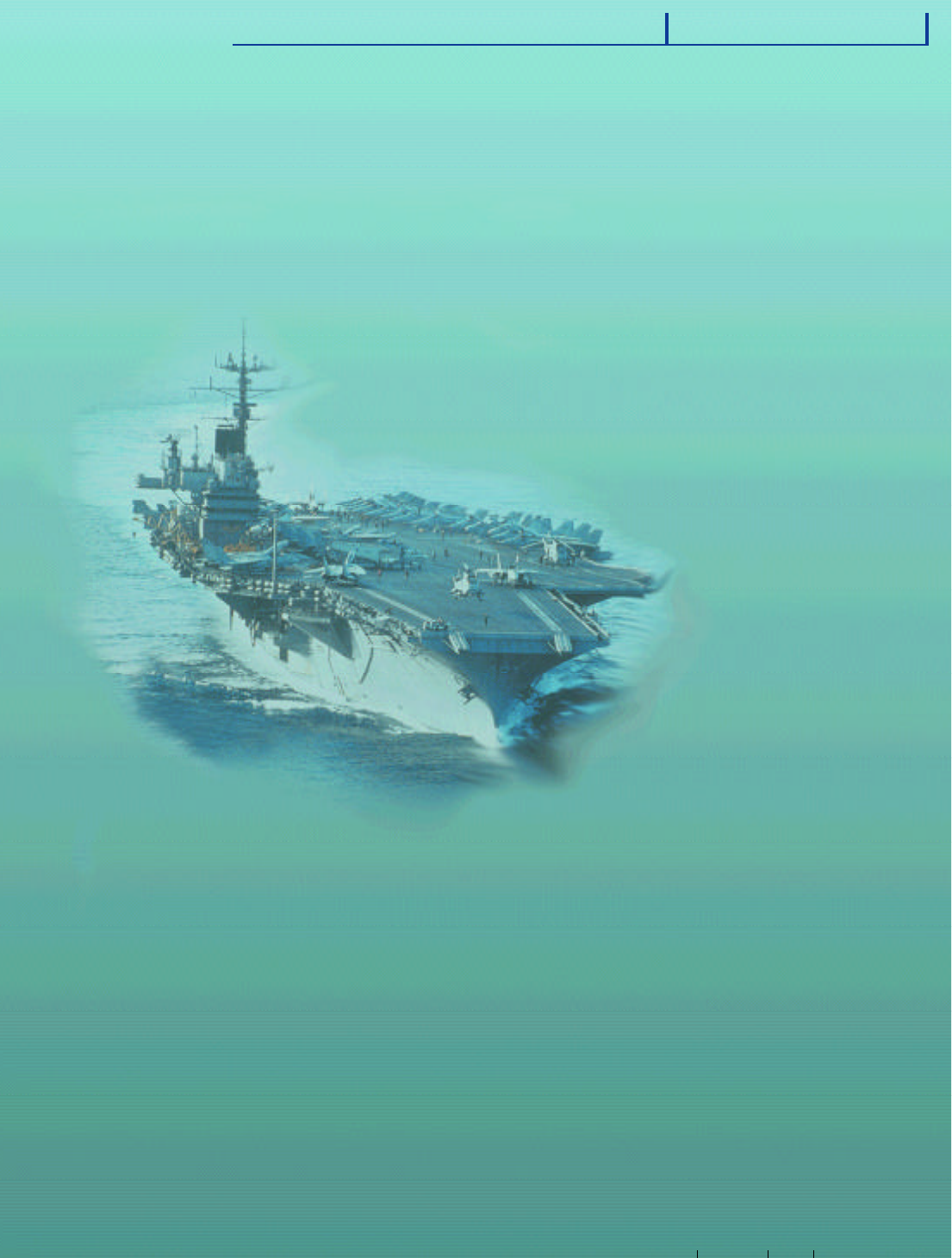
Department of the Navy
Navy Working Capital Fund
Supporting
Consolidating/Combining
Statements
77
FY 2000
AN N UA L FI NA NC I A L RE P O RT
Supporting Consolidating/Combining Statements

78
FY 2000
NAV Y WO R K I NG CA P I TA L FU N D
Supporting Consolidating/Combining Statements
Department of Defense
Navy Working Capital Fund
Consolidating Balance Sheet
As of September 30, 2000
($ in Thousands) Depot Depot Depot
Maintenance Maintenance Maintenance
Shipyards Aviation Marine Corps Ordnance
ASSETS
Intragovernmental:
Fund Balance with Treasury $ 174,518 $ (207,744) $ (25,797) $ 169,859
Investments 0 0 0 0
Accounts Receivable 114,121 37,737 11,362 1,798
Other Assets 15,525 6,838 0 21
Total Intragovernmental Assets $ 304,164 $ (163,169) $ (14,435) $ 171,678
Cash and Other Monetary Assets $ 0 $ 0 $ 0 $ 0
Accounts Receivable 994 (29) 4,479 766
Loans Receivable 0 0 0 0
Inventory and Related Property 230,133 881,900 40,131 2,302
General Property, Plant and Equipment 712,482 334,922 52,595 1,932
Other Assets 98,828 989 4,756 339
TOTAL ASSETS $ 1,346,601 $ 1,054,613 $ 87,526 $ 177,017
LIABILITIES
Intragovernmental:
Accounts Payable $ 39,169 $ 70,727 $ 3,194 $ 4,890
Debt 0 0 0 0
Environmental Liabilities 0 0 0 0
Other Liabilities 31,354 2,496 365 78
Total Intragovernmental Liabilities $ 70,523 $ 73,223 $ 3,559 $ 4,968
Accounts Payable $ (21,138) $ (109,547) $ 8,831 $ 102,061
Military Retirement Benefits and Other
Employment-Related 0 0 22,618 0
Actuarial Liabilities
Environmental Liabilities 0 0 0 0
Loan Guarantee Liability 0 0 0 0
Other Liabilities 361,930 792,221 9,609 19,420
TOTAL LIABILITIES $ 411,315 $ 755,897 $ 44,617 $ 126,449
NET POSITION
Unexpended Appropriations $ 0 $ 0 $ 0 $ 0
Cumulative Results of Operations 935,286 298,716 42,909 50,568
TOTAL NET POSITION $ 935,286 $ 298,716 $ 42,909 $ 50,568
TOTAL LIABILITIES AND NET POSITION $ 1,346,601 $ 1,054,613 $ 87,526 $ 177,017

79
FY 2000
AN N UA L FI NA NC I A L RE P O RT
Supporting Consolidating/Combining Statements
Department of Defense
Navy Working Capital Fund
Consolidating Balance Sheet
As of September 30, 2000
($ in Thousands)
Base Information Research &
ASSETS Transportation Support Services Development
Intragovernmental:
Fund Balance with Treasury $ 86,102 $ 89,947 $ (21,348) $ (718,297)
Investments 0 0 0 0
Accounts Receivable 18,717 184,875 26,089 246,442
Other Assets 0 93 5 1,213
Total Intragovernmental Assets $ 104,819 $ 274,915 $ 4,746 $ (470,642)
Cash and Other Monetary Assets $ 0 $ 0 $ 0 $ 0
Accounts Receivable 168 37,454 0 27,968
Loans Receivable 0 0 0 0
Inventory and Related Property 21,124 108,394 1,402 288,325
General Property, Plant and Equipment 13,645 661,856 2,925 1,993,785
Other Assets 953,974 5,858 2,061 34,584
TOTAL ASSETS $1,093,730 $1,088,477 $ 11,134 $ 1,874,020
LIABILITIES
Intragovernmental:
Accounts Payable $ 31,457 $ 179,201 $ 26,095 $ 46,827
Debt 967,512 0 0 0
Environmental Liabilities 0 0 0 0
Other Liabilities 1,475 4,086 688 44,393
Total Intragovernmental Liabilities $1,000,444 $ 183,287 $ 26,783 $ 91,220
Accounts Payable $ 79,737 $ (34,388) $ 6,988 $ 21,119
Military Retirement Benefits and Other
Employment-Related 0 0 0 0
Actuarial Liabilities
Environmental Liabilities 0 0 0 0
Loan Guarantee Liability 0 0 0 0
Other Liabilities 44,299 362,650 52,821 1,738,565
TOTAL LIABILITIES $ 1,124,480 $ 511,549 $ 86,592 $ 1,850,904
NET POSITION
Unexpended Appropriations $ 0 $ 0 $ 0 $ 0
Cumulative Results of Operations (30,750) 576,928 (75,458) 23,116
TOTAL NET POSITION $ (30,750) $ 576,928 $ (75,458) $ 23,116
TOTAL LIABILITIES AND NET POSITION $1,093,730 $1,088,477 $ 11,134 $ 1,874,020

80
FY 2000
NAV Y WO R K I NG CA P I TA L FU N D
Supporting Consolidating/Combining Statements
Department of Defense
Navy Working Capital Fund
Consolidating Balance Sheet
As of September 30, 2000
($ in Thousands)
Supply Component 2000 2000
Management Level Combined Eliminations Consolidated
ASSETS
I n t ra g o ve r n m e n ta l :
Fund Balance with Tre a s u ry $ 3 51, 7 24 $ 1, 574 , 815 $ 1, 47 3 , 77 9 $ 0 $ 1, 47 3 , 77 9
I n ve stments 0 0 0 0 0
Accounts Re c e i va b l e 24 3 , 6 6 9 1 8 84 , 811 3 01, 3 8 6 5 8 3 , 4 2 5
O ther Assets 4 , 016 0 27, 711 10 , 0 5 4 17, 6 57
Total Intra g o ve r n m e n tal Asset s $ 5 9 9 , 4 0 9 $ 1, 574 , 816 $ 2 , 3 8 6 , 3 01 $ 311, 44 0 $ 2 , 0 74 , 8 61
Cash and Other Moneta ry Assets $ 0 $ 0 $ 0 $ 0 $ 0
Accounts Re c e i v able 4 5 , 7 2 0 5 3 2 , 6 04 6 5 0 ,124 0 6 5 0 ,124
Loans Re c e i v able 0 0 0 0 0
I n ve n to ry and Re l a t ed Pro p e rt y 15 , 2 9 7, 0 0 2 0 16 , 87 0 , 713 0 16 , 87 0 , 7 13
G e n e r al Pro p e rt y, Plant and Equ i p m e n t 344 , 0 3 1 0 4 ,118 ,17 3 0 4 ,118 ,17 3
O ther Assets 27 5 , 6 3 8 0 1, 377, 0 2 7 0 1, 377, 0 27
TOTAL ASSETS $ 16 , 5 61, 8 0 0 $ 2 ,107, 4 2 0 $ 2 5 , 4 0 2 , 3 3 8 $ 311, 44 0 $ 2 5 , 0 9 0 , 8 9 8
LIABILITIES
I n t ra g o ve r n m e n ta l :
Accounts Payable $ 8 8 5 , 5 2 0 $ 1 $ 1, 2 87, 0 8 1 $ 3 01, 3 8 6 $ 9 8 5 , 6 9 5
Debt 0 0 9 6 7, 512 0 9 67, 512
E nv i ro n m e n tal Liabilities 0 0 0 0 0
O ther Liabilities 1, 2 71 0 8 6 , 2 0 6 10 , 0 5 4 76 ,15 2
Total Intra g o ve r n m e n tal Liabilities $ 8 8 6 , 7 9 1 $ 1 $ 2 , 34 0 , 7 9 9 $ 311, 44 0 $ 2 , 0 2 9 , 3 5 9
Accounts Paya b l e $ 24 2 , 0 2 0 $ ( 1, 3 3 0 , 6 6 2 ) $ ( 1, 0 34 , 97 9 ) $ 0 $ ( 1, 0 34 , 97 9 )
M i l i ta ry Ret i r ement Benefits and Other
E mp l oy m e n t - Re l a te d 0 1, 2 01, 2 9 6 1, 2 2 3 , 914 0 1, 2 2 3 , 914
Ac t u a rial Liabilities
E nv i ro n m e n tal Liabilities 0 0 0 0 0
Loan Guara n t ee Liability 0 0 0 0 0
O ther Liabilities 44 9 ,13 8 ( 4 8 , 7 8 3 ) 3 , 7 81, 87 0 0 3 , 7 81, 87 0
TOTAL LIABILITIES $ 1, 5 77, 94 9 $ ( 17 8 , 14 8 ) $ 6 , 311, 6 04 $ 311, 44 0 $ 6 , 0 0 0 ,164
NET POSITION
Un expended Appro p riations $ 0 $ 0 $ 0 $ 0 $ 0
C u m u l a t i v e Results of Opera t i o n s 14 , 9 8 3 , 8 51 2 , 2 8 5 , 5 6 8 19 , 0 9 0 , 7 3 4 0 19 , 0 9 0 , 7 34
TOTAL NET POSITION $ 14 , 9 8 3 , 8 5 1 $ 2 , 2 8 5 , 5 6 8 $ 19 , 0 9 0 , 7 3 4 $ 0 $ 19 , 0 9 0 , 7 3 4
TOTAL LIABILITIES AND NET POSITION $ 16 , 5 61, 8 0 0 $ 2 ,107, 4 2 0 $ 2 5 , 4 0 2 , 3 3 8 $ 311, 44 0 $ 2 5 , 0 9 0 , 8 9 8

81
FY 2000
AN N UA L FI NA NC I A L RE P O RT
Supporting Consolidating/Combining Statements
Department of Defense
Navy Working Capital Fund
Consolidating Statement of Net Cost
For the Year Ended September 30, 2000
($ in Thousands)
Total Eliminations 2000 Consolidated
Program Costs
A. Depot Maintenance, Shipyards
Intragovernmental $ 1,497,656 $ (993,753) $ 503,903
With the Public 554,467 0 554,467
Total Program Cost $ 2,052,123 $ (993,753) $ 1,058,370
(Less: Earned Revenue) (2,138,111) 95,798 (2,042,313)
Net Program Costs $ (85,988) $ (897,955) $ (983,943)
B. Depot Maintenance, Aviation
Intragovernmental $ 1,378,606 $ (818,060) $ 560,546
With the Public 47,657 0 47,657
Total Program Cost $ 1,426,263 $ (818,060) $ 608,203
(Less: Earned Revenue) (1,686,904) 954,361 (732,543)
Net Program Costs $ (260,641) $ 136,301 $ (124,340)
C. Depot Maintenance, Marine Corps
Intragovernmental $ 77,730 $ (21,443) $ 56,287
With the Public 147,715 0 147,715
Total Program Cost $ 225,445 $ (21,443) $ 204,002
(Less: Earned Revenue) (215,592) 0 (215,592)
Net Program Costs $ 9,853 $ (21,443) $ (11,590)
D. Ordnance
Intragovernmental $ 54,076 $ (13,403) $ 40,673
With the Public 277,670 0 277,670
Total Program Cost $ 331,746 $ (13,403) $ 318,343
(Less: Earned Revenue) (272,822) 27,944 (244,878)
Net Program Costs $ 58,924 $ 14,541 $ 73,465
E. Transportation
Intragovernmental $ 821,379 $ (603,610) $ 217,769
With the Public 267,374 0 267,374
Total Program Cost $ 1,088,753 $ (603,610) $ 485,143
(Less: Earned Revenue) (1,294,853) 11,904 (1,282,949)
Net Program Costs $ (206,100) $ (591,706) $ (797,806)
F. Base Support
Intragovernmental $ 961,707 $ (741,067) $ 220,640
With the Public 904,440 0 904,440
Total Program Cost $ 1,866,147 $ (741,067) $ 1,125,080
(Less: Earned Revenue) (1,732,920) 317,155 (1,415,765)
Net Program Costs $ 133,227 $ (423,912) $ (290,685)

82
FY 2000
NAV Y WO R K I NG CA P I TA L FU N D
Supporting Consolidating/Combining Statements
Department of Defense
Navy Working Capital Fund
Consolidating Statement of Net Cost
For the Year Ended September 30, 2000
($ in Thousands)
Total Eliminations 2000 Consolidated
Program Costs
G. Information Services
Intragovernmental $ 155,822 $ (91,782) $ 64,040
With the Public 40,266 0 40,266
Total Program Cost $ 196,088 $ (91,782) $ 104,306
(Less: Earned Revenue) (209,988) 92,521 (117,467)
Net Program Costs $ (13,900) $ 739 $ (13,161)
H. Research & Development
Intragovernmental $ 2,029,095 $ (711,858) $ 1,317,237
With the Public 2,811,381 0 2,811,381
Total Program Cost $ 4,840,476 $ (711,858) $ 4,128,618
(Less: Earned Revenue) (5,118,392) 2,583,773 (2,534,619)
Net Program Costs $ (277,916) $ 1,871,915 $ 1,593,999
I. Supply Management
Intragovernmental $ 3,045,077 $ (379,688) $ 2,665,389
With the Public 2,488,203 0 2,488,203
Total Program Cost $ 5,533,280 $ (379,688) $ 5,153,592
(Less: Earned Revenue) (5,429,552) 291,208 (5,138,344)
Net Program Costs $ 103,728 $ (88,480) $ 15,248
J. Component Level
Intragovernmental $ 0 $ 0 $ 0
With the Public 439,633 0 439,633
Total Program Cost $ 439,633 $ 0 $ 439,633
(Less: Earned Revenue) 0 0 0
Net Program Costs $ 439,633 $ 0 $ 439,633
K. Total Program Costs
Intragovernmental $ 10,021,148 $ (4,374,664) $ 5,646,484
With the Public 7,978,806 0 7,978,806
Total Program Cost $ 17,999,954 $ (4,374,664) $ 13,625,290
(Less: Earned Revenue) (18,099,134) 4,374,664 (13,724,470)
Net Program Costs $ (99,180) $ 0 $ (99,180)
Costs Not Assigned to Programs 0 0 0
(Less: Earned Revenue not attributable to Programs) 0 0 0
Net Cost of Operations $ (99,180) $ 0 $ (99,180)

83
FY 2000
AN N UA L FI NA NC I A L RE P O RT
Supporting Consolidating/Combining Statements
Department of Defense
Navy Working Capital Fund
Consolidating Statement of Changes in Net Position
For the Year Ended September 30, 2000
($ in Thousands)
Depot Depot Depot
Maintenance Maintenance Maintenance
Shipyards Aviation Marine Corps Ordnance
Net Cost of Operations $ (85,989) $(260,641) $ 9,853 $ 58,924
Financing Sources
(other than exchange revenues)
Appropriations Used 0 0 0 0
Taxes and Other Nonexchange Revenue 0 0 0 0
Donations - Nonexchange Revenue 0 0 0 0
Imputed Financing 91,932 50,437 6,978 411
Transfers - In 0 0 0 0
Transfers - Out 0 0 0 (418,821)
Other (269,541) 7,136 0 324,346
Total Financing Sources
(other than Exchange Revenues) $ (177,609) $ 57,573 $ 6,978 $ (94,064)
Net Results of Operations $ (91,620) $ 318,214 $ (2,875) $(152,988)
Prior Period Adjustments 3,520 0 (10,464) 59
Net Change in Cumulative Results
of Operations $ (88,100) $ 318,214 $ (13,339) $(152,929)
Increase (Decrease) in Unexpended
Appropriations 0 0 0 0
Change in Net Position $ (88,100) $ 318,214 $ (13,339) $(152,929)
Net Position-Beginning of the Period 1,023,385 (19,498) 56,248 203,497
Net Position-End of the Period $ 935,285 $ 298,716 $ 42,909 $ 50,568

84
FY 2000
NAV Y WO R K I NG CA P I TA L FU N D
Supporting Consolidating/Combining Statements
Department of Defense
Navy Working Capital Fund
Consolidating Statement of Changes in Net Position
For the Year Ended September 30, 2000
($ in Thousands)
Base Information Research &
Transportation Support Services Development
Net Cost of Operations $ (206,101) $ 133,227 $ (13,900) $ (277,917)
Financing Sources
(other than exchange revenues)
Appropriations Used 0 0 0 0
Taxes and Other Nonexchange Revenue 0 0 0 0
Donations - Nonexchange Revenue 0 0 0 0
Imputed Financing 4,940 35,456 9,484 192,317
Transfers - In 0 0 0 0
Transfers - Out 0 0 0 0
Other 3,417 6,714 11,887 (71,828)
Total Financing Sources
(other than Exchange Revenues) $ 8,357 $ 42,170 $ 21,371 $ 120,489
Net Results of Operations $ 214,458 $ (91,057) $ 35,271 $ 398,406
Prior Period Adjustments 15,423 (9,891) (3) 22
Net Change in Cumulative Results
of Operations $ 229,881 $ (100,948) $ 35,268 $ 398,428
Increase (Decrease) in Unexpended
Appropriations 0 0 0 0
Change in Net Position $ 229,881 $(100,948) $ 35,268 $ 398,428
Net Position-Beginning of the Period (260,631) 677,877 (110,725) (375,311)
Net Position-End of the Period $ (30,750) $ 576,929 $ (75,457) $ 23,117

85
FY 2000
AN N UA L FI NA NC I A L RE P O RT
Supporting Consolidating/Combining Statements
Department of Defense
Navy Working Capital Fund
Consolidating Statement of Changes in Net Position
For the Year Ended September 30, 2000
($ in Thousands)
Supply Component 2000 2000
Management Level Combined Eliminations Consolidated
Net Cost of Operations $ 103,728 $ 439,633 $ (99,183) $ 0 $ (99,183)
Financing Sources
(other than exchange revenues)
Appropriations Used 0 0 0 0 0
Taxes and Other Nonexchange Revenue 0 0 0 0 0
Donations - Nonexchange Revenue 0 0 0 0 0
Imputed Financing 16,811 0 408,766 0 408,766
Transfers - In 77,193 0 77,193 0 77,193
Transfers - Out 0 0 (418,821) 0 (418,821)
Other 3,704,696 0 3,716,827 0 3,716,827
Total Financing Sources
(other than Exchange Revenues) $ 3,798,700 $ 0 $ 3,783,965 $ 0 $ 3,783,965
Net Results of Operations $ 3,694,972 $ (439,633) $ 3,883,148 $ 0 $ 3,883,148
Prior Period Adjustments (2,695,764) 0 (2,697,098) 0 (2,697,098)
Net Change in Cumulative Results
of Operations $ 999,208 $ (439,633) $ 1,186,050 $ 0 $ 1,186,050
Increase (Decrease) in Unexpended
Appropriations 0 0 0 0 0
Change in Net Position $ 999,208 $ (439,633) $ 1,186,050 $ 0 $ 1,186,050
Net Position-Beginning of the Period 13,984,644 2,725,202 17,904,688 0 17,904,688
Net Position-End of the Period $14,983,852 $ 2,285,569 $19,090,738 $ 0 $19,090,738

86
FY 2000
NAV Y WO R K I NG CA P I TA L FU N D
Supporting Consolidating/Combining Statements
Department of Defense
Navy Working Capital Fund
Combining Statement of Budgetary Resources
For the Year Ended September 30, 2000
($ in Thousands)
Depot Depot Depot
Maintenance Maintenance Maintenance
Shipyards Aviation Marine Corps Ordnance
B U D G E TA RY RESOURC E S
B u d g et Au th o ri t y $ 0 $ 0 $ 0 $ 0
Un o b l i g a ted Balance - Beginning of Pe ri o d 74 , 87 3 184 , 916 2 9 , 4 8 0 161, 8 97
Net Tra n s fe r s Pri o r-Year Balance, Ac t u a l 0 0 0 0
Spending Au th o rity from Offs etting
C o l l e c t i o n s 2 , 2 84 , 5 3 6 1, 7 8 6 ,115 27 3 , 27 3 2 6 , 2 71
Ad j u st m e n t s ( 2 0 , 7 8 6 ) ( 3 , 47 2 ) ( 7 0 5 ) ( 1, 8 9 6 )
Total Budgeta ry Re s o u rc e s $ 2 , 3 3 8 , 6 2 3 $ 1, 9 67, 5 5 9 $ 3 0 2 , 04 8 $ 18 6 , 27 2
STATUS OF BUDGETA RY RESOURC E S
Obligations Incurre d $ 2 , 4 3 0 , 516 $ 1, 6 97, 9 0 4 $ 247, 3 3 3 $ 191, 9 6 9
Un o b l i g a ted Balances - Ava i l a b l e ( 91, 8 9 3 ) 2 6 9 , 6 5 5 54 , 715 ( 5 , 6 97 )
Un o b l i g a t ed Balances - Not Ava i l a b l e 0 0 0 0
Total, Status of Budgeta ry Re s o u rc e s $ 2 , 3 3 8 , 6 2 3 $ 1, 9 67, 5 5 9 $ 3 0 2 , 04 8 $ 18 6 , 27 2
O U T LAYS
Obligations Incurre d $ 2 , 4 3 0 , 5 16 $ 1, 6 97, 9 0 4 $ 247, 3 3 3 $ 191, 9 6 9
Less: Spending Au th o rity from Offs etting
Collections and Ad j u st m e n t s ( 2 , 2 84 , 5 3 6 ) ( 1, 7 8 6 ,115 ) ( 27 3 , 27 3 ) ( 2 6 , 271 )
O b l i g a ted Balance, Net
- Beginning of Pe ri o d 618 , 8 8 7 9 51, 8 5 3 ( 2 3 , 3 04 ) 3 3 , 9 6 5
O b l i g a t ed Balance Tra n s fe rred, Net 0 0 0 0
Less: Obligated Balance, Net
- End of Pe ri o d ( 7 5 3 , 4 0 9 ) ( 7 8 3 , 57 0 ) 3 2 , 8 37 ( 2 37, 2 8 5 )
Total Outlays $ 11, 4 5 8 $ 8 0 , 07 2 $ ( 16 , 4 07 ) $ ( 37, 6 2 2 )

87
FY 2000
AN N UA L FI NA NC I A L RE P O RT
Supporting Consolidating/Combining Statements
Department of Defense
Navy Working Capital Fund
Combining Statement of Budgetary Resources
For the Year Ended September 30, 2000
($ in Thousands)
Base Information Research &
Transportation Support Services Development
B U D G E TA RY RESOURC E S
B u d get Au th o ri t y $ 5 , 5 9 9 $ 0 $ 161 $ 5 , 8 16
Un o b l i g a ted Balance - Beginning of Pe ri o d 7 3 0 , 310 ( 2 6 , 3 47 ) 5 3 ,14 6 244 , 27 9
Net Tra n s fe rs Pri o r-Year Balance, Ac t u a l 0 0 0 0
Spending Au th o rity from Offs e tting
C o l l e c t i o n s 1, 2 54 , 7 0 2 1, 6 5 5 , 9 8 6 19 3 ,12 3 8 , 214 , 3 8 9
Ad j u st m e n t s ( 7 2 , 7 94 ) ( 5 9 ) 0 0
Total Budgeta ry Re s o u rc e s $ 1, 917, 817 $ 1, 6 2 9 , 5 8 0 $ 24 6 , 4 3 0 $ 8 , 4 64 , 4 84
STATUS OF BUDGETA RY RESOURC E S
Obligations Incurre d $ 1, 7 74 , 8 6 6 $ 1, 5 04 , 6 0 4 $ 219 , 24 9 $ 7, 9 6 0 , 9 5 9
Un o b l i g a t ed Balances - Ava i l a b l e 14 2 , 9 51 124 , 976 27,181 5 0 3 , 5 2 5
Un o b l i g a t ed Balances - Not Ava i l a b l e 0 0 0 0
Total, Status of Budgeta ry Re s o u rc e s $ 1, 917, 817 $ 1, 6 2 9 , 5 8 0 $ 24 6 , 4 3 0 $ 8 , 4 64 , 4 84
O U T LAYS
Obligations Incurre d $ 1, 7 74 , 8 6 6 $ 1, 5 04 , 6 04 $ 219 , 24 9 $ 7, 9 6 0 , 9 5 9
Less: Spending Au th o rity from Offs e tting
Collections and Ad j u st m e n t s ( 1, 2 54 , 7 0 2 ) ( 1, 6 5 5 , 9 8 6 ) ( 19 3 , 12 3 ) ( 8 , 2 14 , 3 8 9 )
O b l i g a t ed Balance, Net
- Beginning of Pe ri o d ( 2 2 8 , 04 2 ) 241, 4 2 3 4 8 , 4 8 6 418 , 3 37
O b l i g a t ed Balance Tra n s fe rred, Net 0 0 0 0
Less: Obligated Balance, Net
- End of Pe ri o d ( 2 8 2 , 5 47 ) ( 10 3 , 44 9 ) ( 61, 7 9 9 ) ( 3 3 0 , 67 8 )
Total Outlays $ 9 , 57 5 $ ( 13 , 4 0 8 ) $ 12 , 813 $ ( 16 5 , 771 )

88
FY 2000
NAV Y WO R K I NG CA P I TA L FU N D
Supporting Consolidating/Combining Statements
Department of Defense
Navy Working Capital Fund
Combining Statement of Budgetary Resources
For the Year Ended September 30, 2000
($ in Thousands)
Supply
Management Component Level 2000 Combined
BUDGETARY RESOURCES
Budget Authority $ 551,779 $ 0 $ 563,355
Unobligated Balance - Beginning of Period 24,270 985,494 2,462,318
Net Transfers Prior-Year Balance, Actual 61,600 0 61,600
Spending Authority from Offsetting Collections 4,964,837 0 20,653,232
Adjustments (33,223) 0 (132,935)
Total Budgetary Resources $ 5,569,263 $ 985,494 $ 23,607,570
STATUS OF BUDGETARY RESOURCES
Obligations Incurred $ 5,491,014 $ 0 $ 21,518,414
Unobligated Balances - Available 78,251 985,494 2,089,158
Unobligated Balances - Not Available (2) 0 (2)
Total, Status of Budgetary Resources $ 5,569,263 $ 985,494 $ 23,607,570
OUTLAYS
Obligations Incurred $ 5,491,014 $ 0 $ 21,518,414
Less: Spending Authority from Offsetting
Collections and Adjustments (4,964,837) 0 (20,653,232)
Obligated Balance, Net - Beginning of Period 2,165,228 (1,781,938) 2,444,895
Obligated Balance Transferred, Net 0 0 0
Less: Obligated Balance, Net - End of Period (2,804,076) 1,693,114 (3,630,862)
Total Outlays $ (112,671) $ (88,824) $ (320,785)

89
FY 2000
AN N UA L FI NA NC I A L RE P O RT
Supporting Consolidating/Combining Statements
Department of Defense
Navy Working Capital Fund
Combining Statement of Financing
For the Year Ended September 30, 2000
($ in Thousands)
Depot Depot Depot
Maintenance Maintenance Maintenance
Shipyards Aviation Marine Corps Ordnance
1. O B L I GATIONS AND NO N B U D G E TA R Y RESOURC E S
A. Obligations Incurre d $ 2 , 4 3 0 , 516 $ 1, 6 97, 9 04 $ 247, 3 3 3 $ 191, 9 6 9
B . Less: Spending Au th o rity for Offs e tting
Collections and Ad j u st m e n t s ( 2 , 2 84 , 5 3 6 ) ( 1, 7 8 6 ,115 ) ( 27 3 , 27 3 ) ( 2 6 , 2 71 )
C . Donations Not in the Entity's Budget 0 0 0 0
D . Financing Imp u t ed for Cost Subsidies 91, 9 3 2 5 0 , 4 37 6 , 97 8 411
E . Tra n s fe rs-In (Out) - Fi n a n c i n g 0 0 0 0
F. Less: Exch a n ge Revenue Not in the Entity's Budget 0 0 0 ( 244 , 877 )
G . No n e xch a n ge Revenue Not in the Entity's Budget 0 0 0 0
H . Less: Tru s t or Special Fund Re c e i pts Re l a t ed
to Exch a n ge in the Entity's Budget 0 0 0 0
I . O th e r 0 0 0 0
J . Total Obligations as Ad j u sted and
No n b u d g eta ry Re s o u rc e s $ 2 37, 912 $ ( 37, 7 74 ) $ ( 18 , 9 6 2 ) $ ( 7 8 , 76 8 )
2 . R E S O U RCES THAT DO NOT FUND NET CO S T OF OPERAT I O N S
A. C h a n ge in Amount of Goods, Services, and
B e n e fits Ord e r ed but Not Yet Re c e i v ed -
( I n c re a s e s ) / D e c re a s e s $ ( 5 0 5 , 3 6 9 ) $ ( 2 04 , 6 9 5 ) $ 5 , 7 37 $ 76 , 2 84
B . C h a n g e in Un filled Customer Ord e rs 13 0 , 8 37 13 , 6 9 9 7, 0 9 2 ( 24 6 , 6 0 2 )
C . C o sts Capitalized on the Balance Sheet
- (Incre a s e s ) / D e c re a s e s 11, 6 07 ( 6 2 , 5 9 3 ) 617 3 0 8 , 0 10
D . Financing Sources that Fund Costs of Prior Pe ri o d s 0 0 ( 10 , 4 64 , 0 5 9 ) 0
E . Collections that Decrease Credit Pro g ram
Re c e i v ables or Increase Credit Pro g r am Liabilities0 0 0 0
F. Ad j u s tments for Tru st Fund Outlays that
Do Not Affect Net Cost 0 0 0 0
G . O ther - (Incre a s e s ) / D e c re a s e s 0 0 0 0
H . Total Re s o u r ces That Do Not Fund Net Costs
of Opera t i o n s $ ( 3 6 2 , 9 2 5 ) $ ( 2 5 3 , 5 8 9 ) $ 2 , 9 8 2 $ 137, 6 9 2

90
FY 2000
NAV Y WO R K I NG CA P I TA L FU N D
Supporting Consolidating/Combining Statements
Department of Defense
Navy Working Capital Fund
Combining Statement of Financing
For the Year Ended September 30, 2000
($ in Thousands)
Depot Depot Depot
Maintenance Maintenance Maintenance
Shipyards Aviation Marine Corps Ordnance
3 . CO M P O N E N TS OF CO STS OF OPERATIONS
T H AT DO NOT REQUIRE OR GENERATE RESOURC E S
A. D e p r eciation and Amort i z a t i o n $ 3 9 , 0 2 3 $ 3 5 , 4 5 0 $ 3 , 216 $ 0
B . Bad Debts Re l a ted to Un c o l l e c table
No n - C redit Re form Re c e i va b l e s 0 0 0 0
C . Revaluation of Assets and Liabilities
- Incre a s e s / ( D e c re a s e s ) 0 0 0 0
D . Loss of Disposition of Asset s 0 0 0 0
E . O ther - Incre a s e s / ( D e c re a s e s ) 0 ( 4 , 7 27 ) 0 0
F. Total Costs That Do Not Re qu i r e Re s o u rc e s $ 3 9 , 0 2 3 $ 3 0 , 7 2 3 $ 3 , 216 $ 0
4 . F I NA NC I NG SOURCES YET TO BE PROV I D E D $ 0 $ 0 $ 2 2 , 618 $ 0
5 . NET CO S T OF OPERAT I O N S $ ( 8 5 , 9 9 0 ) $ ( 2 6 0 , 64 0 ) $ 9 , 8 54 $ 5 8 , 9 2 4

91
FY 2000
AN N UA L FI NA NC I A L RE P O RT
Supporting Consolidating/Combining Statements
Department of Defense
Navy Working Capital Fund
Combining Statement of Financing
For the Year Ended September 30, 2000
($ in Thousands)
Base Information Research &
Transportation Support Services Development
1. O B L I GATIONS AND NO N B U D G E TA RY RESOURC E S
A. Obligations Incurre d $ 1, 7 74 , 8 6 6 $ 1, 5 04 , 6 04 $ 219 , 24 9 $ 7, 9 6 0 , 9 5 9
B . Less: Spending Au th o rity for Offs e tting
Collections and Ad j u st m e n t s ( 1, 2 54 , 7 0 2 ) ( 1, 6 5 5 , 9 8 6 ) ( 19 3 , 12 3 ) ( 8 , 214 , 3 8 9 )
C . Donations Not in the Entity's Budget 0 0 0 0
D . Financing Imp u t ed for Cost Subsidies 4 , 94 0 3 5 , 4 5 6 9 , 4 84 19 2 , 317
E . Tra n s fe rs-In (Out) - Fi n a n c i n g 0 0 0 0
F. Less: Exch a n ge Revenue Not in the Entity's Budget 0 ( 2 , 2 41 ) 0 ( 4 8 , 34 3 )
G . No n exch a n g e Revenue Not in the Entity's Budget 0 0 0 0
H . Less: Tru st or Special Fund Re c e i pts Re l a t ed
to Exch a n g e in the Entity's Budget 0 0 0 0
I . O th e r 0 0 0 0
J . Total Obligations as Ad j u sted and
No n b u d g eta ry Re s o u rc e s $ 5 2 5 ,104 $ ( 118 ,167 ) $ 3 5 , 610 $ ( 10 9 , 4 5 6 )
2 . R E S O U RCES THAT DO NOT FUND NET CO ST OF OPERAT I O N S
A. C h a n g e in Amount of Goods, Services, and
B e n e fits Ord e r ed but Not Yet Re c e i v ed -
( I n c re a s e s ) / D e c re a s e s $ ( 617, 7 3 0 ) $ 2 5 9 , 2 94 $ ( 2 2 , 7 2 8 ) $ ( 6 0 5 , 7 0 5 )
B . C h a n ge in Un filled Customer Ord e rs ( 41, 2 6 8 ) ( 116 , 3 37 ) ( 18 ,17 8 ) 311,161
C . C o s ts Capitalized on the Balance Sheet
- (Incre a s e s ) / D e c re a s e s ( 8 0 , 7 57 ) 101, 0 01 ( 9 ,13 5 ) 34 , 0 5 2
D . Financing Sources that Fund Costs of Prior Pe ri o d s 0 ( 9 , 313 ) 0 0
E . Collections that Decrease Credit Pro g r am
Re c e i v ables or Increase Credit Pro g ram Liabilities 0 0 0 0
F. Ad j u s tments for Tru st Fund Outlays that
Do Not Affect Net Cost 0 0 0 0
G . O ther - (Incre a s e s ) / D e c re a s e s 0 0 0 0
H . Total Re s o u r ces That Do Not Fund Net Costs
of Opera t i o n s $ ( 7 3 9 , 7 5 5 ) $ 2 34 , 64 5 $ ( 5 0 , 0 41 ) $ ( 2 6 0 , 4 9 2 )

92
FY 2000
NAV Y WO R K I NG CA P I TA L FU N D
Supporting Consolidating/Combining Statements
Department of Defense
Navy Working Capital Fund
Combining Statement of Financing
For the Year Ended September 30, 2000
($ in Thousands)
Base Information Research &
Transportation Support Services Development
3 . CO M P O N E N TS OF CO STS OF OPERATIONS
T H AT DO NOT REQUIRE OR GENERATE RESOURC E S
A. D e p r eciation and Amort i z a t i o n $ 8 , 5 5 0 $ 15 , 94 8 $ 5 31 $ 9 2 , 377
B . Bad Debts Re l a ted to Un c o l l e c table
No n - C redit Re form Re c e i va b l e s 0 0 0 0
C . Revaluation of Assets and Liabilities
- Incre a s e s / ( D e c re a s e s ) 0 0 0 0
D . Loss of Disposition of Asset s 0 0 0 0
E . O ther - Incre a s e s / ( D e c re a s e s ) 0 8 0 2 0 ( 347 )
F. Total Costs That Do Not Re qu i r e Re s o u rc e s $ 8 , 5 5 0 $ 16 , 7 5 0 $ 5 31 $ 9 2 , 0 3 0
4 . F I NA NC I NG SOURCES YET TO BE PROV I D E D $ 0 $ 0 $ 0 $ 0
5 . NET CO S T OF OPERAT I O N S $ ( 2 0 6 ,101 ) $ 13 3 , 2 2 8 $ 13 , 9 0 0 $ ( 2 77, 918 )

93
FY 2000
AN N UA L FI NA NC I A L RE P O RT
Supporting Consolidating/Combining Statements
Department of Defense
Navy Working Capital Fund
Combining Statement of Financing
For the Year Ended September 30, 2000
($ in Thousands)
Supply
Management Component Level 2000 Combined
1. O B L I GATIONS AND NO N B U D G E TA R Y RESOURC E S
A. Obligations Incurre d $ 5 , 4 91, 014 $ 0 $ 21, 518 , 414
B . Less: Spending Au th o rity for Offs e tting
Collections and Ad j u st m e n t s ( 4 , 9 64 , 8 37 ) 0 ( 2 0 , 6 5 3 , 2 3 2 )
C . Donations Not in the Entity's Budget 0 0 0
D . Financing Imp u ted for Cost Subsidies 16 , 811 0 4 0 8 , 76 6
E . Tra n s fe rs-In (Out) - Fi n a n c i n g 8 8 0 8 8
F. Less: Exch a n ge Revenue Not in the Entity's Budget 0 0 ( 2 9 5 , 4 61 )
G . No n e xch a n ge Revenue Not in the Entity's Budget 0 0 0
H . Less: Tru s t or Special Fund Re c e i pts Re l a ted to
E x ch a n ge in the Entity's Budget 0 0 0
I . O th e r 0 0 0
J . Total Obligations as Ad j u sted and
No n b u d g eta ry Re s o u rc e s $ 54 3 , 076 $ 0 $ 97 8 , 57 5
2 . R E S O U RCES THAT DO NOT FUND NET CO S T OF OPERAT I O N S
A. C h a n ge in Amount of Goods, Services, and
B e n e fits Ord e r ed but Not Yet Re c e i ved -
( I n c re a s e s ) / D e c re a s e s $ 2 8 6 , 0 6 9 $ 344 , 5 8 9 $ ( 9 84 , 2 54 )
B . C h a n ge in Un filled Customer Ord e rs ( 3 5 6 , 9 51 ) 0 ( 316 , 547 )
C . C o sts Capitalized on the Balance Sheet
- (Incre a s e s ) / D e c re a s e s ( 1, 77 8 , 9 2 5 ) 0 ( 1, 4 76 ,12 3 )
D . Financing Sources that Fund Costs of Prior Pe ri o d s 4 , 8 31 0 ( 14 , 94 6 )
E . Collections that Decrease Credit Pro g ram Re c e i vables
or Increase Credit Pro g ram Liabilities 0 0 0
F. Ad j u stments for Tru s t Fund Outlays that
Do Not Affect Net Cost 0 0 0
G . O ther - (Incre a s e s ) / D e c re a s e s 0 0 0
H . Total Re s o u r ces That Do Not Fund Net Costs
of Opera t i o n s $ ( 1, 844 , 976 ) $ 344 , 5 8 9 $ ( 2 , 7 91, 87 0 )

94
FY 2000
NAV Y WO R K I NG CA P I TA L FU N D
Supporting Consolidating/Combining Statements
Department of Defense
Navy Working Capital Fund
Combining Statement of Financing
For the Year Ended September 30, 2000
($ in Thousands)
Supply
Management Component Level 2000 Combined
3 . CO M P O N E N TS OF CO STS OF OPERATIONS THAT DO NOT
REQUIRE OR GENERATE RESOURC E S
A. D e p reciation and Amort i z a t i o n $ 10 , 8 3 5 $ 0 $ 2 0 5 , 9 3 0
B . Bad Debts Re l a ted to Un c o l l e c table No n - C redit Re fo r m 0 0 0
Re c e i va b l e s
C . Revaluation of Assets and Liabilities
- Incre a s e s / ( D e c re a s e s ) 1, 3 94 , 7 9 3 0 1, 3 94 , 7 9 3
D . Loss of Disposition of Asset s 0 0 0
E . O ther - Incre a s e s / ( D e c re a s e s ) 0 0 ( 4 , 27 2 )
F. Total Costs That Do Not Re qu i r e Re s o u rc e s $ 1, 4 0 5 , 6 2 8 $ 0 $ 1, 5 9 6 , 4 51
4 . F I NA NC I NG SOURCES YET TO BE PROV I D E D $ 0 $ 9 5 , 04 5 $ 117, 6 6 3
5 . NET CO S T OF OPERAT I O N S $ 10 3 , 7 2 8 $ 4 3 9 , 6 34 $ ( 9 9 ,181 )
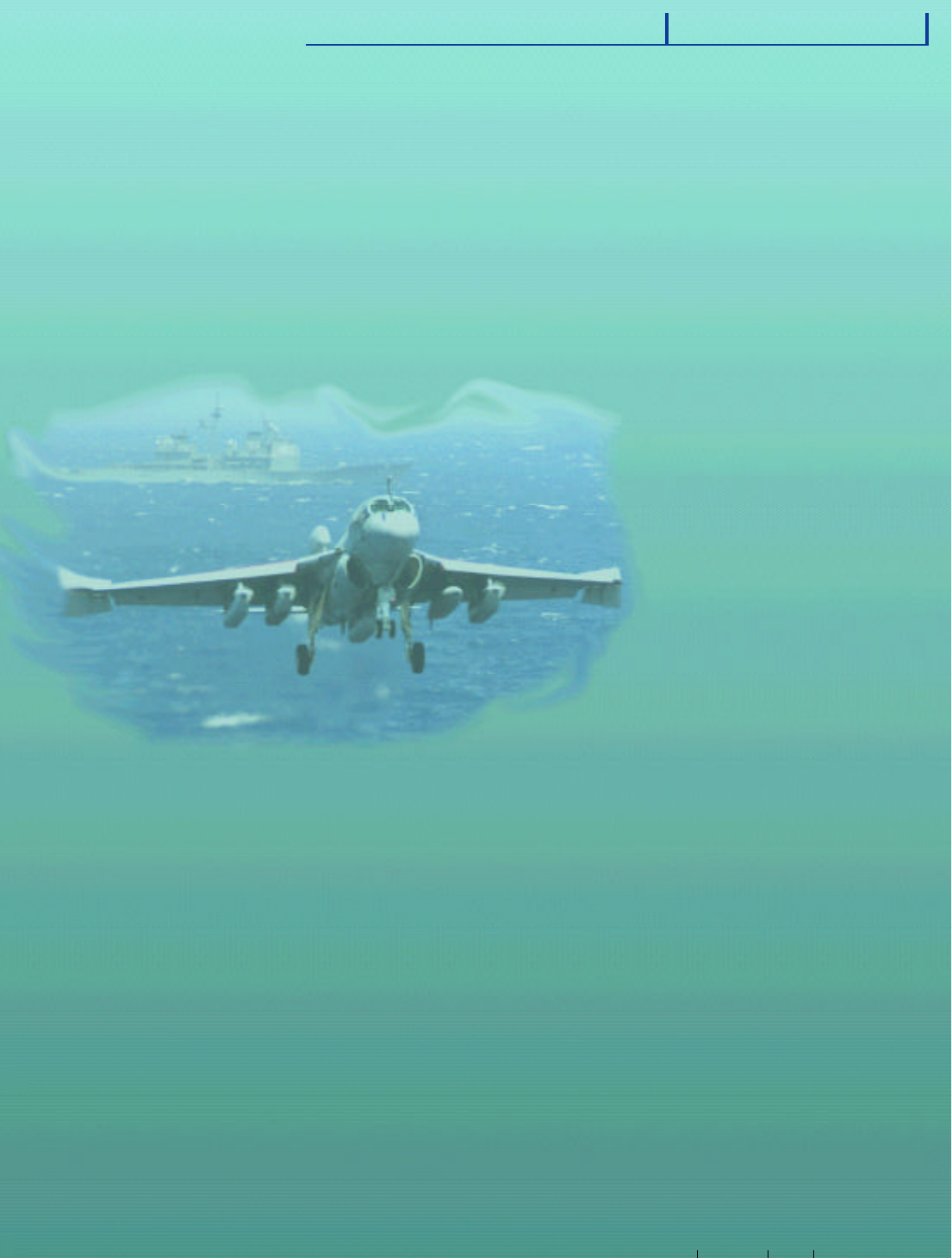
Department of the Navy
Navy Working Capital Fund
Required Supplementary
Information
95
FY 2000
AN N UA L FI NA NC I A L RE P O RT
Re qu i red Supplementa ry Info rm a t i o n

96
FY 2000
NAV Y WO R K I NG CA P I TA L FU N D
Re qu i r ed Supplementa ry Info rm a t i o n
General Property, Plant, and Equipment
Real Property Deferred Maintenance Amounts
As of September 30, 2000
($ in Thousands)
NWCF Property Type/Major Class Amount
1. Real Property
A. Buildings $ 891,031
B. Structures 397,857
2. Total $ 1,288,888
Narrative Statement:
For Navy installations, the reported Backlog of Maintenance and Repair (BMAR) is premised on a
continuous fence-to-fence inspection of facilities at each installation, the results of which are reported
each year in the Annual Inspection Summary (AIS) collected by the Commander, Naval Facilities
Engineering Command (COMNAVFACENGCOM). The AIS is an inventory of each facility's BMAR
deficiencies conducted per the guidelines of the NAVFAC MO-322 and include the cost to repair the
stated deficiencies that remain as a firm requirement at the end of the fiscal year. Deficiencies do not
include alterations, additions, equipment installation, or recurring and preventative maintenance.
The BMAR reported in the above Real Property Deferred Maintenance table includes both "critical"
and "deferrable" maintenance actions as defined in the Office of the Chief of Naval Operations,
OPNAVINST 11010.34B, Instructions for Preparation and Submission of the Type "A" Annual Inspection
Summary and Narrative Assessment. "Critical" deficiencies constitute maintenance actions that should
be done immediately or programmed for accomplishment within the current fiscal year and meets at
least one of the following criteria below:
• Environmental - A deficiency posing an unacceptable risk of environmental damage or violation of
statutory or regulatory requirements.
• Loss of Mission - A deficiency which has degraded mission capability contributing to a C3 or C4
facility condition rating in a standard base report (BASEREP) mission area.
• Safety - A deficiency with a Risk Assessment Code of 1, 2, or 3.
• Quality of Life - A deficiency which has degraded the habitability or use of the barracks, galley,
Morale Welfare and Recreation facilities or other personnel support and service facilities.
Navy categorizes maintenance actions that do not meet the above criteria, as "deferrable" actions and
records are maintained separately by category.

97
FY 2000
AN N UA L FI NA NC I A L RE P O RT
Re qu i red Supplementa ry Info rm a t i o n
BASEREP Rating Procedures:
C1 - Has fully met all demands placed upon it in a mission category throughout the reporting period.
C2 - Has substantially met all demands of the mission category throughout the reporting period with
only minor difficulty.
C3 - Has only marginally met the demands of the mission category throughout the reporting period,
but with major difficulty.
C4 - Has not met vital demand of the mission category.
Risk Assessment Code is an expression of risk that combines the elements of hazard severity and
mishap probability. The codes are:
1 - Critical
2 - Serious
3 - Moderate
4 - Minor
5 - Negligible
For the Marine Corps, facility deficiencies are identified through three primary sources: facilities
inspections performed by our maintenance departments using technical guidance provided by
COMNAVFACENGCOM published MO322 "Inspection of Shore Facilities"; operator inspections (e.g.,
plant operators in our water, heat, and waste water treatment); and customer input.
Locally (activity) funded maintenance actions are summarized by Cost Account Code (CAC) and
reported in summary to Headquarters, Marine Corps (HQMC). Larger actions, above the local
commanders' authority, funded by HQMC (defined as "M2" special projects) which comprise
approximately two-thirds of the total Marine Corps real property backlog, are reported on a project
basis to HQMC and an on-site validation made by HQMC personnel. Marine Corps annotates which
deficiencies are critical and deferrable but all maintenance and repair work remaining as a firm
requirement of the annual plan but lack resources are included as deferred maintenance at year-end.
The Marine Corps only reports BMAR less than four years old in budget exhibits prepared for
Congressional review.
No changes have been made to condition requirements or standards from the previous reporting year.
The Marine Corps data continues to include all qualifying deferred maintenance.

98
FY 2000
NAV Y WO R K I NG CA P I TA L FU N D
Re qu i r ed Supplementa ry Info rm a t i o n
In general, Marine Corps deficiencies that have been identified through one of the methods described
above are evaluated, prioritized and scoped for cost. The work is either accomplished during the
current fiscal year or "deferred" due to lack of resources. The work that is deferred is what is called our
Backlog Maintenance and Repair (BMAR). Costs for demolition of facilities have been excluded from
the BMAR.
Summary information for Navy activities deficiencies can be obtained from a review of the AIS
collected and maintained by COMNAVFACENGCOM. Specific details for each of the deficiencies, by
site and location, can be obtained from the major commands. The Marine Corps maintenance actions
can be reviewed through HQMC. Facility summaries can also be obtained through a review of the
Naval Facilities Assets Data Base (NAVFAC P-164) for both Navy and Marine Corps activities. A listing
of each deficiency is too voluminous for this narrative summary.
The cost assessment survey method is used in developing BMAR data for real property.
The NWCF does not have any material amounts of deferred maintenance for General PP&E Personal
Property.

99
FY 2000
AN N UA L FI NA NC I A L RE P O RT
Re qu i red Supplementa ry Info rm a t i o n
Intragovernmental Eliminations
The OMB requires DoD to prepare stand-alone audited financial statements for eight component
reporting entities, one of which is the NWCF, as well as DoD-wide financial statements. To prepare
reliable consolidated financial statements at successive levels within the federal government, the
effects of transactions occurring among and between entities within the NWCF, the DoD, and the
federal government must be eliminated. However, DoD's accounting systems were designed and
implemented before the requirement for consolidated financial statements existed. Consequently, the
systems in use during FY 2000 did not record the data necessary for accurate, transaction-based
eliminating entries. Therefore, when preparing the FY 2000 NWCF consolidated financial statements,
the NWCF accounting firm (DFAS) implemented interim elimination policies and procedures
developed for DoD-wide use until required systems and process improvements can be implemented.
For FY 2000, the DFAS provided NWCF summary seller-side transactions to the buyer-side
departmental accounting offices and required the adjustment of the buyer-side records to agree with
the seller-side. Internal NWCF balances were eliminated.
In addition, DFAS implemented the policies and procedures contained in Chapter 13 of the DoD FMR
Volume 6B, Fiscal Year 2000 Adjustments, Eliminations, and Other Special Intragovernmental
Reconciliation Procedures. As a result of the procedures, intragovernmental transactions pertaining to
investments in federal securities, borrowings from Treasury and the Federal Financing Bank, Federal
Employee Compensation Act transactions with the Department of Labor, and benefit program
transactions with the Office of Personnel Management were eliminated and reconciled. As further
improvements are made at the government-wide level, DFAS for the NWCF plans on expanding its
eliminating procedures to include additional categories.
In order to comply with the policy and procedures set forth in Chapter 13, consolidated NWCF seller-
side information was distributed to other DFAS centers. Adjustments were made to the NWCF
financial presentation of accounts payable, expenses, and advances and prepayment account
balances, based upon seller-side trading partner information DFAS-CL received from the other DFAS
centers. DFAS-CL was required to reclassify "Intragovernmental" program expenses as "With the
Public" program expenses based upon the totality of seller-side information reported by all NWCF
trading partners. The impact of these adjustments has materially distorted the Net Cost of Operations
on the NWCF financial statements.
Based upon Chapter 13 and at the direction of USD(C), DFAS computed elimination entry amounts for
the Transfers-in and Transfers-out lines on the Statement of Changes in Net Position, to eliminate all
Intragovernmental amounts reported for each NWCF group. For each individual activity group on the
Consolidating Statement of Changes in Net Position, DFAS reviewed Transfers-in (Line 2.E.), Transfers-
out (Line 2.F.), and Other (Line 2.G.) to identify trading partners for amounts originally reported by the
activity group. Amounts for which trading partners could not be identified were reclassified as either a
gain or loss.

100
FY 2000
NAV Y WO R K I NG CA P I TA L FU N D
Re qu i r ed Supplementa ry Info rm a t i o n
For FY 2000 the seller-side elimination entry data for the industrial activities were developed jointly by
DFAS and NWCF activities from field level revenue classification reports, referred to as Summary
Sources of Revenue (SSR). Supplemental information was submitted with this report to include seller-
side data for accounts receivable, advances, progress payments, and detailed federal agency
information. Elimination entry information for industrial activity "buyer" side information is not
available. For supply activities, DFAS produced seller-side and buyer-side elimination entries for the
NWCF. Required elimination data was obtained from several accounting systems: (1) Navy Inventory
Control Point (NAVICP) GO3 Allotment Accounting System; (2) Material Financial Control System
(MFCS); (3) Uniform Automated Data Processing System (UADPS); (4) Defense Business Management
System; and (5) Standard Accounting and Reporting System (STARS).
Intragovernmental transactions are performed at three different levels. Each level provides the
information necessary to properly eliminate certain transactions depending on the consolidation level
of the report. Level 1 represents seller-side transaction data from the NWCF to Other Federal (non-
DoD) Entities. This data is used to prepare eliminating entries for the U.S. Government-wide
Consolidated Financial Statements. Level 2 represents seller-side transaction data from the NWCF to
other entities within DoD. Level 2 data is used to prepare eliminating entries for the DoD agency-wide
Financial Statements. Level 3 represents seller-side data from one NWCF activity to another NWCF
activity. Level 3 data is used to complete the "Eliminations" column on the Consolidating NWCF
statements, and, therefore, is not part of the Required Supplementary Information. Level 3 data is
maintained by DFAS-CL. Eliminating entries are provided on the FY 2000 Balance Sheet, Statement of
Net Cost, and Statement of Changes in Net Position. Eliminating entries are not required, at this time,
for the FY 2000 Statement of Budgetary Resources and the Statement of Financing. DFAS prepared
the following schedules that include Level 1 and Level 2 elimination entry data.
Until standard USD(C) policy for the treatment of elimination transactions is issued and DFAS
implementing procedures and controls are provided, the data disclosed may not meet the intent of the
DoD Guidance on Form and Content of DoD Audited Financial Statements.
See Note 24.B for additional information on eliminating entries.
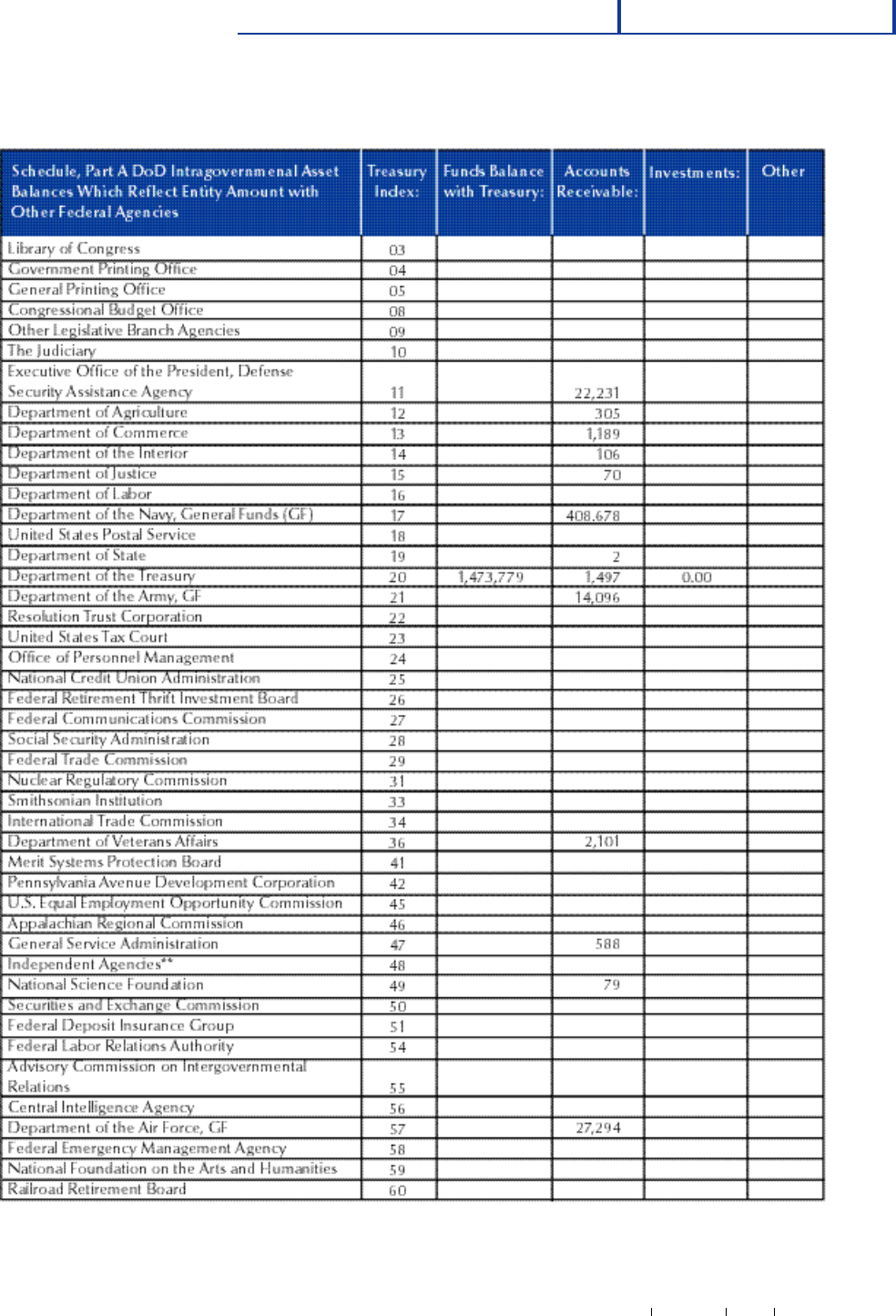
101
FY 2000
AN N UA L FI NA NC I A L RE P O RT
Re qu i red Supplementa ry Info rm a t i o n
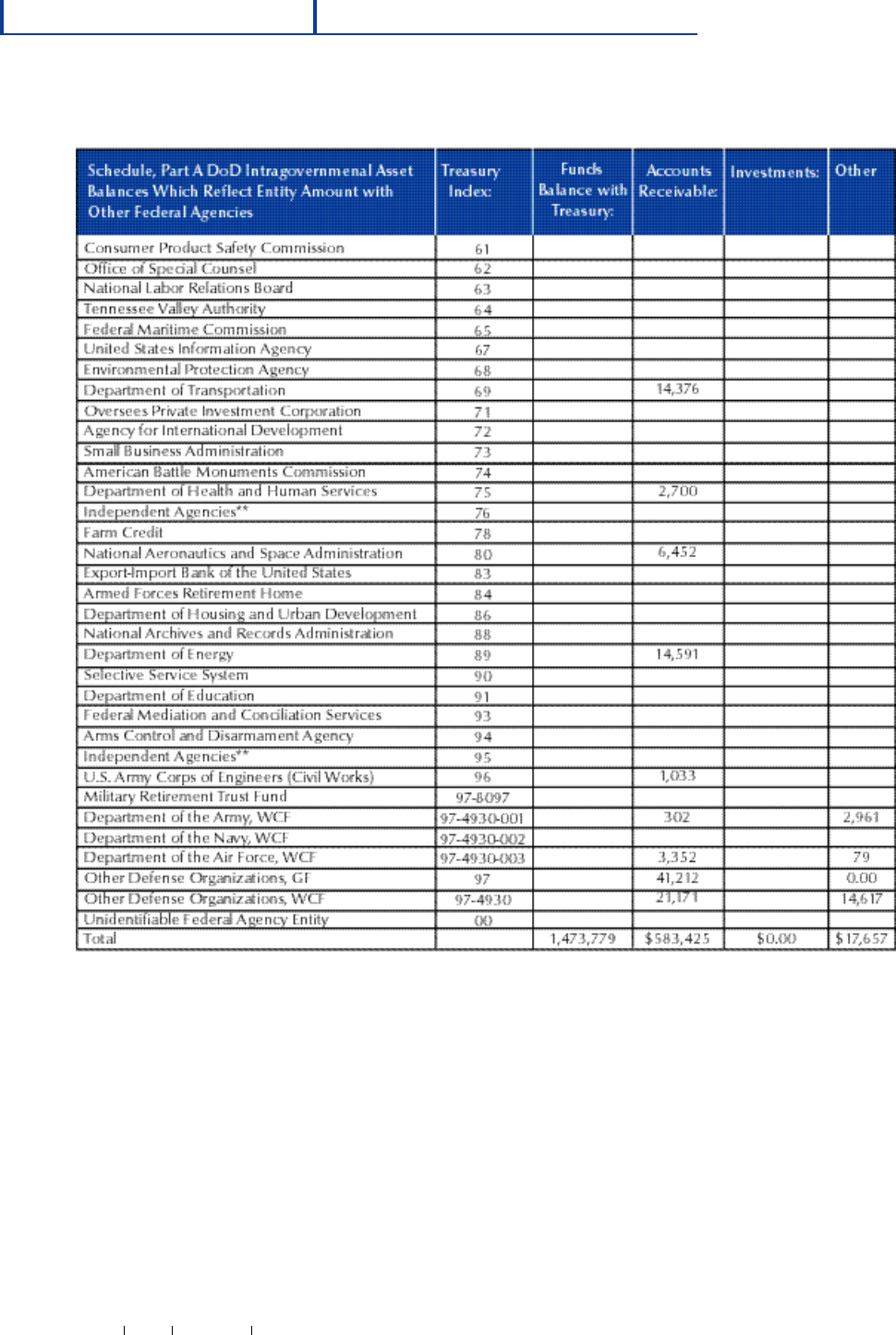
102
FY 2000
NAV Y WO R K I NG CA P I TA L FU N D
Re qu i r ed Supplementa ry Info rm a t i o n
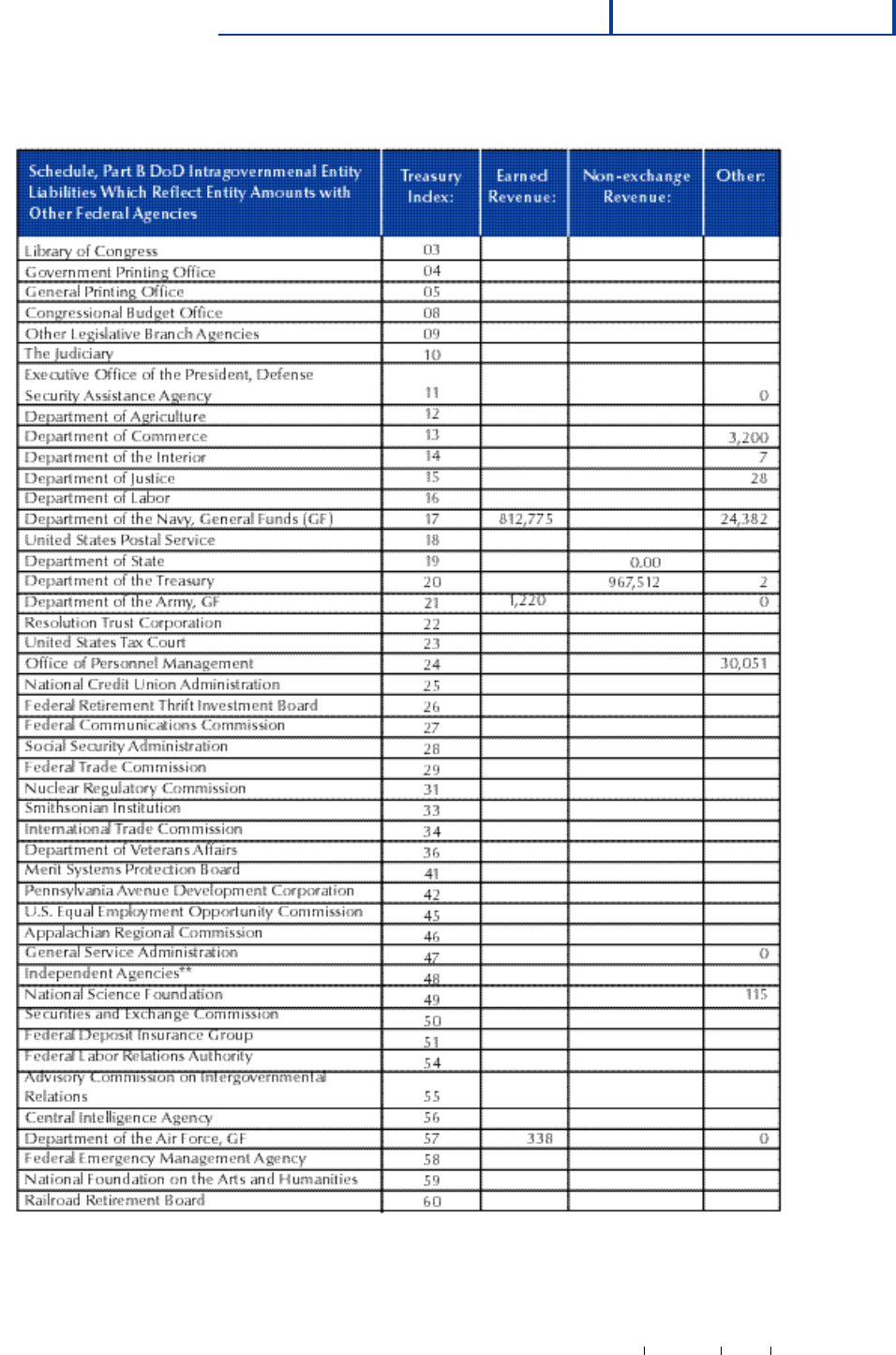
103
FY 2000
AN N UA L FI NA NC I A L RE P O RT
Re qu i red Supplementa ry Info rm a t i o n
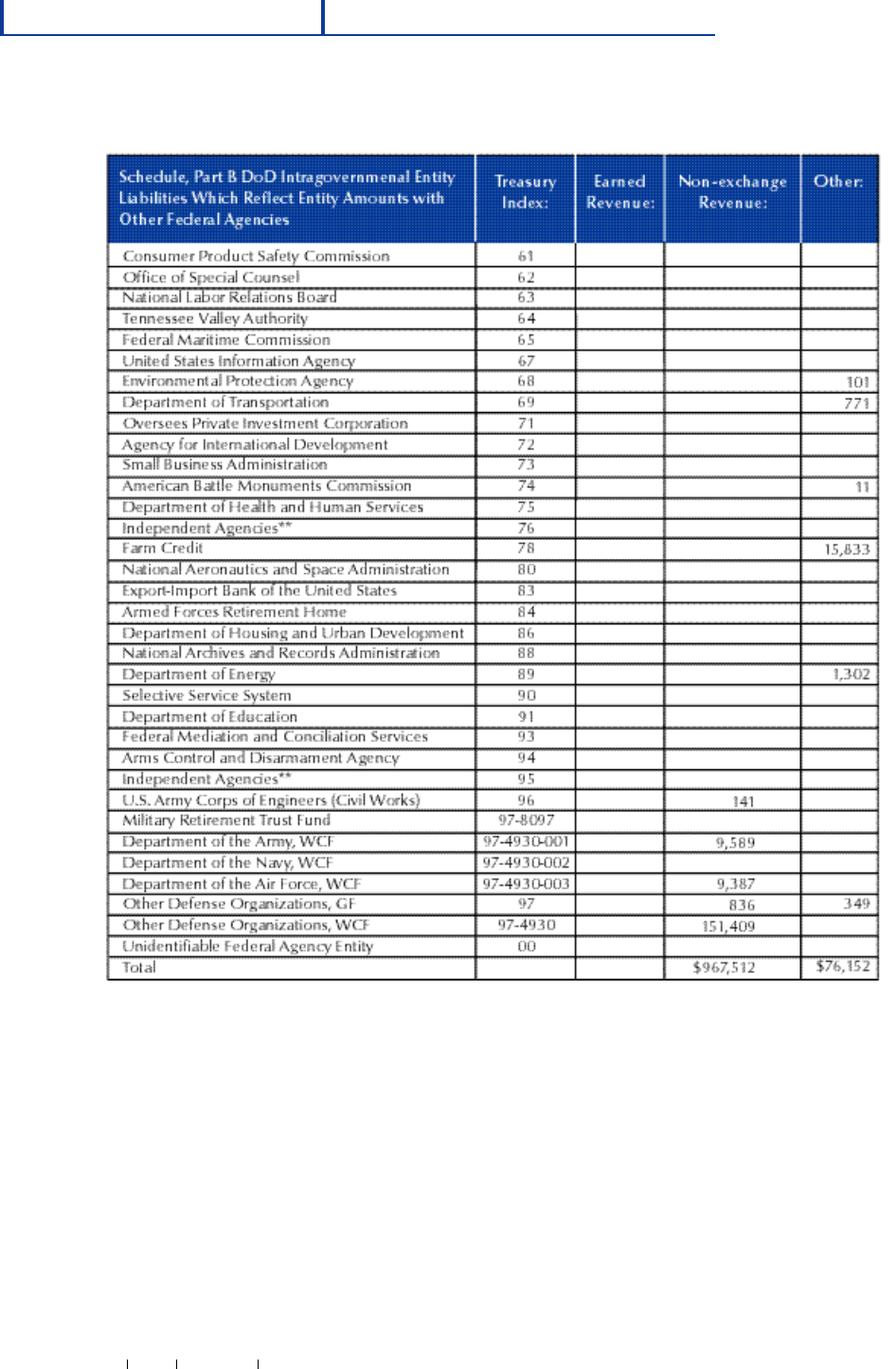
104
FY 2000
NAV Y WO R K I NG CA P I TA L FU N D
Re qu i r ed Supplementa ry Info rm a t i o n
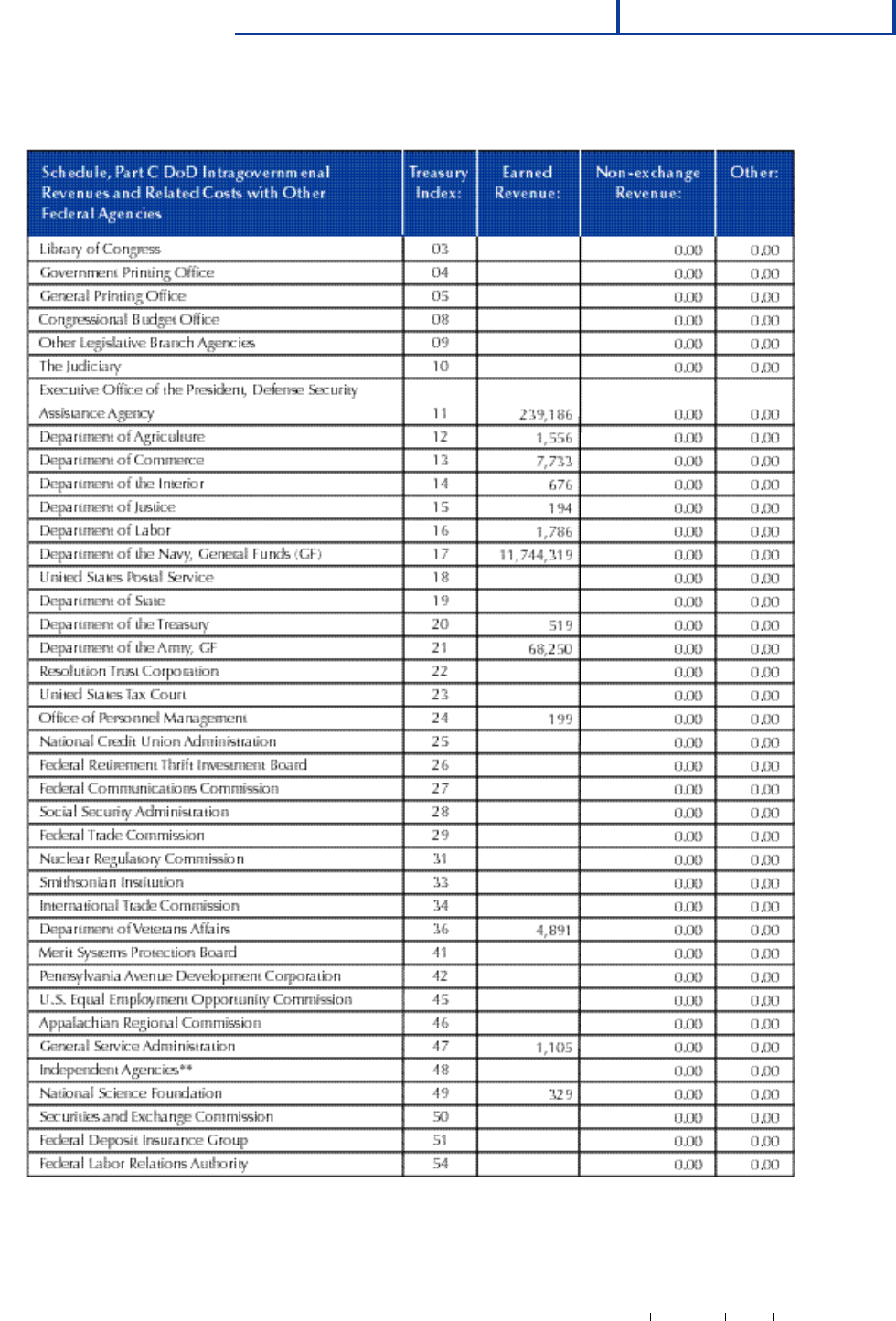
105
FY 2000
AN N UA L FI NA NC I A L RE P O RT
Re qu i red Supplementa ry Info rm a t i o n
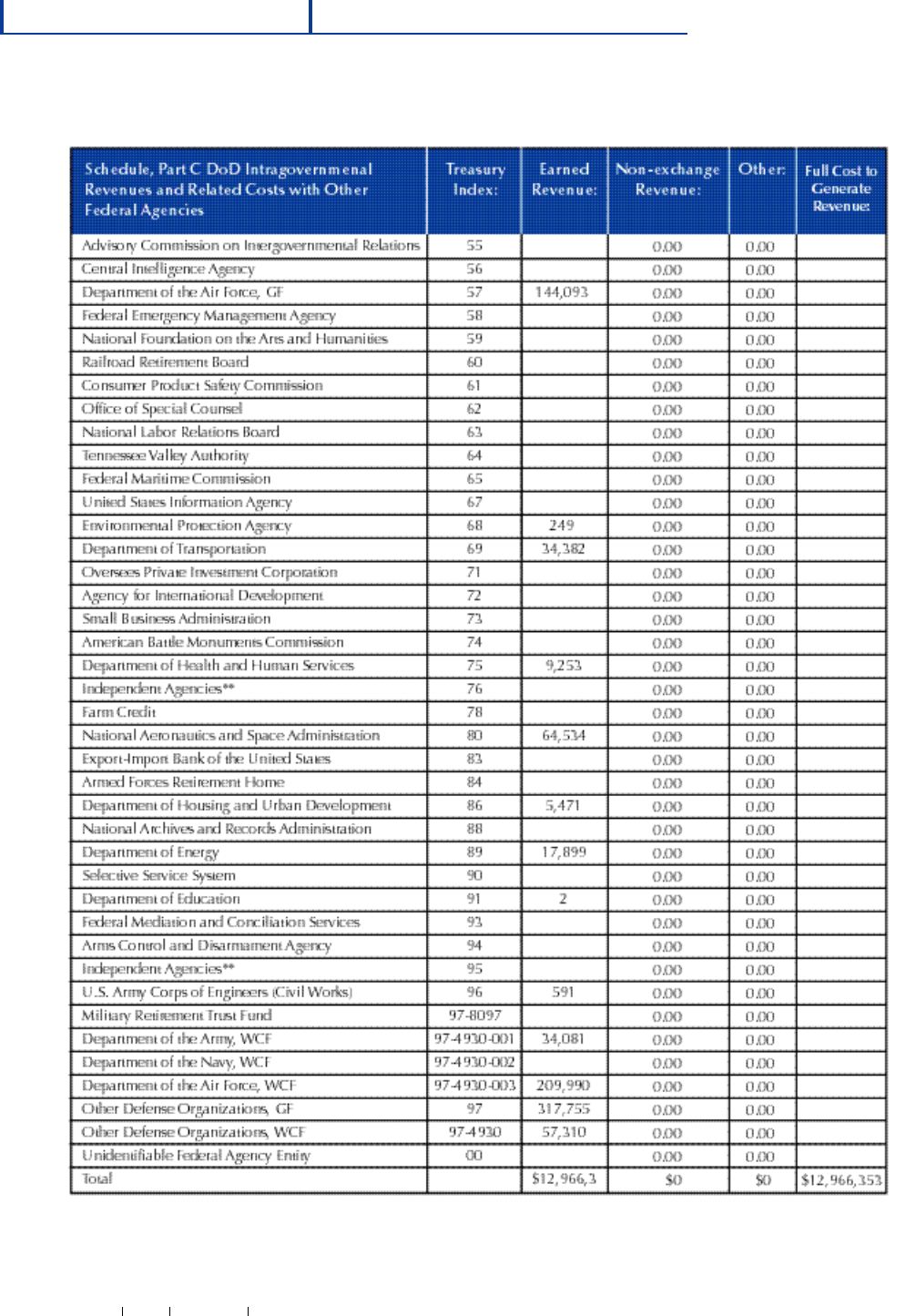
106
FY 2000
NAV Y WO R K I NG CA P I TA L FU N D
Re qu i r ed Supplementa ry Info rm a t i o n
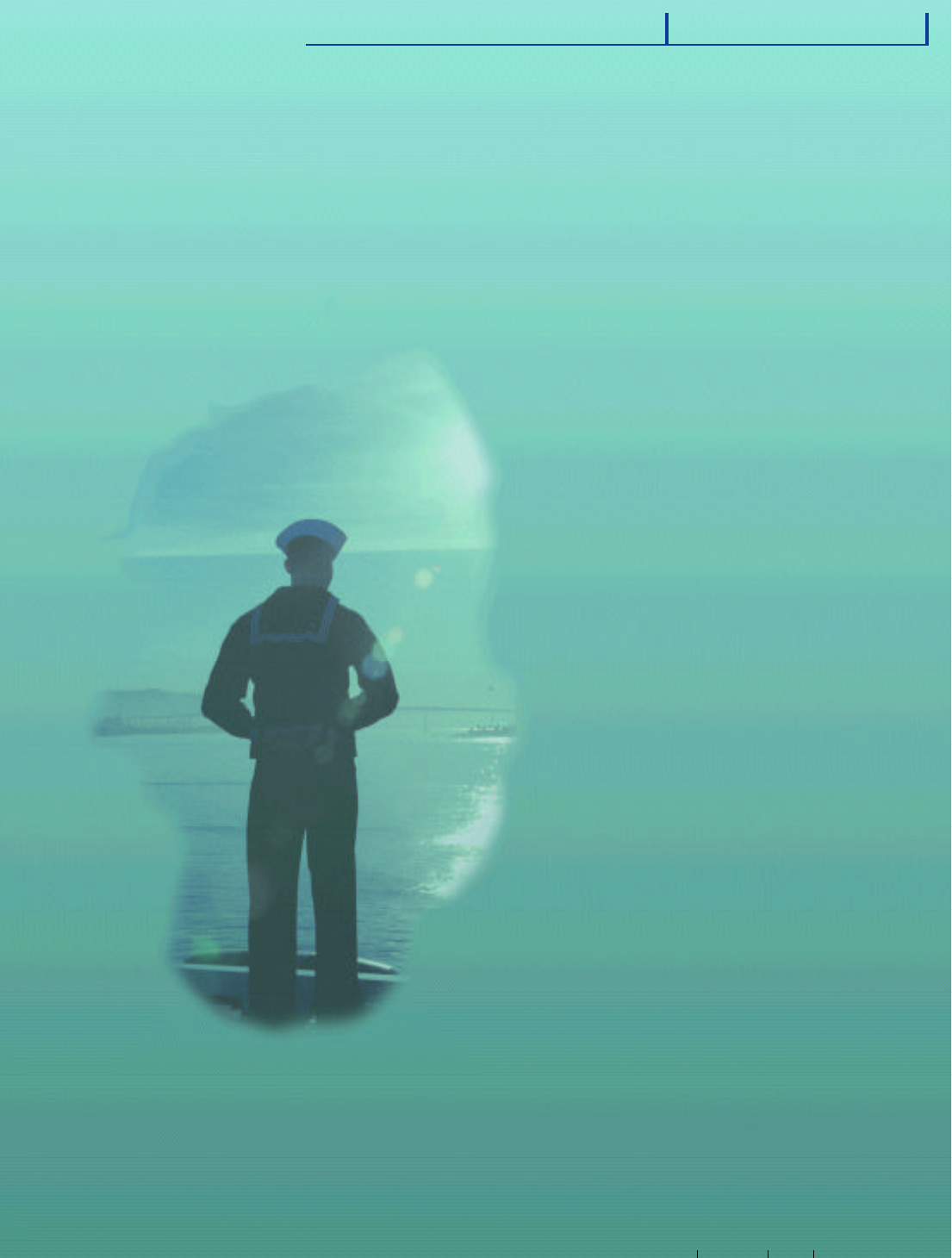
107
FY 2000
AN N UA L FI NA NC I A L RE P O RT
O ther Ac c o mp a n ying Info rm a t i o n
Department of the Navy
Navy Working Capital Fund
Other Accompanying
Information

108
FY 2000
NAV Y WO R K I NG CA P I TA L FU N D
O t her Ac c o mp a nying Info rm a t i o n
Appropriations, Funds, and Accounts Included in the Financial Statements
Reporting Entity
Navy Working Capital Fund
Fund/Account Treasury Symbol and Title:
97X4930 002
Navy Working Capital Fund Activity Group Treasury Symbol and Title:
97X4930.NA1* Depot Maintenance-Shipyards
97X4930.NA2* Depot Maintenance-Aviation
97X4930.NA4* Depot Maintenance- Other (Marine Corps)
97X4930.NA3*
a
Ordnance
97X4930.ND* Transportation
97X4930.NE* * Base Support
97X4930.NF** Information Services
97X4930.NH** Research and Development
97X4930.NC** Supply Management
Notes
* - The "*" represents alpha or numeric characters which identify an activity or reporting segment of the
activity group.
a
- The Ordnance activity group became a part of the DON General Fund in FY 2000. The
Ordnance information included in this report represents residual NWCF accounting for this group.

Department of the Navy
Navy Working Capital Fund
Audit Opinion
109
FY 2000
AN N UA L FI NA NC I A L RE P O RT
Audit Opinion
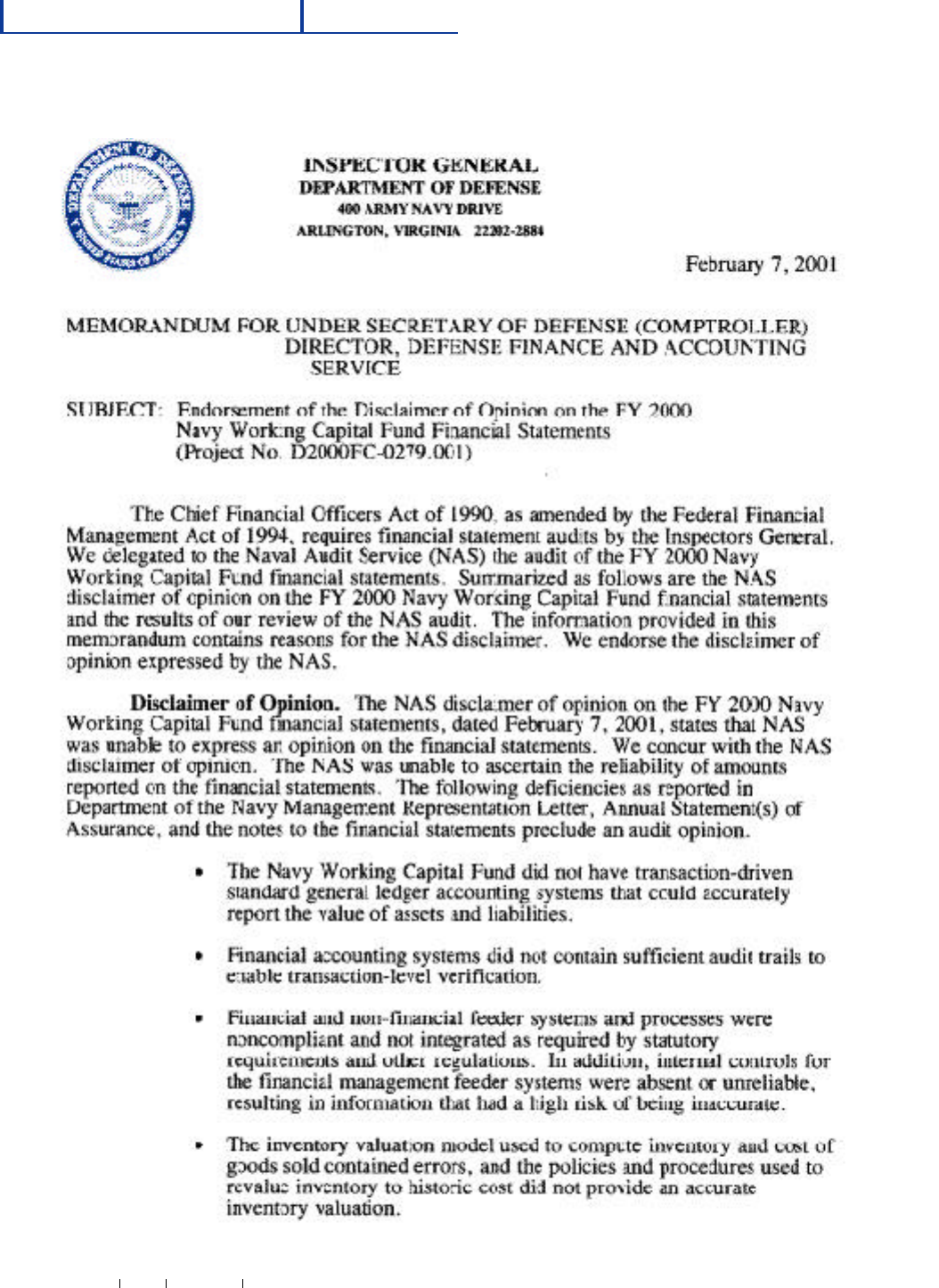
110
FY 2000
NAV Y WO R K I NG CA P I TA L FU N D
Audit Opinion
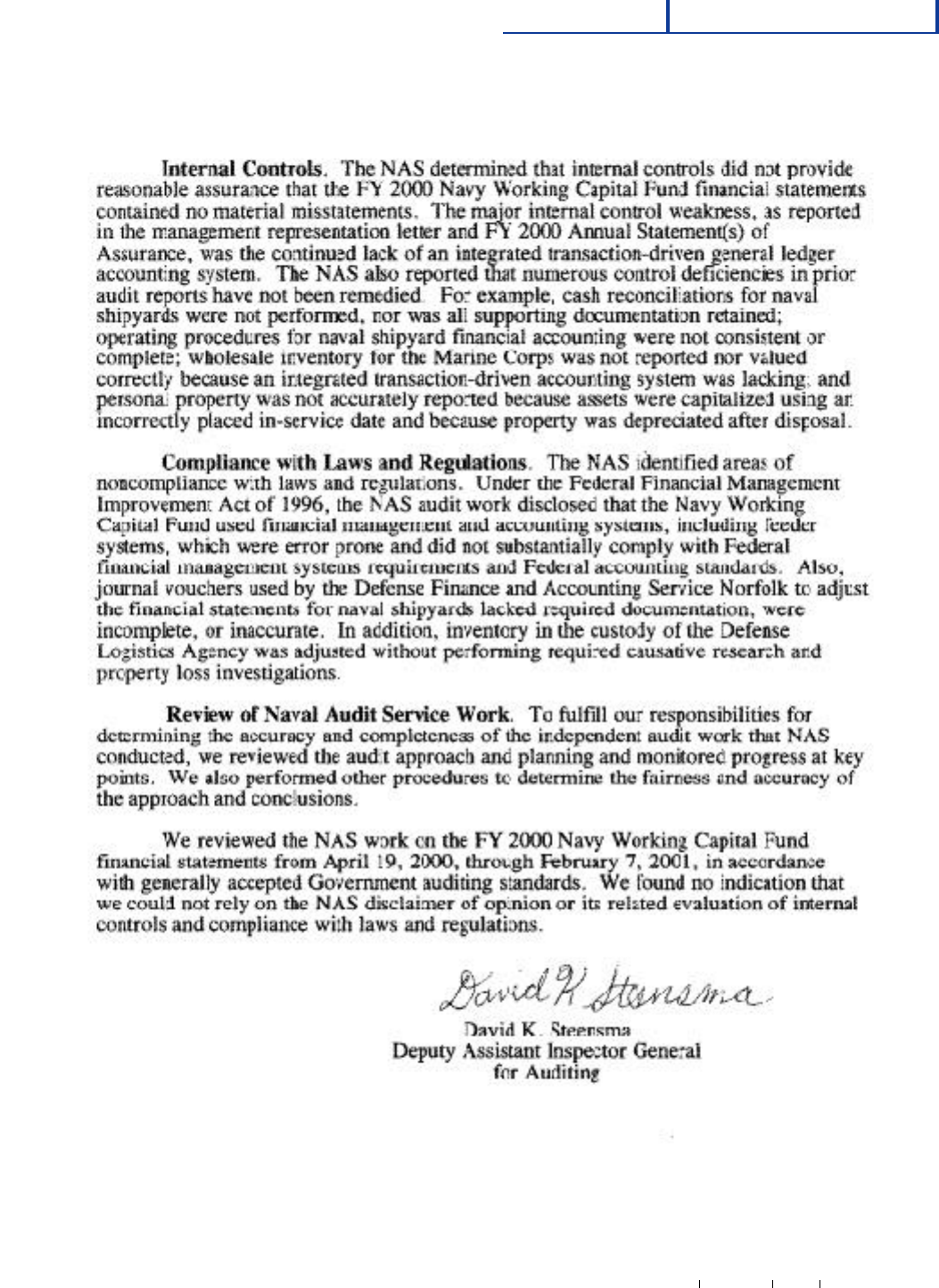
111
FY 2000
AN N UA L FI NA NC I A L RE P O RT
Audit Opinion
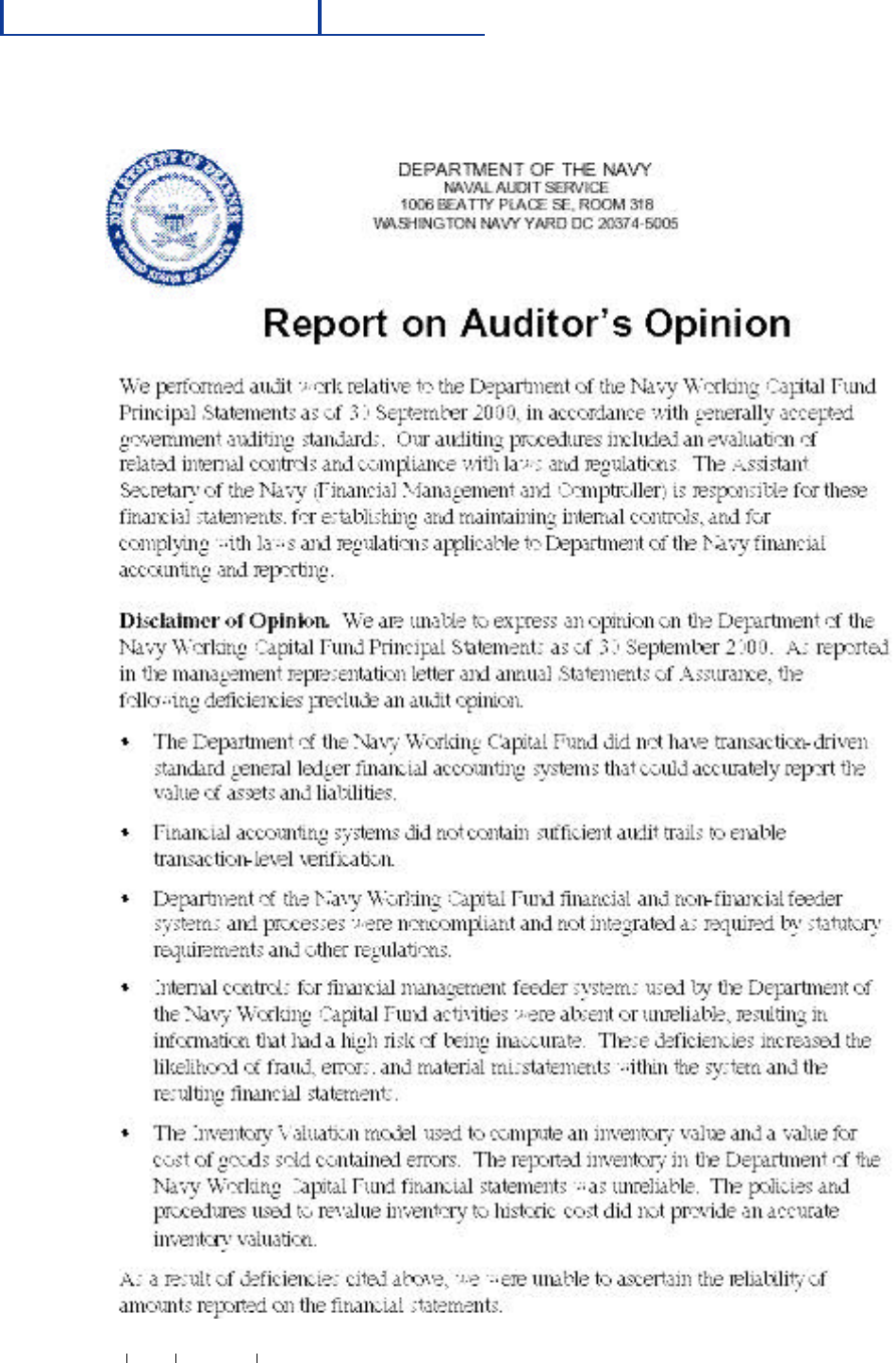
112
FY 2000
NAV Y WO R K I NG CA P I TA L FU N D
Audit Opinion
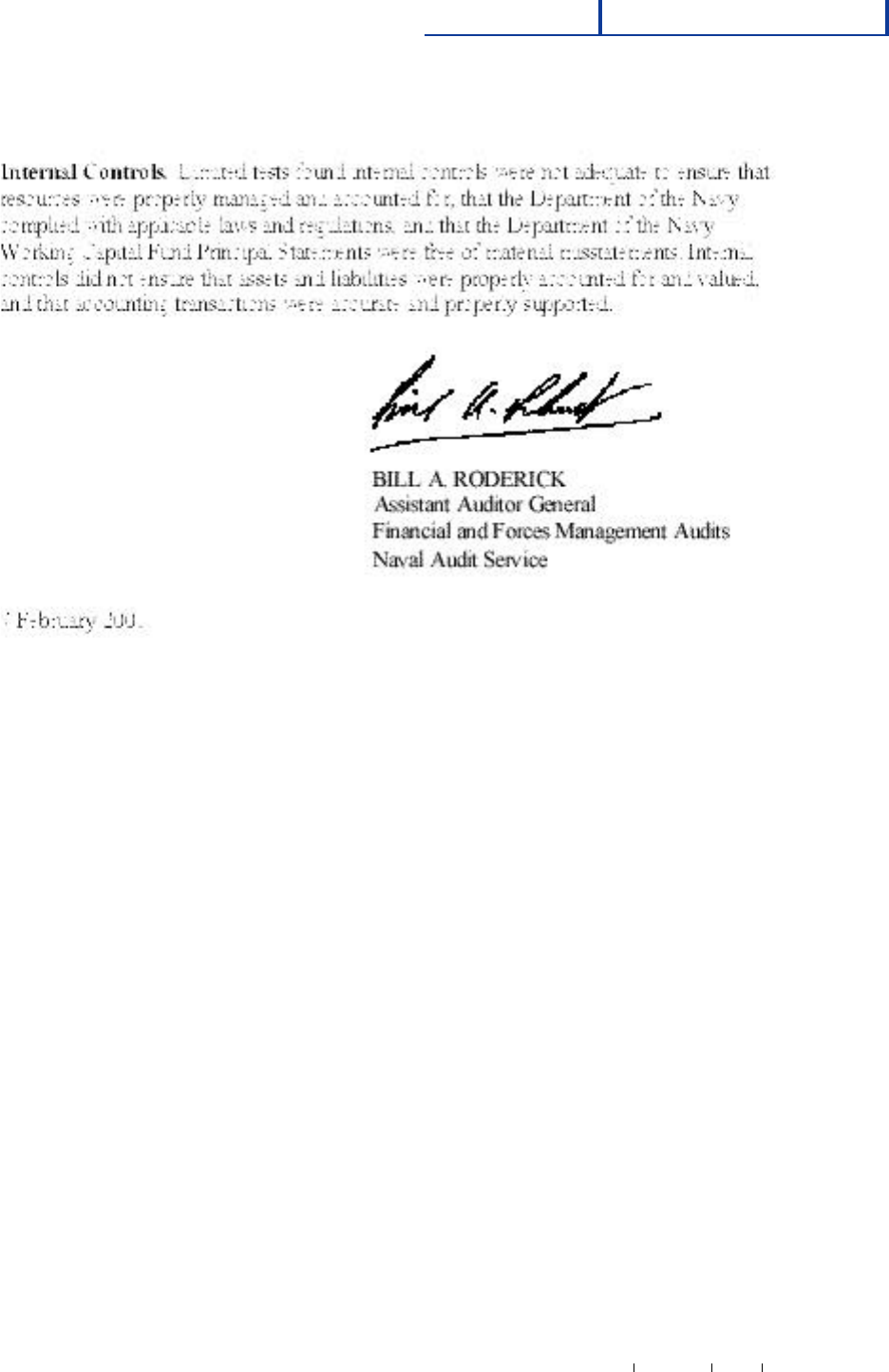
113
FY 2000
AN N UA L FI NA NC I A L RE P O RT
Audit Opinion
